SIBERIA
TUGUR’S PREHISTORIC TAIMEN
By Keith Rose-Innes


There’s truth in wanting to do something yourself if you want it done right. So we did. Our Boundary wader collection with GORE-TEX Pro Wader laminate sets a new standard. No heavy sell. No BS. We make gear all anglers can trust, 100% of the time, no exceptions.

MADE WITH



 Photo by Martin Ejler Olsen
Photo by Martin Ejler Olsen
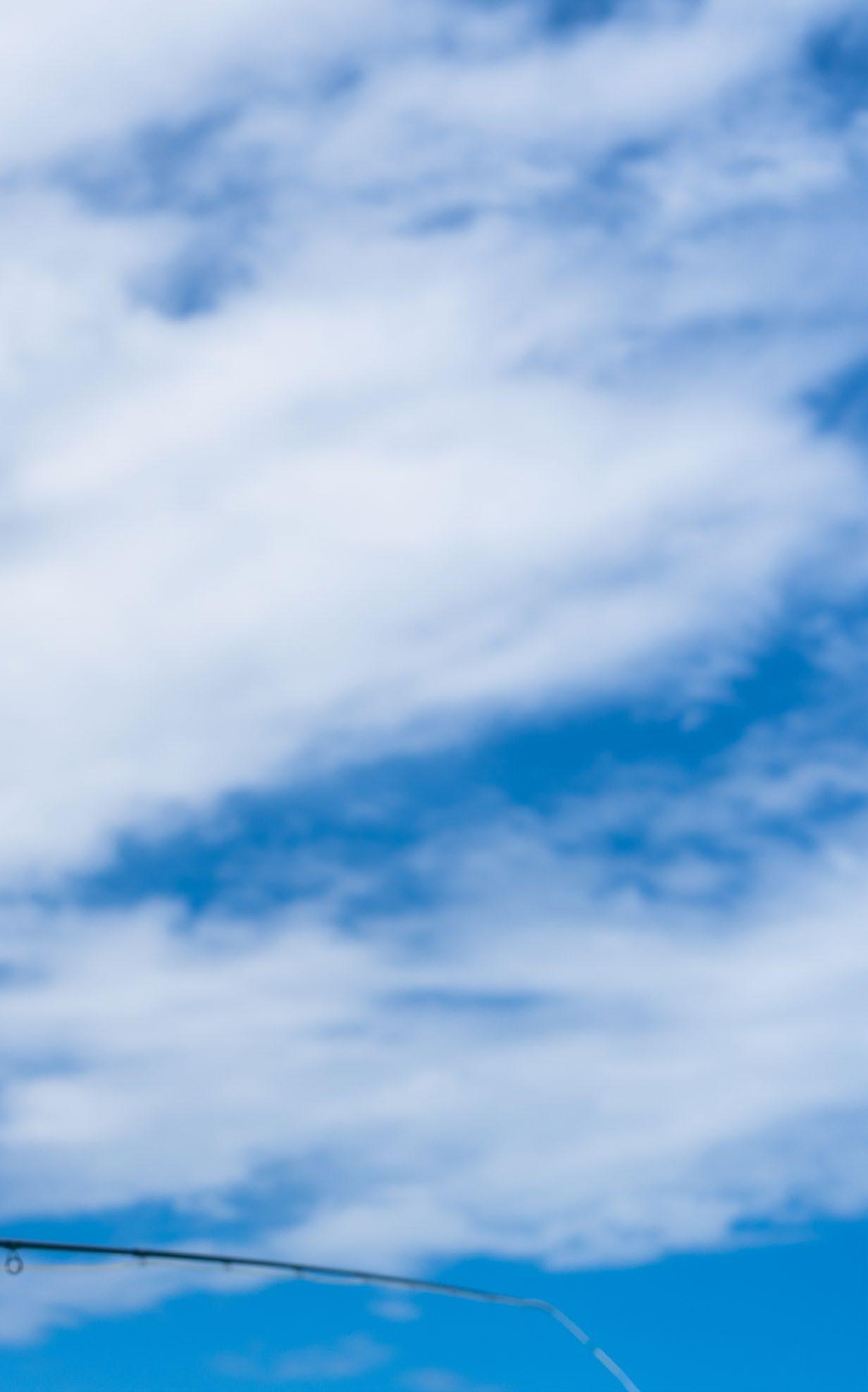
We haven’t booked a single day’s worth of salmon fishing this year. The returns last season were catastrophic, and it was depressing to fish these beautiful Scandinavian rivers that used to be teeming with fish. There isn’t much good news coming in. It’s mostly about escapee farmed salmon, sea lice pandemics, habitat loss, pollution, over-fishing, and perpetually declining salmon returns. But there are exceptions – like the Skjern River in Denmark – and it goes to show that when there is will, there is a way. Several organisations, volunteer groups, and fly fishing industry players work relentlessly to put pressure on politicians, industrial salmon farmers, and relevant interest groups to make the changes needed to revitalise and safeguard Atlantic salmon populations. Among them are NASF, Redd Villaksen, Norske Lakseelver, and Danmarks Center for Vildlaks.
Follow their accounts online, show your support, get involved, and let us join forces in protecting one of the most iconic anadromous fish on the planet. www.facebook.com/danmarkscenterforvildlaks www.instagram.com/reddvillaksen/ www.instagram.com/nasfund/ www.instagram.com/norskelakseelver/
 Photo by Martin Ejler Olsen
Photo by Martin Ejler Olsen

Taming the Aqua Hulk by Rasmus Ovesen
Tugur’s Pre-historic Taimen by Keith Rose-Innes
BAT BAT Territories by Felix Hansvencl
A Fly Anglers El Dorado by Eugene Pawlowski
Fly Fishing in the Heart of Africa by Emily Rodger
Chelatna Lake Lodge by Joseph Clark
And much much more...



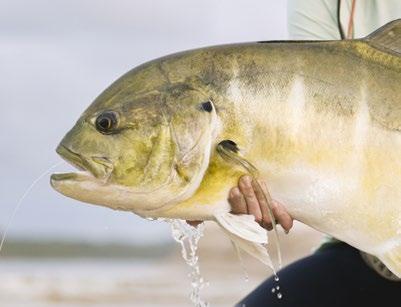


the Loop Magazine C/O Cast Away Media
Org no: 999 320 147 www.intheloopmag.com



We choose not to print this magazine and we are happy not to use paper and harmful inks as used in a conventional printing process.
No portion of this magazine may be reproduced without the written consent of the publisher.
RASMUS OVESEN
Oslo-resident, Rasmus Ovesen, was handed his first fly rod at the tender age of eight, and he has been a borderline fluff chucking fanatic ever since. Rasmus has written articles for some of the world’s most renowned fishing magazines, and his travels take him to re mote areas across the globe in search for fish that will test and challenge his skills to the maximum. He has seen his fair share of ex posed backing in the tropics, but his heart truly belongs to the soulful realm of trout and salmon fishing.

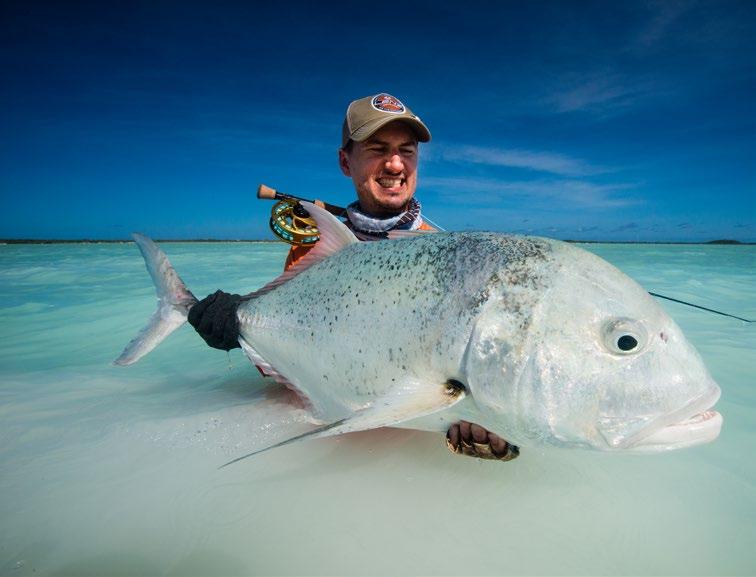

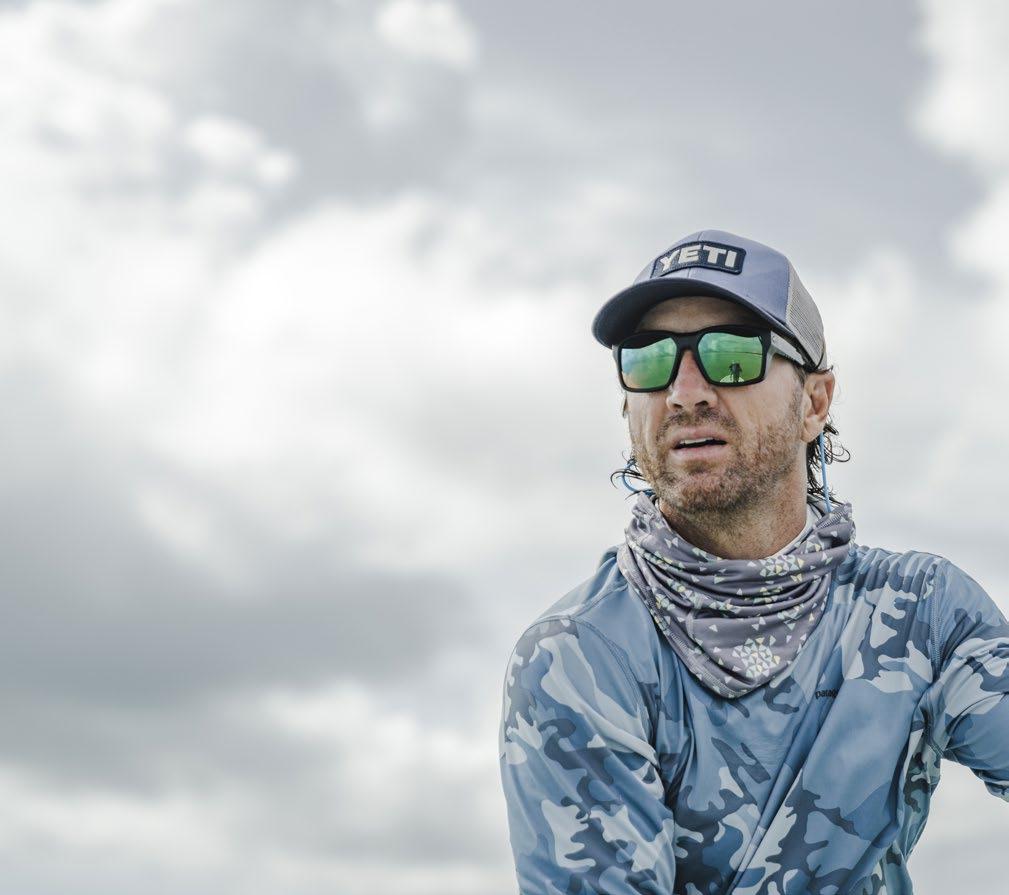
Felix started out in the sports in dustry, playing professional soc cer for Bundesliga clubs such as Eintracht Frankfurt as a young ster. After finishing his studies – a B.A. in International Sports Management and a B.A. in Inter national Business Administra tion – he was in charge of the In ternational Business operations for Eintracht Frankfurt. At the age of 25, Felix started doing hosted fly fishing trips to various destinations worldwide and - 5 years later - he decided to leave the sports industry and focus full-time on the destina tion angling sector. Since then he has worked as a travel agent as well as manager and guide for different lodges around the world, such as the Las Buitreras Lodge on the Rio Gallegos (Argentina). Photography plays a big role during his season and trips:
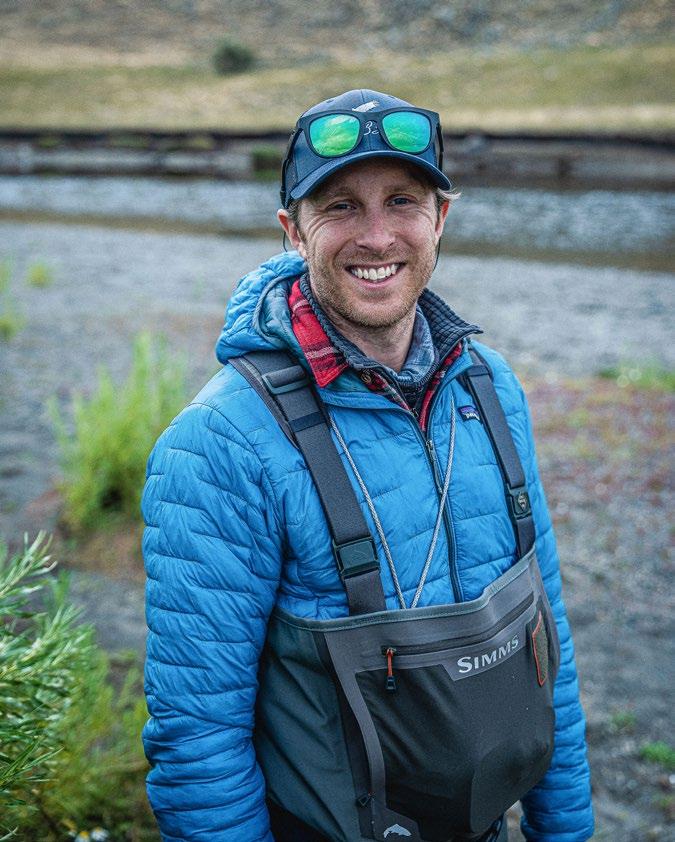
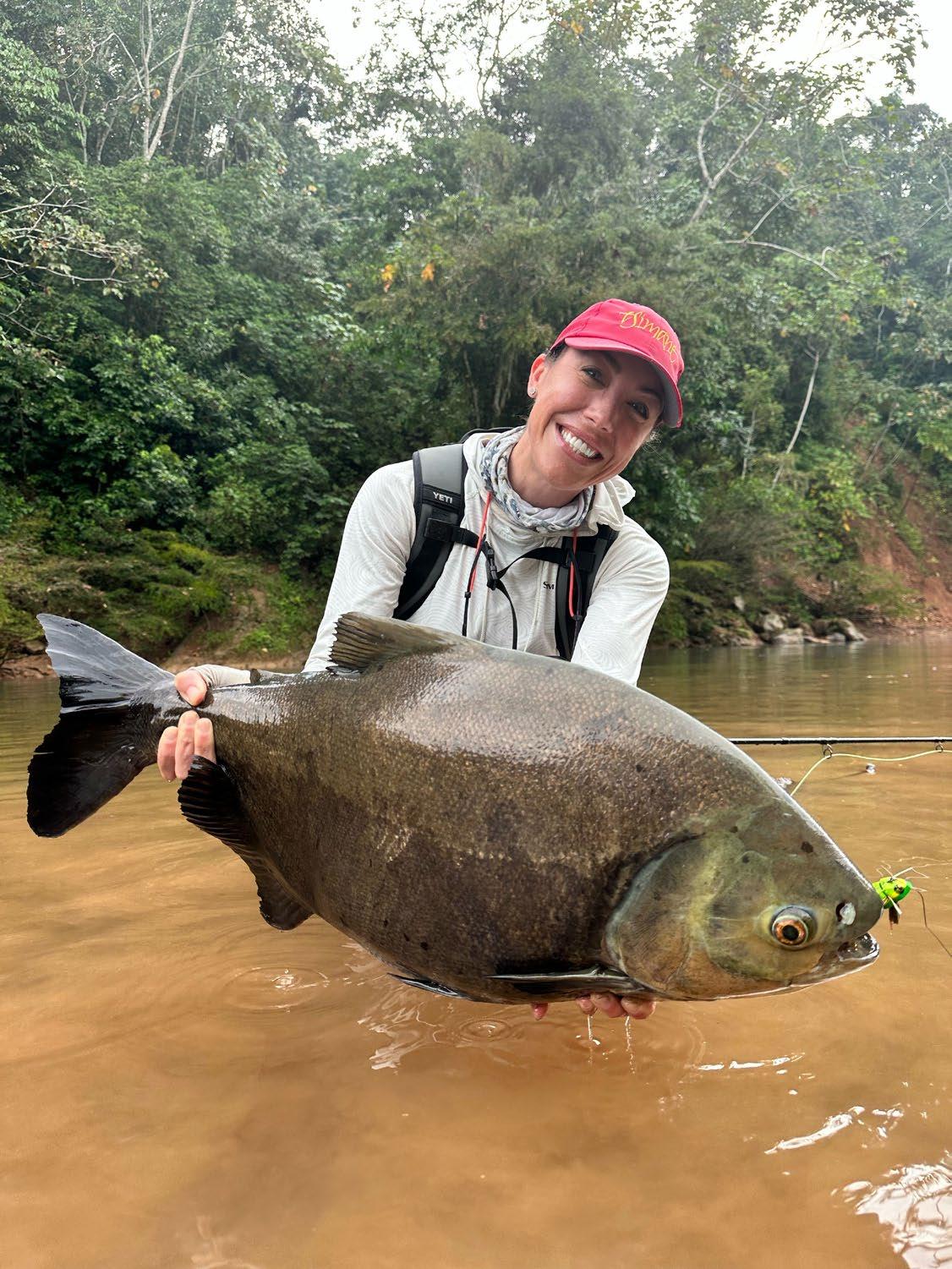


Born in England 1961, Barry is an internationally acclaimed and much published photographer and writer, including several photographs in the National portrait gallery collection in London. He is a regular contributor to numerous fishing magazines world wide. He has also written, co-written and contributed to more than 30 books about fly fishing and fly tying. He has won medals in some of the worlds most prestigious fly tying competitions, and for the past fifteen years he has worked as a consultant for the Mustad Hook Company. http://thefeatherbender.com/









The Indian Ocean is home to some of the most remote fly fishing destinations in the world. In this article, Rasmus Ovesen takes you to Farquhar Atoll – a fabled and far-flung atoll just north of Madagascar known for its incredible species diversity.
By: RASMUS OVESEN Photos by: RASMUS OVESEN and MARTIN EJLER OLSEN
A FREIGHT TRAIN! Fly line keeps peeling mercilessly off my fly reel at a most disturbing pace and the violent tugs, that continue to transplant themselves through my fly rod, constantly threaten to put me off balance. I’m in hot pursuit across uneven and craggy corals along Farquhar Atoll’s wind-swept outer reefs, where huge swells from the far horizons of the Indian Ocean crash deafeningly onto shore. To say it’s chaotic would be a gross understatement!
My mind is in a state of distress and alert; an overwhelming sense of immediate unreality has set ind, and there’s no processing capacity left for anything but the imminent task at hand – however desperate and hopeless it may seem. I’m connected to a mythological being whose powers seem to exceed mine. And it feels more like this supreme being has hooked me than the other way around.
The racing beats of my agitated heart pound vehemently in my temples. Sweat trickles relentlessly down my face. Lactic acid burns in my legs,
and I’m starting to run out of backing. And then – suddenly – the fish miraculously slows down. It seems it can no longer keep up with the rest of the startled school and, instead, it starts to thrash violently about in an attempt to liberate itself from the invisible pull. Perhaps this battle of the wills will eventually tip over to my advantage? Perhaps, I actually do stand a chance.
“My mind is in a state of distress and alert”
”This is perfect. You’ve broken his spirit!”, says the guide enthusiastically, as we finally start to catch up with the fish. It’s poised in a depression between coral bommies and shallow plateaus of turtle grass and is just sitting there with a scowling expression on its face – like some sort of Aqua Hulk. I’m dying to believe the guide, but I fear my opponent still has amble amounts of raw, chaotic power to unleash.
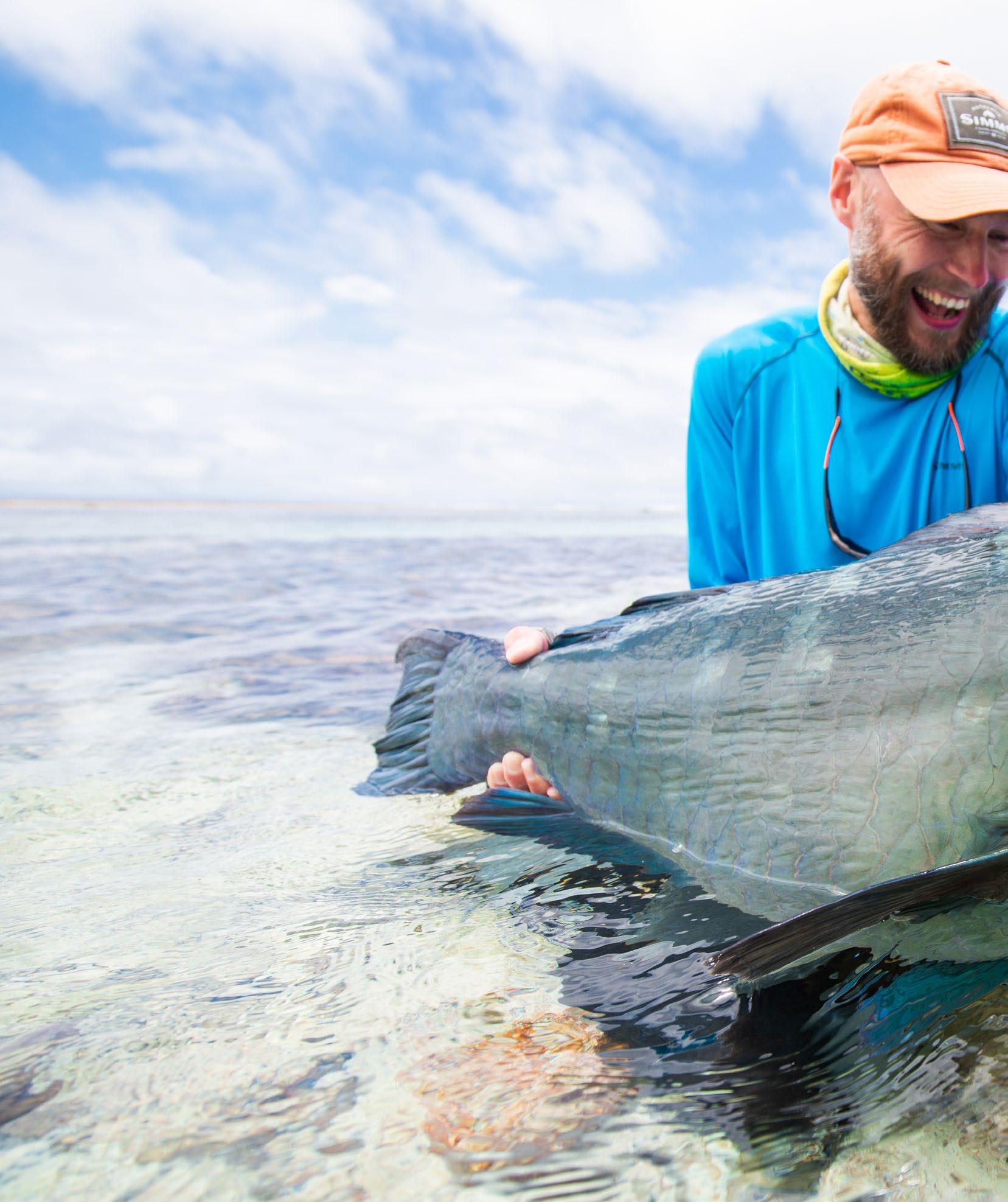

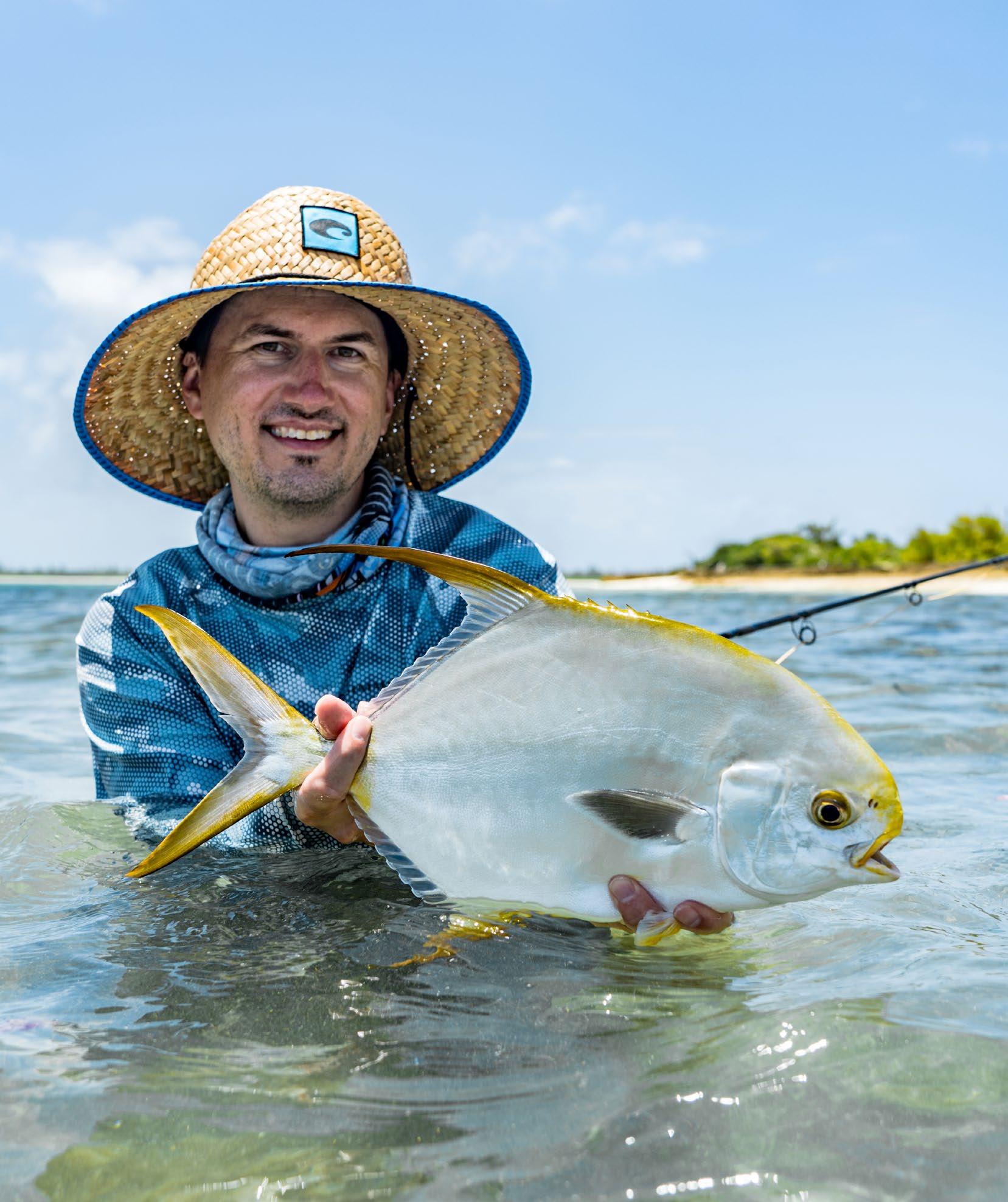


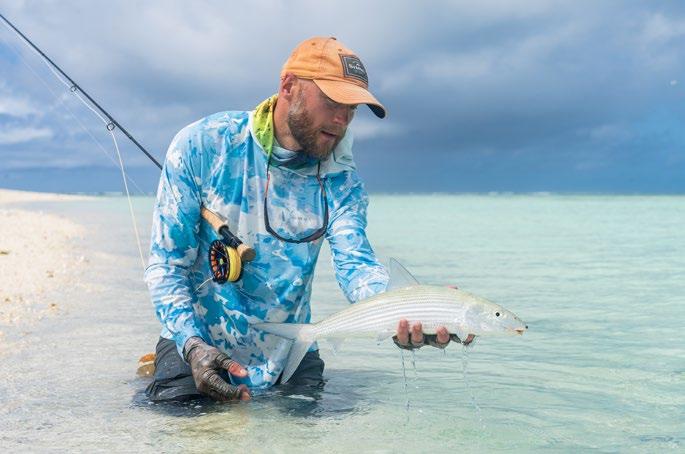


Underneath the waves, I see the distorted silhouette of the strange fish; its swelling metallic-green flanks, the bulging pink forehead, and its bolt cutter beak. Through a temporary window in the water surface, it’s as if our eyes briefly meet. Then, suddenly, the fish bursts into an abrupt trembling paroxysm, its jaws chattering convulsively. The water explodes and the connection is lost. The leader has been cut, the fish is gone, and a fast-dissipating crater-like whirl is all that’s left where it was. The piercing emptiness that I’m left with is unbearable.
It’s the third bumphead parrotfish that I’ve lost within an hour’s worth of hectic fishing, and I can’t stand anymore punishment right now. It’s time for something different? But what?
Farquhar Atoll is home to an acutely stress-provoking amount of exciting fish species. The species diversity here is staggering, and as a visiting fly fisherman it can be difficult to stay focused.


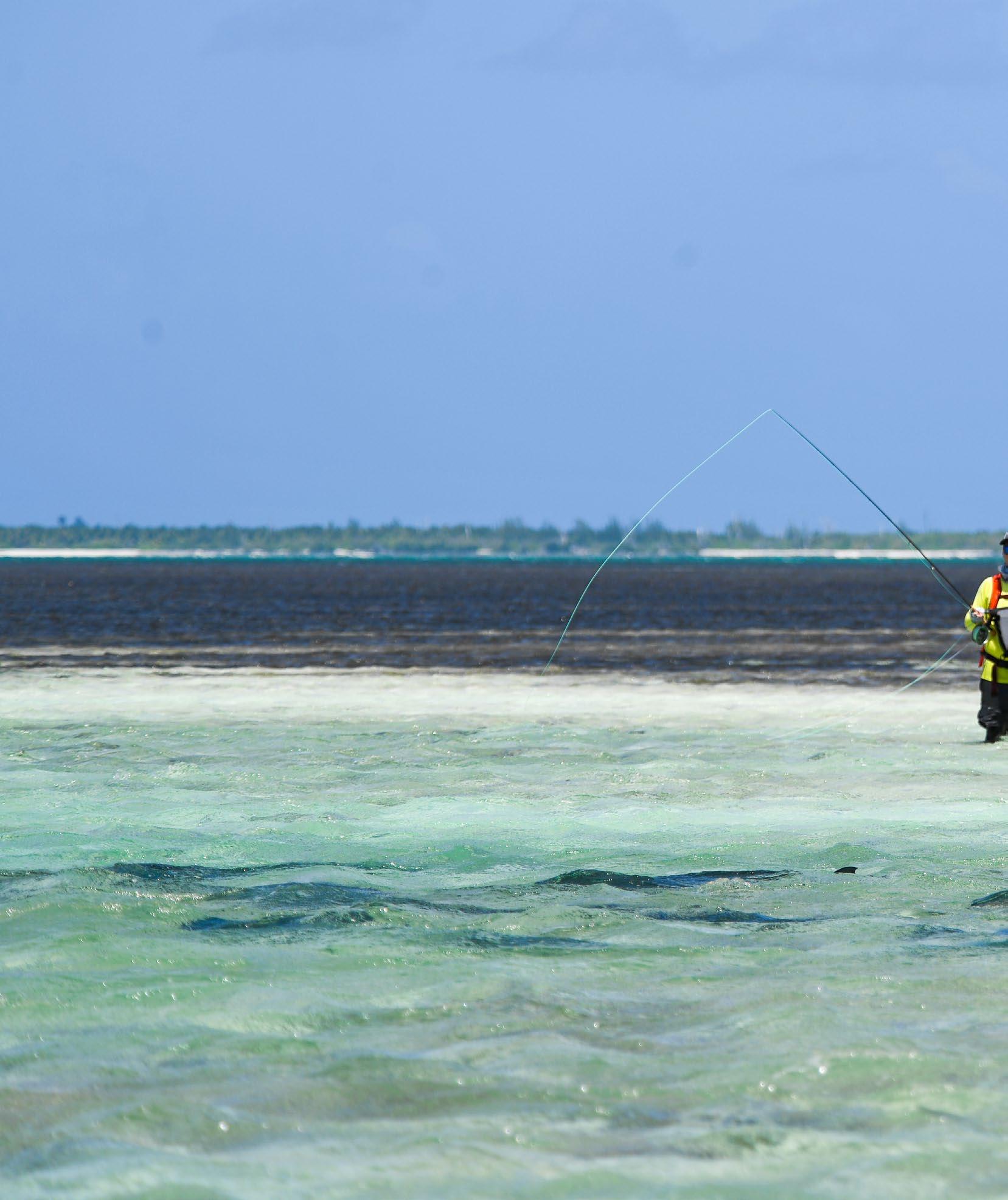
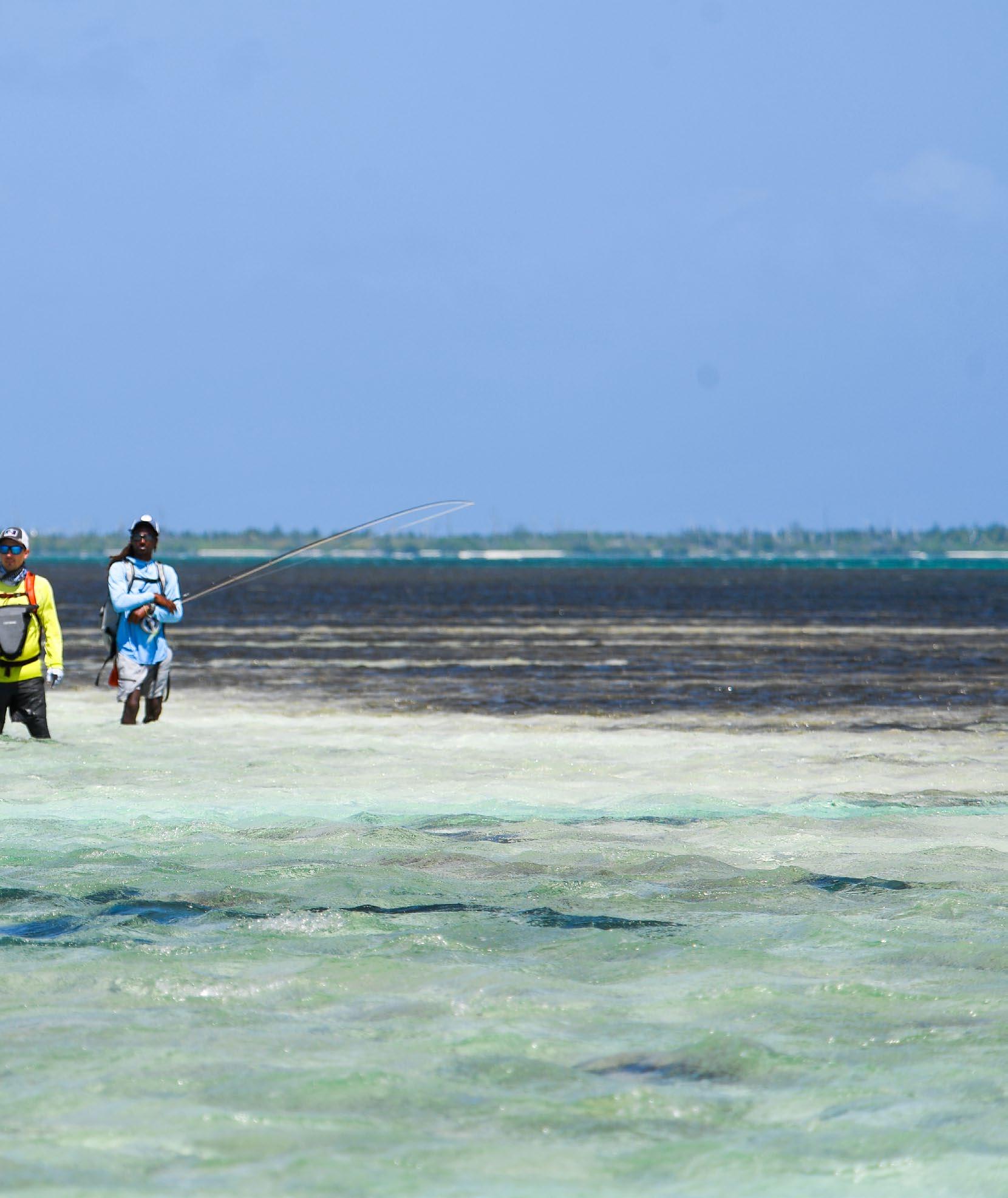

Every little microhabitat within- and along the atoll’s outer reefs houses its own, carefully adapted fish species, and when the weather permits and one heads offshore, countless bluewater species may be encountered. Most of the fish species are both incredibly powerful and strikingly beautiful. And they are challenging and fun to catch. Even so, only a select few of them are considered game fish worthy of being specifically targeted. On the flats, these are mainly giant trevally, bumphead parrotfish, bonefish, triggerfish, and Indo-pacific permit.
Atoll is a veritable Mecca. This is where the BBC documentary, ”The Blue Planet II”, in which giant trevally are seen charging out of the water and intercepting birds in mid-air - was filmed, and catching one on a popper at Goelette Island, with lots of black terns awhirl in the wind, is an experience, which – in and of itself – is worth the whole trip.
“Most of the fish species are both incredibly powerful and strikingly beautiful”
Bumphead parrotfish is, perhaps, the most immediately pressing and urgent species to catch at Farquhar Atoll. Populations have dramatically declined worldwide and there are now only a handful of atolls left where one can successfully fly fish for them. Farquhar Atoll is one of them. Here, you’ll find big schools of these grossly powerful and alien-like parrotfish as they come onto the reef edges and flats to chew-, crush- and derive nutrients from the corals that grow here.
For those, mostly preoccupied with catching the undisputed gangster of the flats – the giant trevally, Farquhar
Ever-present on Farquhar Atoll’s pearlescent sandy flats and beaches, whether in big schools of smaller fish or in small nervous groups of full-grown specimens, is the ‘ghost of the flats’: The bonefish.


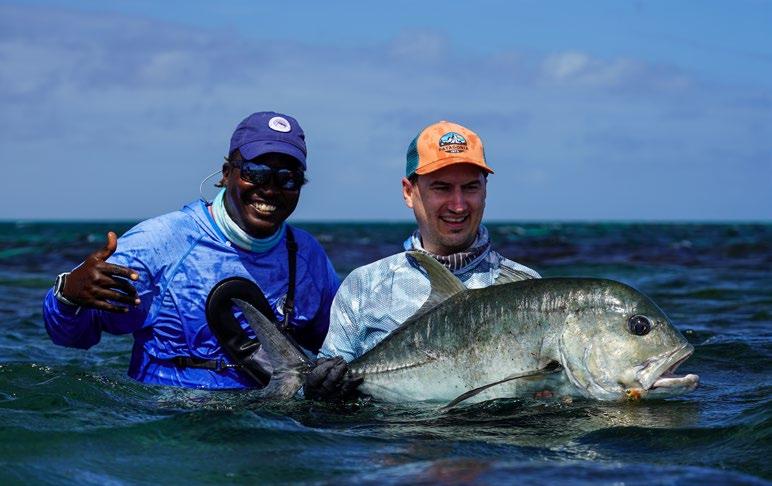
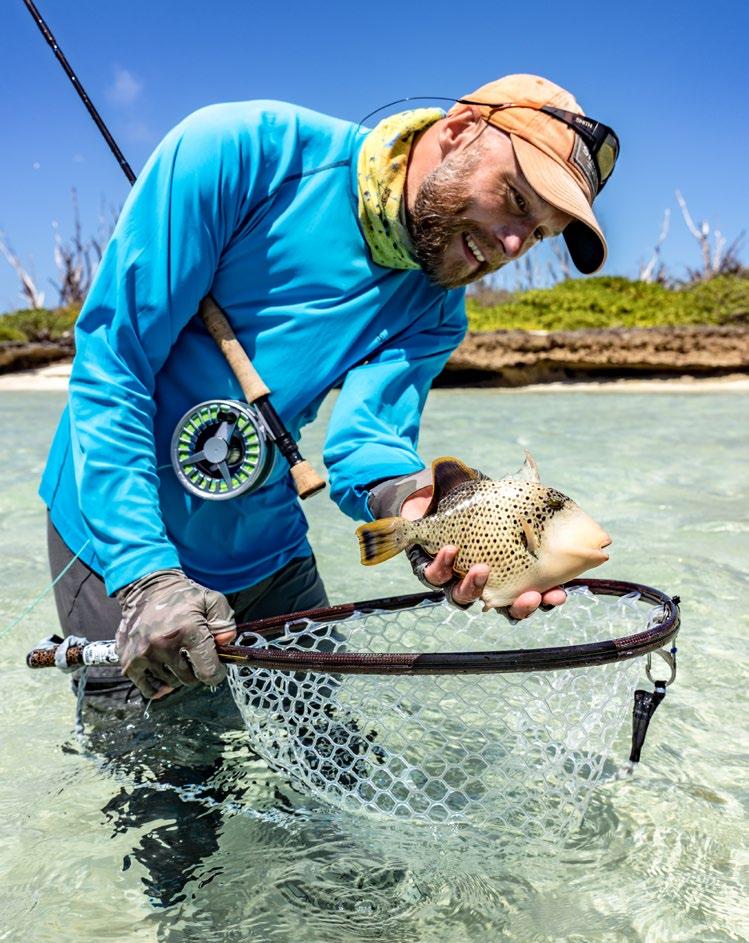




This formidable- but oftentimes overlooked gamefish is a high-octane and furiously paced adversary that is known for gentle takes followed by explosive runs. Anywhere else on this planet, bonefish are a prominent part of the main cast. On Farquhar, however, it’s more of a peripheral extra that doesn’t shine with its absence until you desperately need one to complete a flats- or grand slam.
Yellow-margin- and moustache triggerfish are found in shallow areas with a mixture of corals, turtle grass, and sand – typically along the outer reefs of Farquhar Atoll. These awkward-looking, gnarly, crab-eating fish are surprisingly well-camouflaged. However, at low tide, they are occasionally found waving their tails enticingly as they dig in the bottom for food.
Triggerfish are a species of fish in dire need of a psychologist. They are quite bi-polar; on the one hand incredibly territorial, aggressive, and ferocious, on the other hand extremely skittish, ambivalent, and
finicky. They also happen to pack a bite like few other fish, capable as they are, of completely demolishing hooks (or biting a finger clean off for that matter), and once you hook one, it’s likely to surge directly towards a coral bommie or similar and wedge itself under- or inside it using its “trigger”-shaped dorsal fin as a locking mechanism. It’s an interesting fish to say the least!
Permit are found on many of the same flats that house bonefish. These gilt-edged fish, that can turn even the most experienced fly fisherman with saltwater in his veins into a fumbling nerve-wreck, are among the most edgy and picky fish on the flats – and thus one of the most challenging to catch. They typically show up solitary or in small schools, and both technical skill and luck are required to lure one into striking. When it finally happens, you’re in for a long and arduous fight. Farquhar Atoll isn’t widely recognized as a permit destination but make no mistake! They are there in surprising numbers, and many of the fish are BIG!




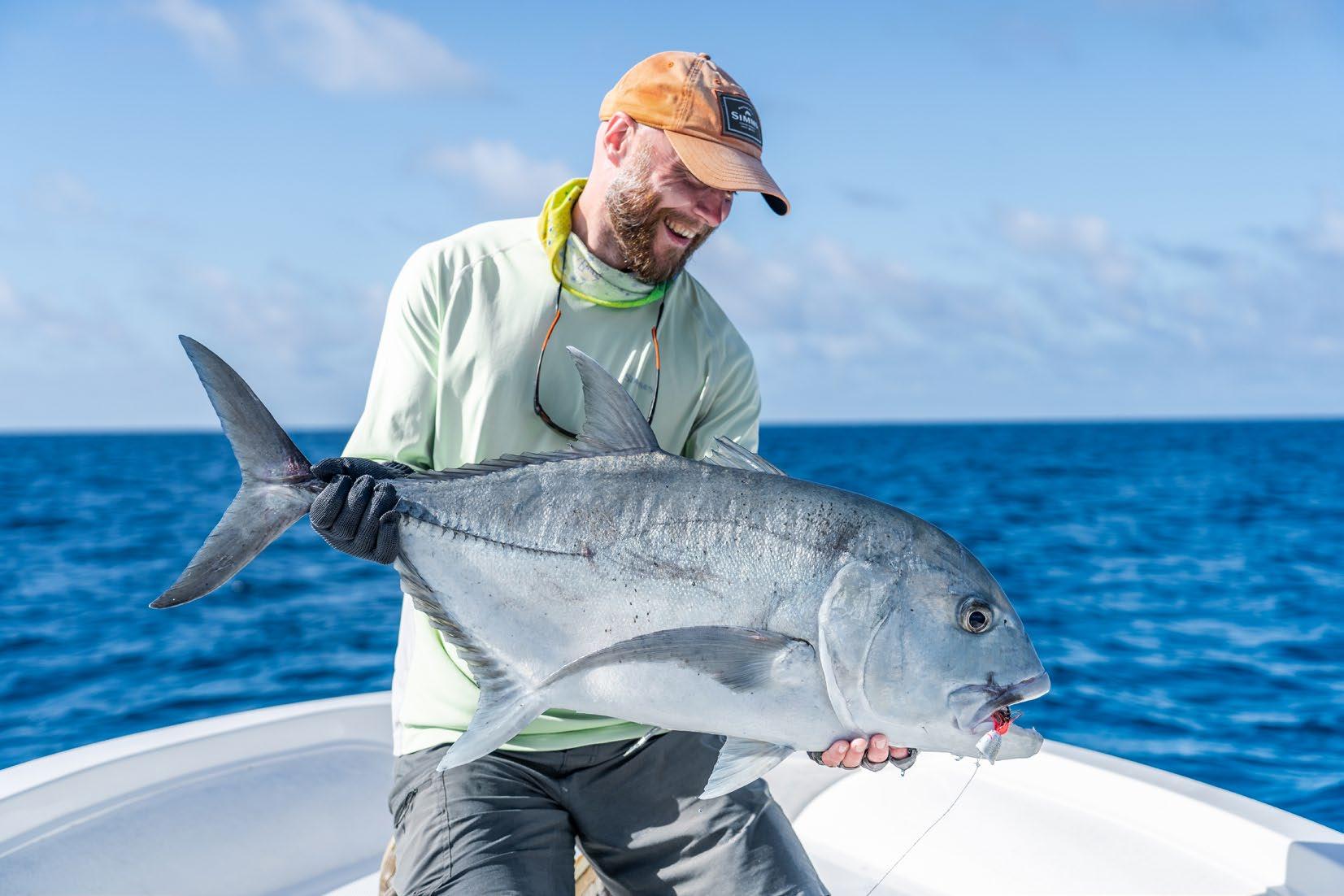
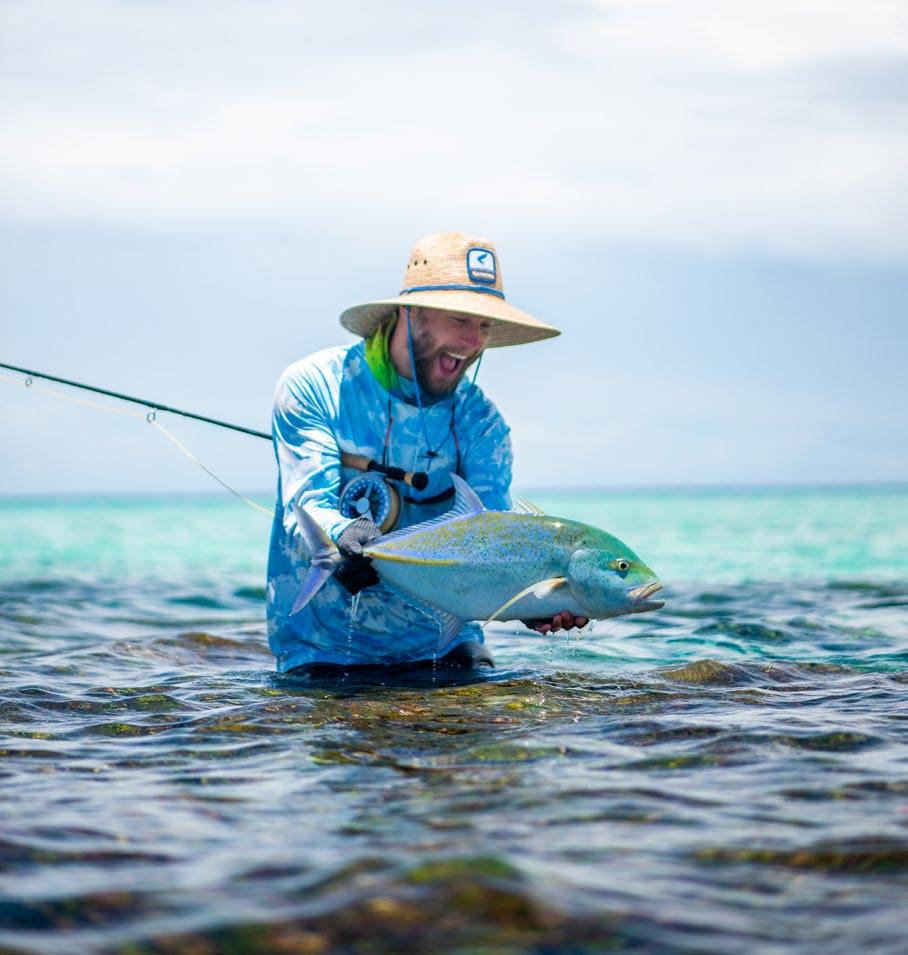



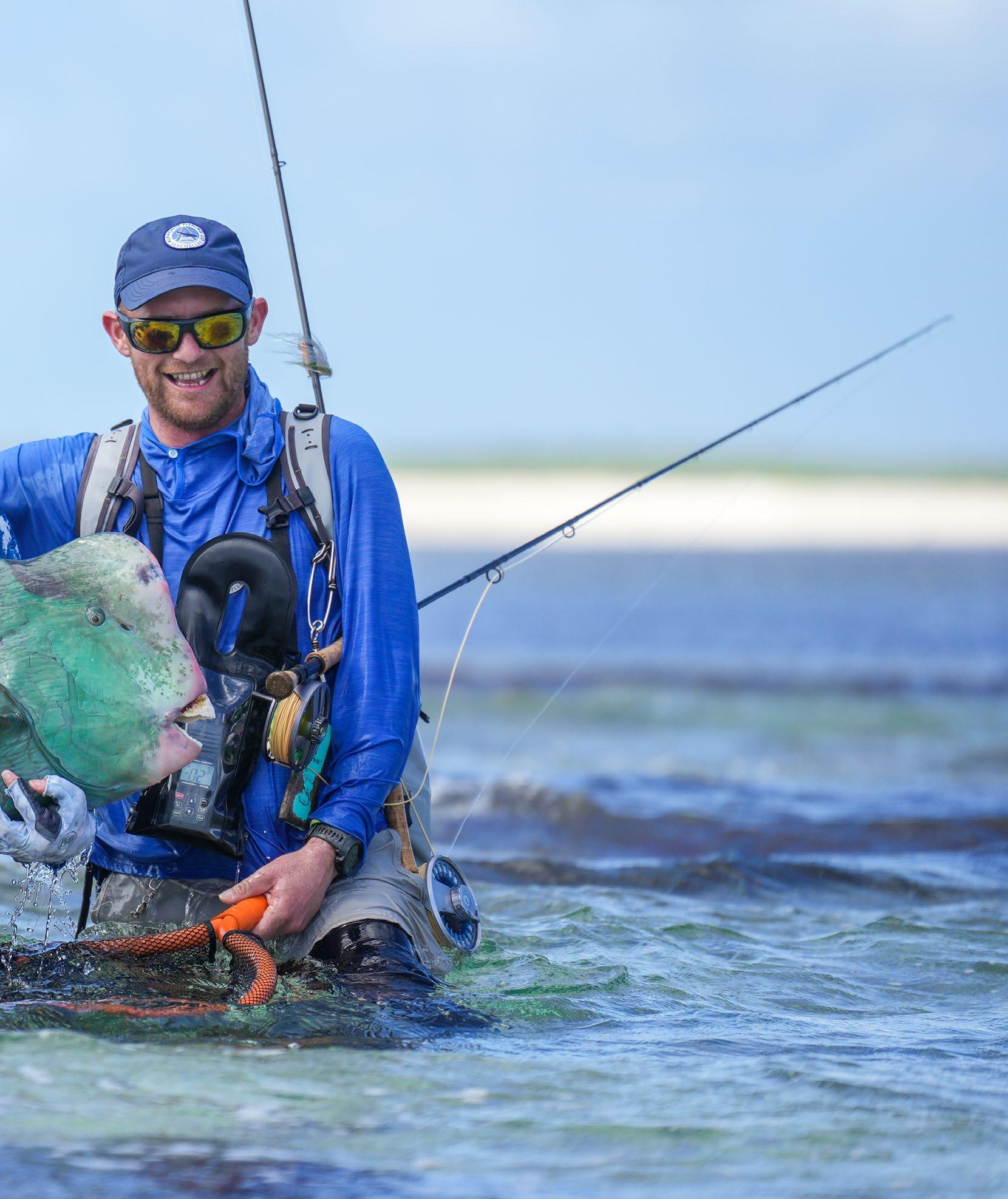


Do as the guide says!
One of my primary goals in traveling to Farquhar Atoll is to catch one of its signature fish; a bumphead parrotfish. However, I also know from experience that it can be counter-productive to be too myopically preoccupied with specific goals. And right now, my will is broken! I have completely lost all self-confidence, and highly doubt that it’s possible to land one of these maniacal fish on steroids.
The guide, Shaun Wampach, is ready to go. He has already mentioned, earlier on, that the best way to fish Farquhar Atoll is with an open mind; to simply let the tidal cycles and weather conditions decide where-, when-, and what to fish for. And if there’s one thing, I’ve learned throughout the years, it’s to do as the guide says. I therefore take him at his word, leave my destiny in his hands, and satisfy myself with at least having felt the power and savage temperament of a bumphead parrotfish. It’s time to look for new adventures –and it seems as if Shaun has already formulated a new game plan…
The tide has turned, and cool oceanic water has now started to flood across the outer reefs. We’ve relocated to the north-eastern part of the atoll where the conditions should be about right for giant trevally and sporadic triggerfish. What we’re met with, however, is something entirely different: Waving spade-like tails and massive blue-green shadows across shallow coral flats.
”Sorry mate. It seems we’re not quite done with the bumpies”, says Shaun, as he hands me my fly rod with a big grin on his face. I follow his orders with reluctance but find myself fully focused and ready a few moments later, as we come within casting range.
My first cast is right on the money: Just on the edge of the school. I keep contact with the fly, then feel a slight tautness and watch in awe as an area, the size of an uptown living room explodes in cascades of water. As a startled herd of buffaloes, the whole school now charges towards the edge of the reef, and I lean back and apply as much pressure as I possibly dare in
order to prevent the fish I’ve hooked from doing the same thing. This is make or break!
The next 10 minutes are chaotic and – for the most part – look completely hopeless. I barely manage to separate the fish I’ve hooked from the remainder of the school, but I haven’t yet come close to breaking its spirit. It thrashes angrily about somewhere out there –beyond meter-high waves that collide blindly against the edge of the reef –and I find myself in neck-deep water high-sticking the fish, trying to prevent it from cutting me off on coral bommies and random volcanic structure.
Fittingly, since he is to blame for this whole ordeal, Shaun now gets a workout of his own. With death defying determination, he jumps into the waves, wades, swims, and dives for the fish and – after being completely gone for a disturbingly long while – he finally washes up onto the reef drenched and short of breath, with a bleeding shin and a giant blue-green fish sticking out of his impossibly small landing net. Jubilant scenes now play out. My dream has come true!


The rest of the day, I feel liberated, without further expectations or nerves. A giant trevally reveals itself in the waves. I cast like a god into the wind, place the fly perfectly ahead of the fish, watch as the clearly agitated fish inhales the fly, strip-set the hook with raw power and proceed to land the fish with a firm and disciplinary hand. Like a boss!
“A giant trevally reveals itself in the waves”
Later, in the afternoon, a permit materializes on the back of a big stingray mudding for crustaceans on an expansive, pearlescent flat. I serve up a white Alphlexo Crab - dangling at the end of a 6-metre-long leader tapering into a 15lb tippet. The fish reacts immediately and follows the fly a couple of meters before an ever-so-subtle tug propagates through the line. I resist the temptation to lift the rod, continue stripping, and shortly after everything comes taught. Masterfully done!
The fish surges irresistible outwards and across the flat in an attempt to clear out the rest of my backing, but it doesn’t stand a chance. I take my time; play the fish patiently and use the rod to mitigate the many runs and abrupt pulls. Ultimately, Shaun is able to net a pristine-looking fish overstrewn with sparkly gold dust.
Seeing as we’re already on a big, gleaming flat, we might as well look for a bonefish. It takes shape like a faint ghost in milky water close to the shoreline, and I manage to place another perfect cast that instantly results in a take. Then a series of lightning-quick runs. Of course!
It isn’t until we wrap up for the day that Shaun confesses. For a long while, I have sat in the boat and watched as my friend and boat partner, Martin, has cast (to no avail) into a big school of permit that kept getting terrorized and spooked by a massive GT.
We’ve now relocated, and Shaun has commanded me to the casting platform in the front of the boat.
Less than half an hour remains of the day, and we’re spending it in a small, shallow bay that so far looks devoid of fish. Then, with less than five minutes left to fish, a full-grown yellow-margin triggerfish, suddenly emerges on top of a coral bommie –right in front of the boat.
I’ve already landed a trophy-sized titan triggerfish the day before, and – as a result – I’m only moderately disappointed when the fish, after having followed the fly over a short distance, spooks and disappears. I know all too well that this is the rule rather than the exception, and it doesn’t detract anything from an otherwise incredible day.
Shaun, on the other hand, seems a lot more affected. Shaken even. And it’s with a tone of disappointment in his voice that he announces that it’s time to pack up. ”That was so close!”, I hear him mutter in a whispering, resigned voice as he jumps down into the boat from his guide-platform in the back.
“It was just a triggerfish”; I casually note after having sorted my gear and prepared for the ride back to the lodge. Shaun looks up from the aft of the boat, stares back at me momentarily, and then breaks into a huge smile.



A golden grand slam?
We’ve been millimeters away from achieving something unique, Shaun now reveals. With the addition of a triggerfish, we would have landed a so-called “golden grand slam”. Allegedly, such an achievement has only been accomplished twice in Alphonse Fishing Company’s more than 25-year-long history, and it has never happened on Farquhar Atoll specifically. Shaun has even heard rumors that anyone who succeeds in landing a “super grand slam” wins a free trip, but this he can’t verify
Either way, I’m nowhere near landing a golden grand slam during the remainder of the trip. And it doesn’t matter. I fish with an open mind, gradually develop a deeper understanding of the atoll’s unique and diverse fishery – it’s rhythm and character. And in the process, I catch lots of fish.
Another fly fisherman will manage to land a golden grand slam on Farquhar Atoll some sweet day. It’s bound to happen – and I bet it will be one of those guests who comes with an open mind and does what his guide says.
Farquhar Atoll is named after the former governor of Mauritius, Robert Townsend Farquhar. Since the 1500s, the Atoll has been claimed by different colonial powers. However, from 1976 and onwards, it’s officially been part of the Seychelles. Geographically speaking, Farquhar Atoll is situated approximately 250 kilometers to the northeast of Madagascar in the Western corner of the Indian Ocean.
The largest atoll in the Seychelles with its 17800 hectares, Farquhar Atoll has been inhabited by a small group of fishermen and farmers since the 1850s. Today, the Island Conservation Society, has infrastructure and crew stationed on the atoll, and Alphonse Fishing Company has a full-catering lodge there, which was set up after the cyclone Fantala – the most powerful cyclone in Seychelles history – hit the atoll in April 2016.
Further information about the lodge, which hosts 10 fly fishing guests in individual en suite apartments, can be found here: www.alphonsefishingco.com


If you’re planning to fish Farquhar Atoll with an open mind, it’s a good idea to bring both light and heavy tackle. For bonefish and permit, a 9’ 8-weight rod is optimal, while a 9’ 10-weight is perfectly suited for triggerfish and bumphead parrotfish. For giant trevally, even heavier equipment is required. 9’ 12-weights are usually the preferred choice to tame these supernaturally powerful fish. (And you might consider bringing a 15-weight setup for bluewater fishing for dogtooth tuna, sailfish, and the likes).
The fly reels should be saltwater-resistant, fitted with strong and smooth drag systems with immense stopping-power, and capable of storing 150 – 200 yards of backing. In terms of giant trevally, both the backing and fly line should have a breaking strength of about 100lbs – and the same goes for the leaders, which typically consist of 6 – 8 feet of straight nylon. Floating WF-lines such as Scientific Anglers’ Amplitude Grand Slam and Big Water Taper are among the top-choices for the Farquhar fishery.
Be sure to have all three set-ups rigged and ready at all times, as you never know what’s going to show up next on the flats.



Traveling to Farquhar Atoll takes at least two days and includes an overnight stay in Mahe: The capitol of the Seychelles. From Mahe, you’ll continue onwards via the IDC Hangar just south of the international airport on a flight arranged by Alphonse Fishing Co. The flight takes about three hours and typically involves a short stopover on Alphonse Island.
In Mahe, the waterfront Eden Bleu Hotel is highly recommended (www.edenbleu.com), and if you’d like to experience a bit of what Mahe has to offer – either before or after your trip to Farquhar Atoll, there is lots of inspiration and info to be found on the official Tourism Board of the Seychelles: https://seychelles.com/home
Bumphead parrotfish (Bolbometopon muricatum) is the largest member of the parrotfish family. It can reach lengths of up to 1,5 meters and weigh more than 150lbs, and it is distributed across the Equatorial parts of the Indian Ocean and certain areas of the Pacific Ocean.
Bumphead parrotfish can live for more than 40 years, and since they’re slow-growing shoaling fish that don’t reach sexual maturity until the age of 5 – 8 years, they’re extremely vulnerable to over-harvesting.
The beak, which is so characteristic for the bumphead parrotfish, consists of fluorapatite, which is among the hardest biominerals in the world, harder than copper, silver, and gold.
The fish use their beaks to chew corals, which they then churn, digest, and filter for nourishment.
The pink hump is thought to play a role in relation to certain hierarchy rituals. In these rituals, individual fish test their strength against other dominant members of a school by frontally colliding into each other – a bit like bighorn rams on land.
Another interesting fact is that bumphead parrotfish are protogynous hermaphrodites and therefore capable of changing gender. The dominant alpha male in a school is usually a female that has changed gender.
We’ve had the privilige of traveling to some of the world’s premiere fly fishing destinations. Now, it’s your turn! Browse Destinations









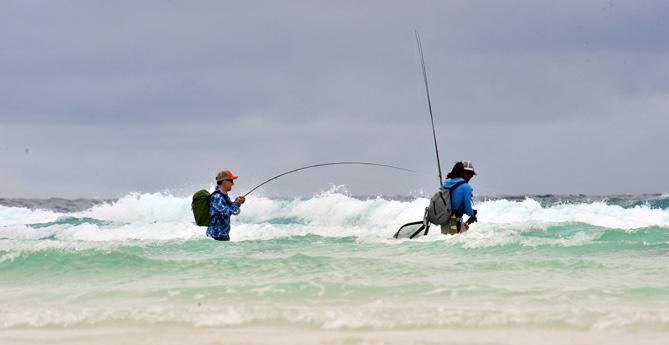



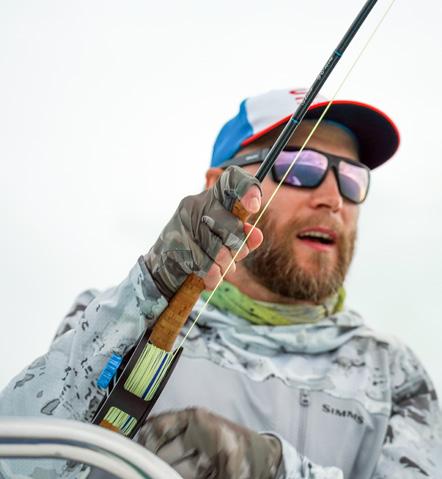








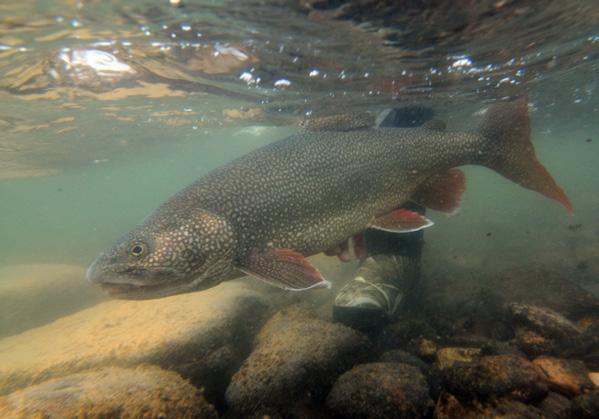




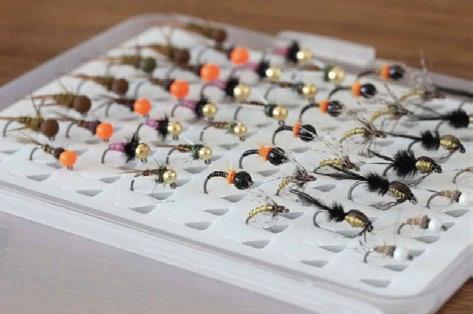












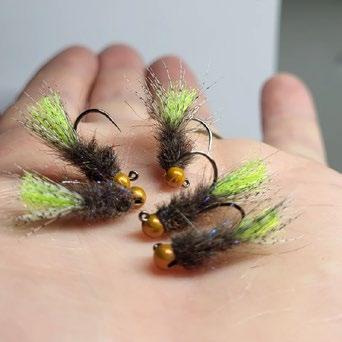








Hucho Taimen can reach six feet in length and weigh more than one hundred and fifty pounds. Just those two statistics tell you all you need to know about why Ilya Sherbovich and, to a lesser extent I, have spent the better part of two decades searching for these incredible pre-historic salmonids.
 By: KEITH ROSE-INNES
Photos by SERJ TSAPLIN and KEITH ROSE-INNES
By: KEITH ROSE-INNES
Photos by SERJ TSAPLIN and KEITH ROSE-INNES

Ilya, the proprietor of the Ponoi River Company, developed a fascination for taimen following a journey to North-Eastern Siberia in July 2002. Two years later, I entered the scene. While stationed along the Ponoi River in the Kola Peninsula, Ilya extended an invitation to join his upcoming major expedition. Little did we anticipate that this would mark the inception of a 17-year pursuit of taimen, taking us as far as south-eastern Russia in the quest for that elusive colossal taimen. It’s been an odyssey characterized by extensive research and local folklore as we endeavoured to pinpoint which rivers – out of hundreds of thousands – might potentially harbour giant taimen.
Historically, taimen inhabited a vast territory spanning from European Russia (the Volga and Pechora River basins) over 6000km to the east (Yana River and Amur River basins). Although they are no longer as abundant or widespread as in the past, Russia still boasts a taimen habitat encompassing over 10 million square kilometres, focusing on all river and stream environments with consistent
flowing currents. Typically, taimen migrate from larger, deeper rivers to smaller, shallower streams. We considered all of these factors in our pursuit, along with the usual variables such as weather and the guesswork of water levels, which can only be assessed upon reaching the river. The phrase “a needle in a haystack” would be an understatement, and perhaps too daunting a challenge if we were not constantly mindful of these statistics.
Working his way through the haystack over the last 17 years, after significant research and exclusions, Ilya has organized expeditions to fish the Lena, Dyanyshka, Menkere, Undyulug, Dzhardzhan, Kuranakh-Siktyakh, Uel-Siktyakh, Muna, Natara, Sobolokh-Mayan, Eekit, Besyuke, Olenyok, Keimyar, Pur, Kharbusonka, Bytantai, Tugur, Konin, Koninikan, Munikan, Ulgi, Bytantai, Kharbusonka and quite a few rivers we might just keep to ourselves. The biggest challenge with Siberian taimen exploration is logistics, and to cover the above-mentioned list of rivers,


Ilya would require and solicit the use of various logistical solutions of gargantuan proportions. This includes an incredibly skilled Ponoi team who had to mobilize our group of anglers for 118 days of fishing, over 11 trips in those 17 years.
My induction into this amazing adventure kicked off in 2005 with the charter of a former Soviet plane en route to Tiksi. This town is one of the furthermost northern settlements in the world situated on the northern coast of Yakutia, in the Arctic Circle, and perched on the shores of the stormy Laptev Sea. Two MI8 helicopters whisked us away and over the immense Lena River delta that has its source in the northern Central Siberian plain, from where it flows northeast before emptying into the Laptev Sea. As we flew upstream on the Lena and over to the upper reaches of Olenyok river, for most of us I think it was the first of many reality check moments as it dawned on us how vast Siberia is and how challenging the search was going to be. We sat silent, each man spellbound by the great green tundra carpets of
lichen and moss cut by an incomprehensible amount of water that slowly dissipates into majestic clear rivers just waiting to be fished.
During that 2005 excursion, we dedicated two weeks to exploring various tributaries of the Lena and Olenyok rivers. Drifting downstream on rafts, we navigated tumbling waters and glided over a silver-dappled paradise, methodically fishing each pool, and absorbing the river’s breathtaking beauty.
Describing the spoils and magnificence of this region would be an endless endeavor; at every turn, there lay a different rapid or pool that evoked images of distant locales around the world.
The pinnacle of our journey occurred when Ilya’s boat stumbled upon a pool nestled in a tributary of the Lena teeming with fish. It was here that he and I had our inaugural encounter with a sizable taimen. Ilya successfully landed a fish weighing 39 lbs 10 oz, earning him the IGFA 20lb tippet class fly-fishing record.





While this was one of many taimen caught during the trip, what resonated most profoundly with each of us was the intense sense of humility we experienced immersing ourselves in the splendor of Siberia’s natural world. This encounter ignited within us a fervent desire to explore even more of Siberia in our pursuit of the elusive monster taimen.
In 2014, Ilya started hearing about the massive taimen that were said to live in a remote watershed 500 miles northwest of the city of Khabarovsk, deep in the Russian Far East, on the rivers of Konin and Tugur.
The first trip to Tugur in October of 2014 resulted in nothing big being caught after seven days of fishing in water conditions that would seem perfect to encourage big taimen to feed. Rather than a story of success, we enjoyed a week of vigorous casting, split fingers and stiff backs.
A normal person would without question give up the hunt, taking into account the amount of days spent casting huge flies into hundreds of Siberian rivers resulting in not a single take on most of those days. The proof of the taimen monsters’ existence was however there to see as the owner of the Konin lodge Mr. Alexander Abramov had a bunch of framed pictures on the wall of massive taimen that had been caught using conventional methods.
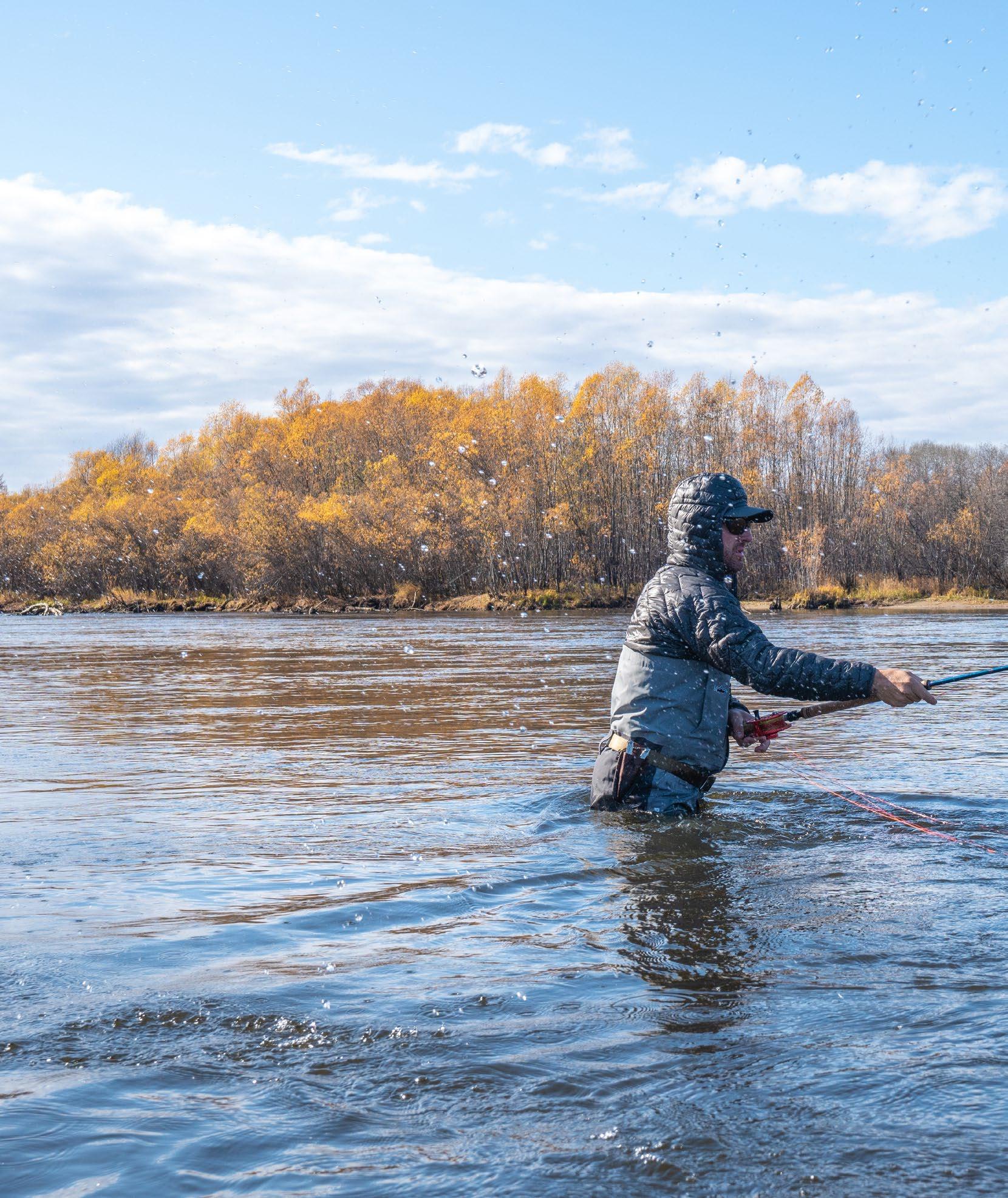

Inspired by the photos seen at the Tugur and following an invite from Abramov, Ilya was back in 2015. The days quickly flew by with not a single fish hooked or landed and it would seem no amount of good luck, skill, and effort would prevail. A bit of bad luck did the opposite and a belt of cold weather had set in cancelling the helicopter flight out, which gave Ilya another day’s grace.
“We knew there was a possibility of catching a taimen over 100lbs”
Snow and sleet couldn’t hold him back from one more attempt. And then it happened. Ilya hooked and landed the first 30kg plus hucho taimen. It was a pivotal moment that we would all come to acknowledge at a later stage emphatically announced that these monsters can in fact be caught on fly. This amazing fish was large enough to be awarded the IGFA 20lb tippet record weighing in at a massive 30.4kg’s.
The Konin and Tugur rivers had proven that this was the place to do it. Always keen to go bigger, we knew there was a possibility of catching a taimen over 100lbs.
Old Russian folk tales suggest that the Lena River system holds fish up to 200lbs, which meant that Ilya wasn’t finished with this area, and a year later the team was re-assembled and we were back re-exploring. This time we did everything on a larger scale so that no stone would be left unturned. It was a trip that would extend over 15 days and 11 rivers. We experienced rivers in flood, rivers in prime condition with no taimen and finally a river full of incredible numbers of taimen. The most impressive fishing was in the same section of river we had fished 11 years earlier with very little success, which sparked another reality check. A key lesson learned is that you can’t rule out rivers previously fished with no success, as these fish migrate in numbers causing them to stack up in pools rather than spread out through the whole system.








The trip resulted in some incredible taimen fishing with a large portion caught on mouse patterns, but still we failed to find a monster. Never mind that as a group we had only achieved the 30kg mark once after fishing 29 rivers on 8 trips over 14 years. By that time, it became obvious that the Tugur-Konin system was the place to do it. So, in 2019 we came back for another crack at it. The saying that difficult rivers are synonymous with big fish is certainly the case with the Tugur and Konin as the banks are lined with logjams and fallen trees.
Some sections are impenetrable with highly stacked trees and a labyrinth of channels, others only navigable after a lengthy chainsaw session. The rivers meander at a steady pace but never too fast, there are no rapids and large rocky areas to define any distinctive lies. The riverbed comprises mostly sand, gravel and small rocks raising the question as to why these big fish would choose these sections of river in the first place. Local taimen grow large enough to feed on and engulf an entire adult salmon. These rivers enjoy strong runs of chum salmon,
which is the main source of sustenance for these massive fish.
Unbeknown to us this trip was to be vastly different. We fished the same water, but with improved tackle and refined techniques and this time a big fish was caught almost on a daily basis.
Why had they been so difficult to catch? - and why hadn’t we been successful on the occasions we fished there before? Could it be that the reason we failed before was that they are active for a short period of time and with food readily available they feed heavily and then enter into a catatonic state while digesting? Is it a matter of being in the right section of river just as the salmon arrive allowing you the opportunity to fish for these monsters before they have gorged themselves? Was the metamorphosis of fly patterns playing a role as it’s likely that your fly competes with a fresh, full-sized salmon every time it’s in an area that holds a taimen? At that stage the specifics were irrelevant as each 30kg plus fish accompanied a flurry of celebratory vodkas.


Time flew by and soon it was the last day of an already successful week. We were heading an hour and a half downstream to an area I had fished unsuccessfully on the first day. I can’t explain how relaxed I felt without a single bit of pressure to catch another fish. It had been a week of incredible proportions as I had held several great fish up to 35,5kgs (78lbs) and witnessed our other group members catch taimen exceeding 30kg. Being content with the trip and set on enjoying the last day, I took my time, messed around with some huge fly combinations to make sure I would get down and the fish would see it, took some photos, and started fishing just after 11am. The sun had come out making the experience even more enjoyable until my third cast came to an abrupt stop and the line was wrenched through my fingers breaking the 30lbs maxima tippet, leaving behind two burnt train tracks on my index and forefinger. “Shit!”



I had been broken off by a big taimen and following the trend of the previous days I expected that to be the only action I would have for the day. I messed around with some more fly combinations trying to match what I had broken off, took some more photos, and had a vodka or two to drown my sorrows before starting fishing again.
A few casts later I was hooked up again and minutes later we landed a fin perfect fish of 31kgs (68lbs). We collected all measurements needed for the scientific data records and took some close-up photo of the right cheek as all taimen have unique markings.
Out of the corner of my eye, to my amazement I saw the vast stretch of glassy water started showing distinctive light bow waves which I initially mistook for a wind line. A few minutes later the same thing but this time it was definitely a fish. The fish were hunting in the pool which is something I thought I would never see! A few casts later I was hooked up again.
We landed a similar size fish, weighing over 30kgs, took photos and released the amazing creature. I was overwhelmed with a feeling of both gratitude and guilty gluttony that exceeded any will to continue fishing. We continued to watch the pool for a while and noticed a few fish roll on the other side of the river that supported a cut bank packed with fallen trees.
The chase became more intense and visible as glassy water flowed out over the shallow tail of this massive pool making it easier for the fish to hunt. My guilt trip subsided just enough for another chance to catch one of these waking fish that seemed to be larger than what I had caught so far.
We ottered the boat out by cleating it to the side handle making just enough casting space. I made a short cast and then a full one into the area I had seen the movement. The fly swung momentarily before I was hooked up to a fish that behaved completely differently to the others, as it headed downstream at a rate of knots.
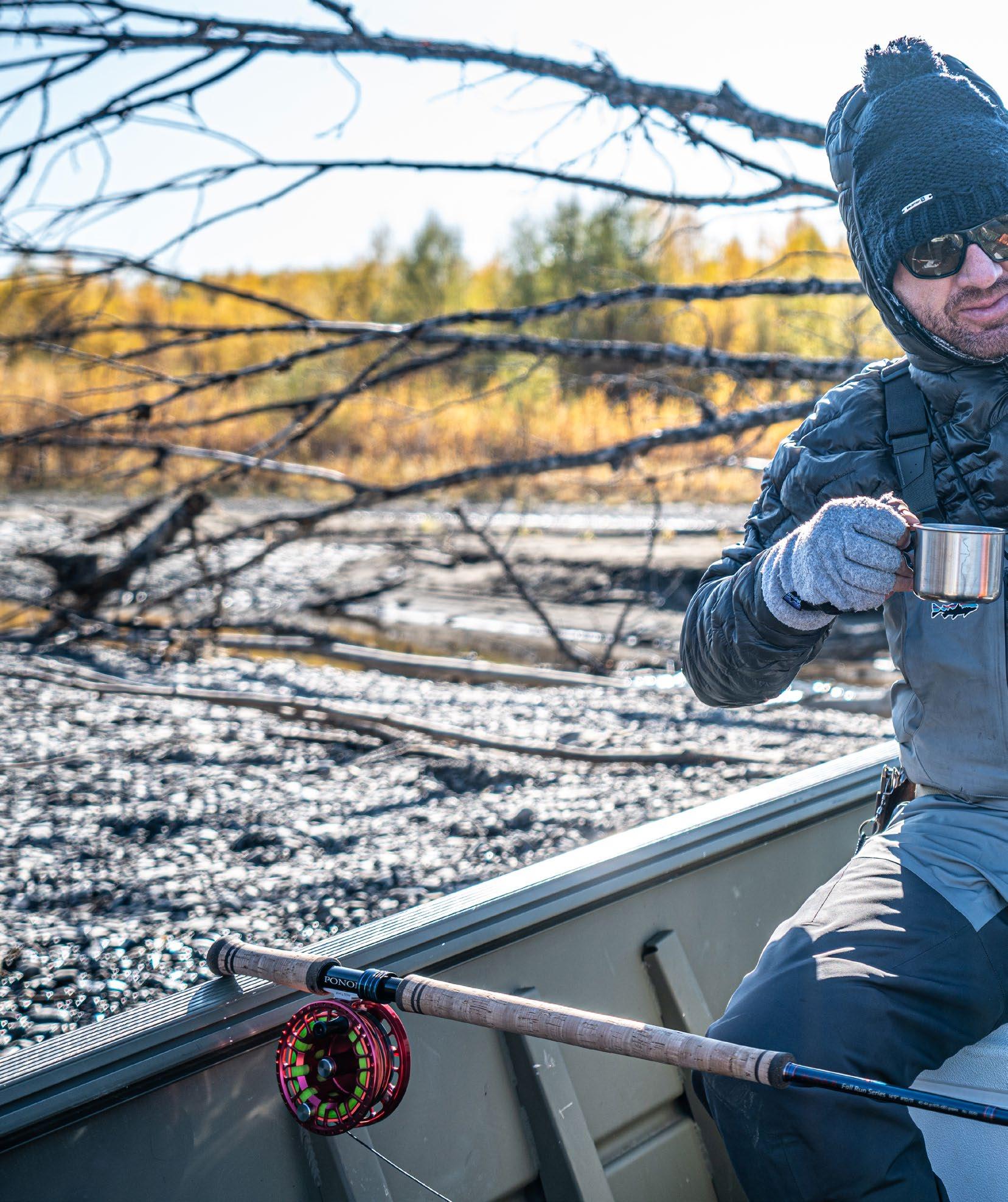

We dropped anchor and drifted out of the pool before using the motor to get to the opposite bank where we could pursue the fish on foot. I could feel this fish was much bigger as the head shakes were more violent and the runs longer.
Fifteen minutes later I had my first glimpse of it as Sergei, my guide, swept with the net. On his first attempt, he managed to get half the fish into the net. With a couple more jerks the fish was gently massaged as far as it could go into the net, which was three quarters. It was so long that 30 cm of its tail had to remain out of the weigh sling. It measured 159 cm, with a girth of 76cm and weighed in at 109 lbs.
Wet with the fish’s explosive departure I was officially done. How could you finish on a better note? Marking the end of my fishing for the week, I cut my fly off and saved it to place in a framed picture. Shell shocked with disbelief at what had just happened, we went back up to collect the anchor and while untying watched more giant fish hunt for a while before heading back to the lodge. On arrival I could see that I wasn’t the only one who had had an experience beyond expectations. My room-mate Steve Estella was also grinning from ear to ear. He had also caught a real monster measuring 153cm, with a girth of 78cm, weighing close to 100lbs.
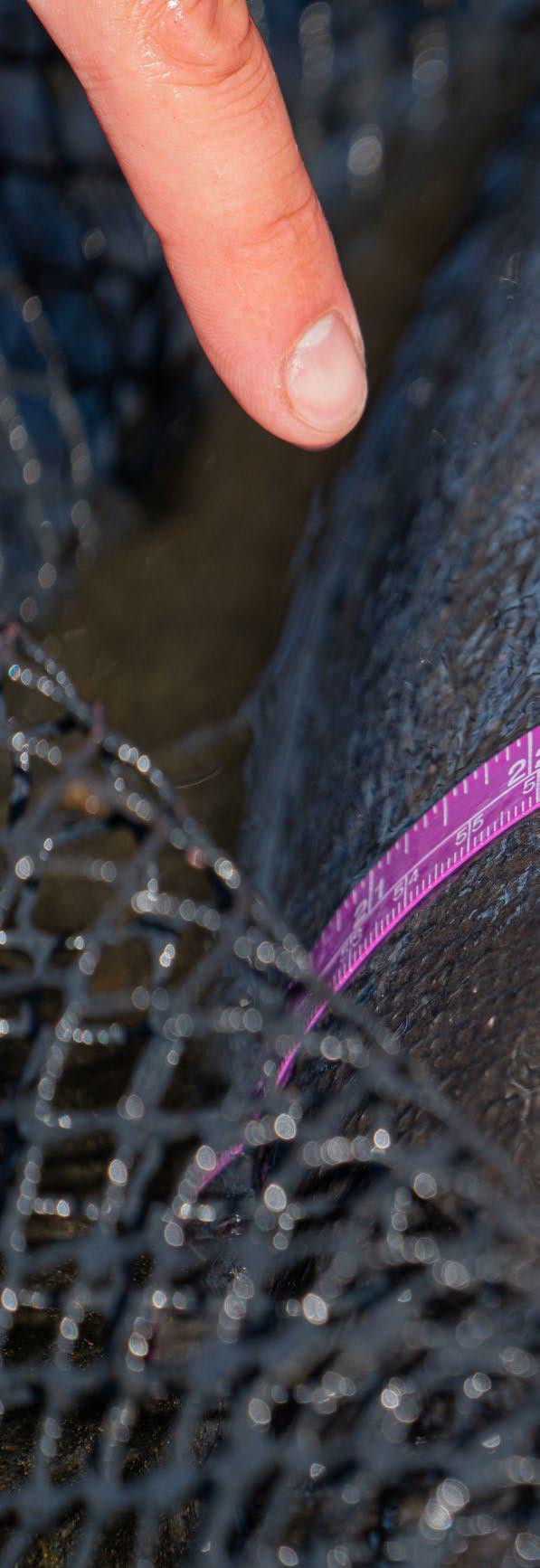
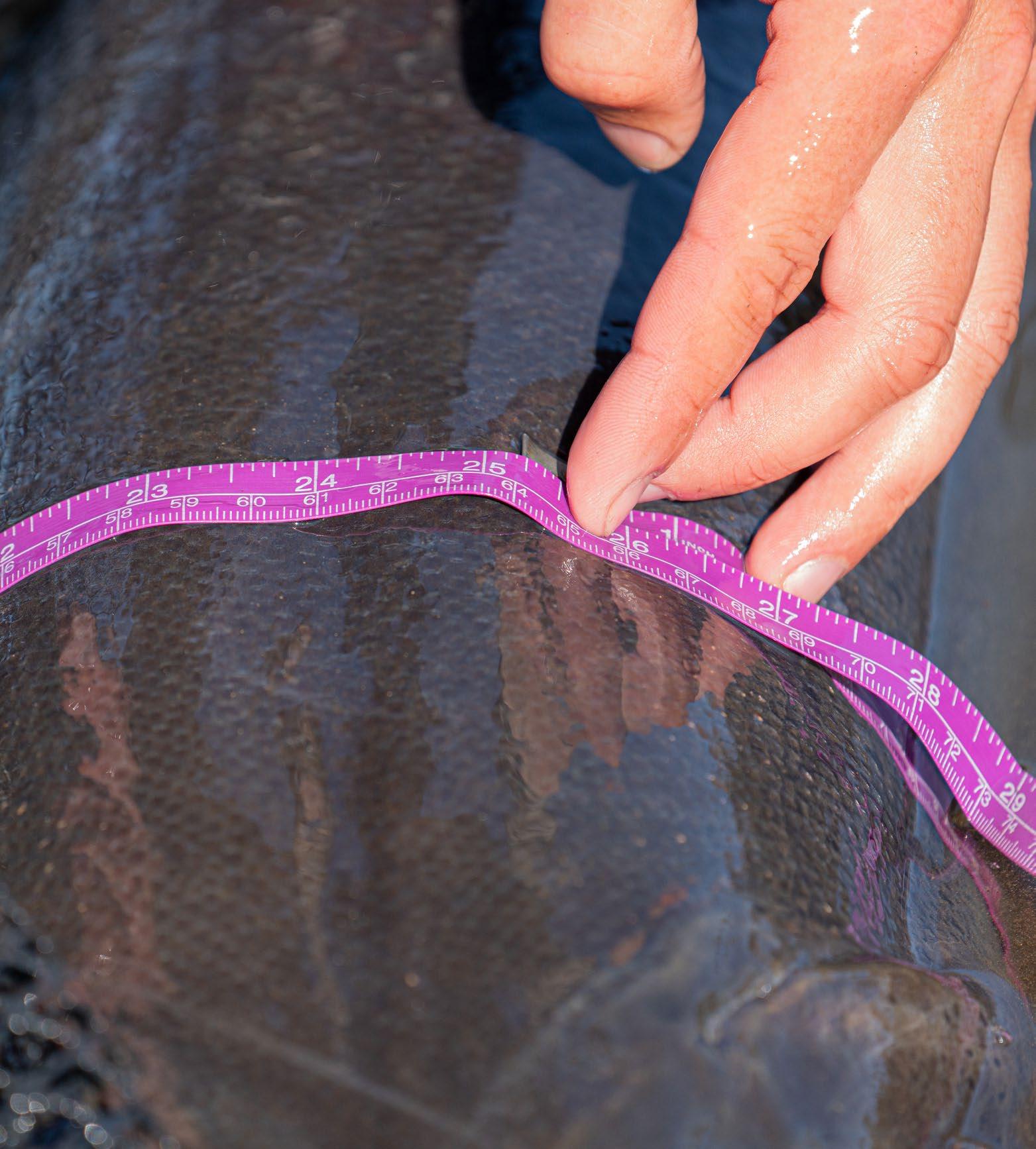

For most of the group it was the end to an amazing week’s fishing, but for Ilya and Max Mamaev, Ponoi Head Guide, the trip wasn’t over as they were invited by Abramov to stay for an extra few days. Max and Ilya would fish unguided and rely on their years of experience to figure out where to fish. Both had landed trophy fish during the week, so the pressure was off. Through trial and error, they hit a rhythm of deciphering where these big fish would hold. They fished a multitude of unnamed pools, some holding no fish but at least a few times a day they found pools that produced.
“It was like something freakish out of the Guinness Book of Records”
Having realized how unique the fishing was, Ilya decided to experiment with some lighter leaders and managed to land three fish that were submitted to IGFA for world records registration: 12 lb class, 29.62 kgs (65-pound, 5-ounce), 138cm; 16 lb Class, 43.98 kgs (96-pound, 15-ounce), 163cm; 20 lb Class, 46.12 kgs (101-pound, 11-ounce), 164cm.
It was the last day and the team planned to fish a couple of pools before heading back to the lodge. As the fog lifted from the river, they headed to a section of river that had been named “monster pool” by Max earlier in the week. They fished through the pool with no action. In disbelief they discussed moving to another pool before deciding to give it a few more casts.
Ilya and Max each passed the 40kg mark before their second day. The final list of fish they caught is obscene, like something freakish out of the Guinness Book of Records.
Ilya made a cast and let the fly swing before moving it slowly to feel a constant tension as if he had snagged the bottom. Like all really big fish, there was a pause before a large head shake and a run that headed off towards a logjam on the opposite bank.
After 25 minutes and a fight that had taken them 200 meters downstream, the fish wouldn’t budge until it slowly moved to the river’s edge where Max was ready with the net. He attempted to net the fish but couldn’t fit it completely into the net.
Once the fish was subdued, they immediately realised that this was the biggest fish they had seen during the trip, but just how big was it? It measured 164.5 cm in length with an 85 cm girth. Keeping the fish in the water, they pushed it gently into the fish sling and lifted it with the scale attached.
The numbers quickly rattled past the 40 kg mark and up and over the 50 kg mark before settling on 52,12 kgs, which meant it is the first 50kg+ taimen ever caught on fly and the biggest taimen properly measured and weighted, and a new IGFA All-Tackle World Record.
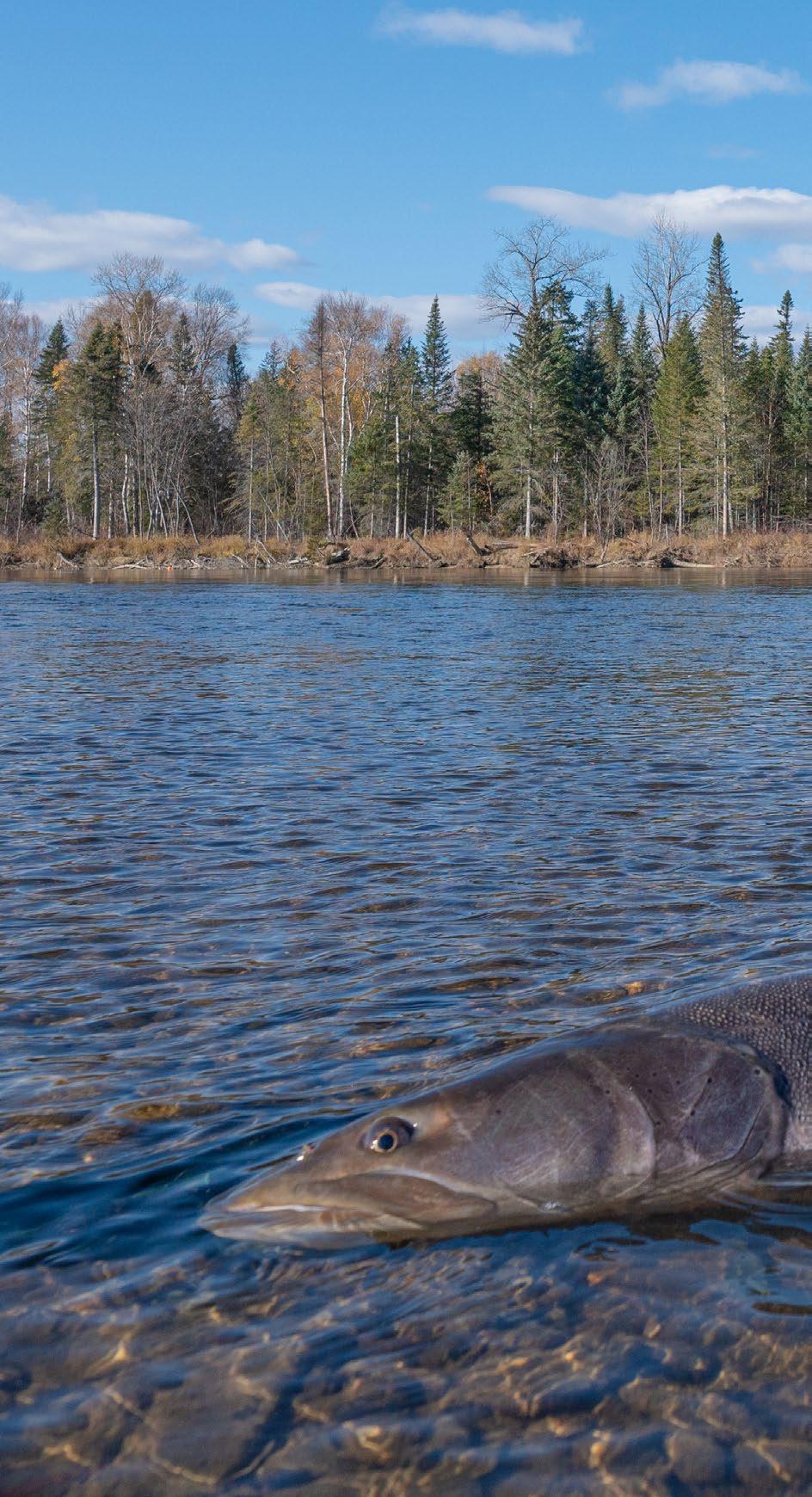

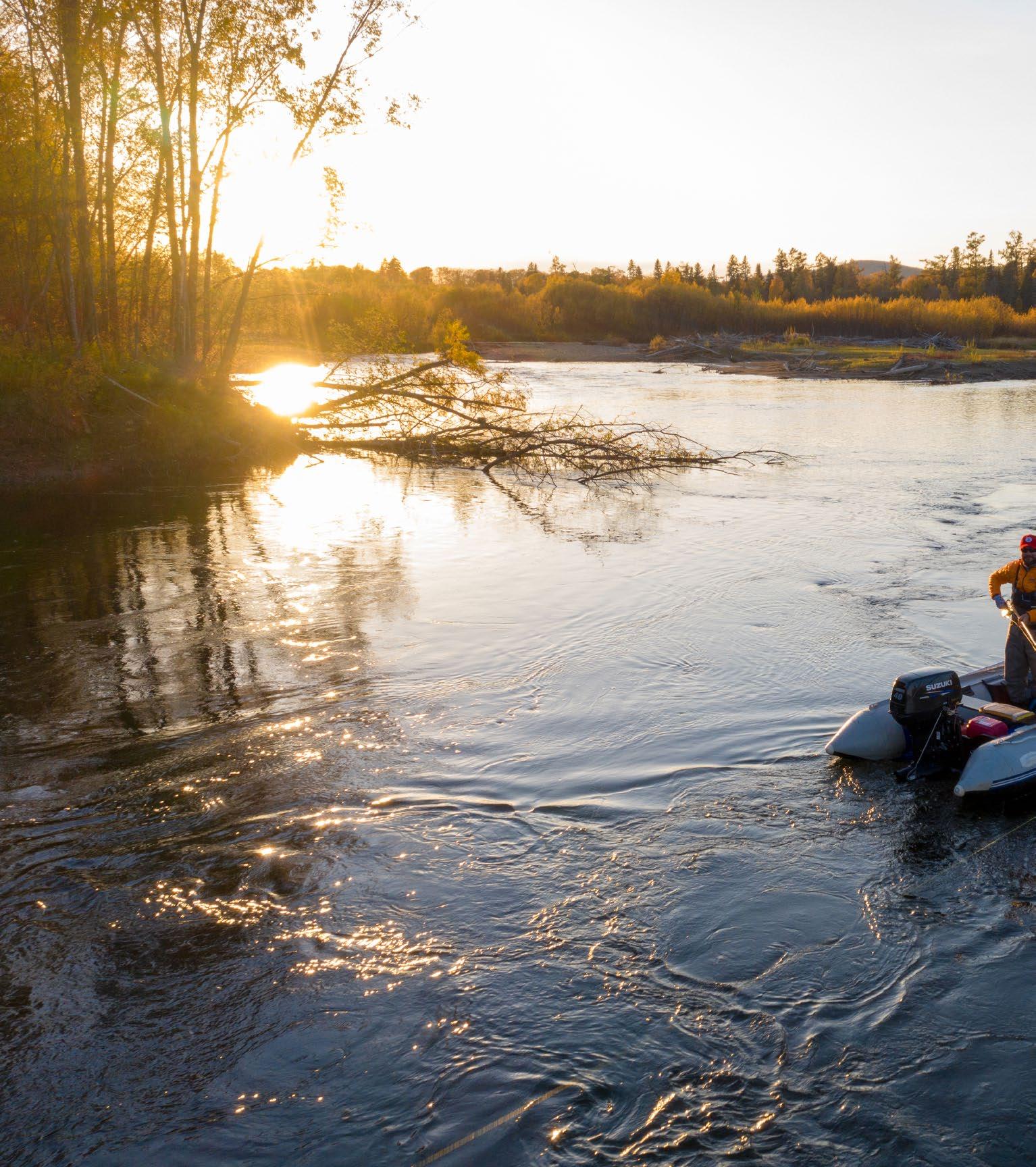
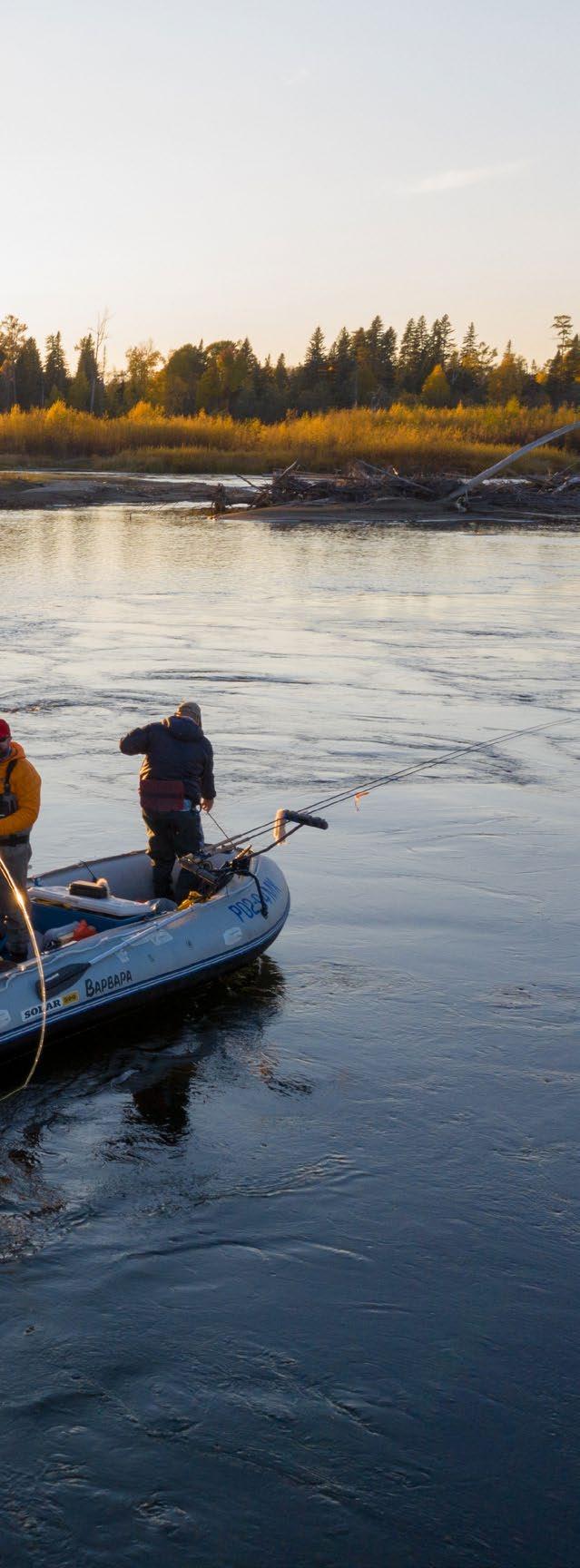
That night a fair amount of vodka was sacrificed in thanks to the Tugur River Gods for finally delivering the payload on an amazing 17-year journey that had seen us fish the most remote and beautiful places. The Siberian winter had started setting in and it was time to head home. The atmosphere that evening overwhelmed the team as they sat spellbound by the experience of spending weeks surrounded by the sheer beauty of one of the last few untouched places on the planet and of getting to grips with the ancient beasts that call it home.
Tugur-Konin Lodge was built and is currently controlled by a prominent Russian angler and entrepreneur Alexander Abramov. Nicknamed “Taimen Tsar” Mr.Abramov has created a unique fishery for giant taimen on the Far East of Russia where rivers and tributaries are guarded and fish are protected. Giant taimen now have a safe haven.
The Wild Salmon Center, Khabarovsk Wildlife Foundation and other partners have succeeded in winning the approval of the new Tugursky Nature Reserve, which will protect 197,000 acres of critical habitat within the Tugur watershed in the Russian Far East Khabarovsk Region.





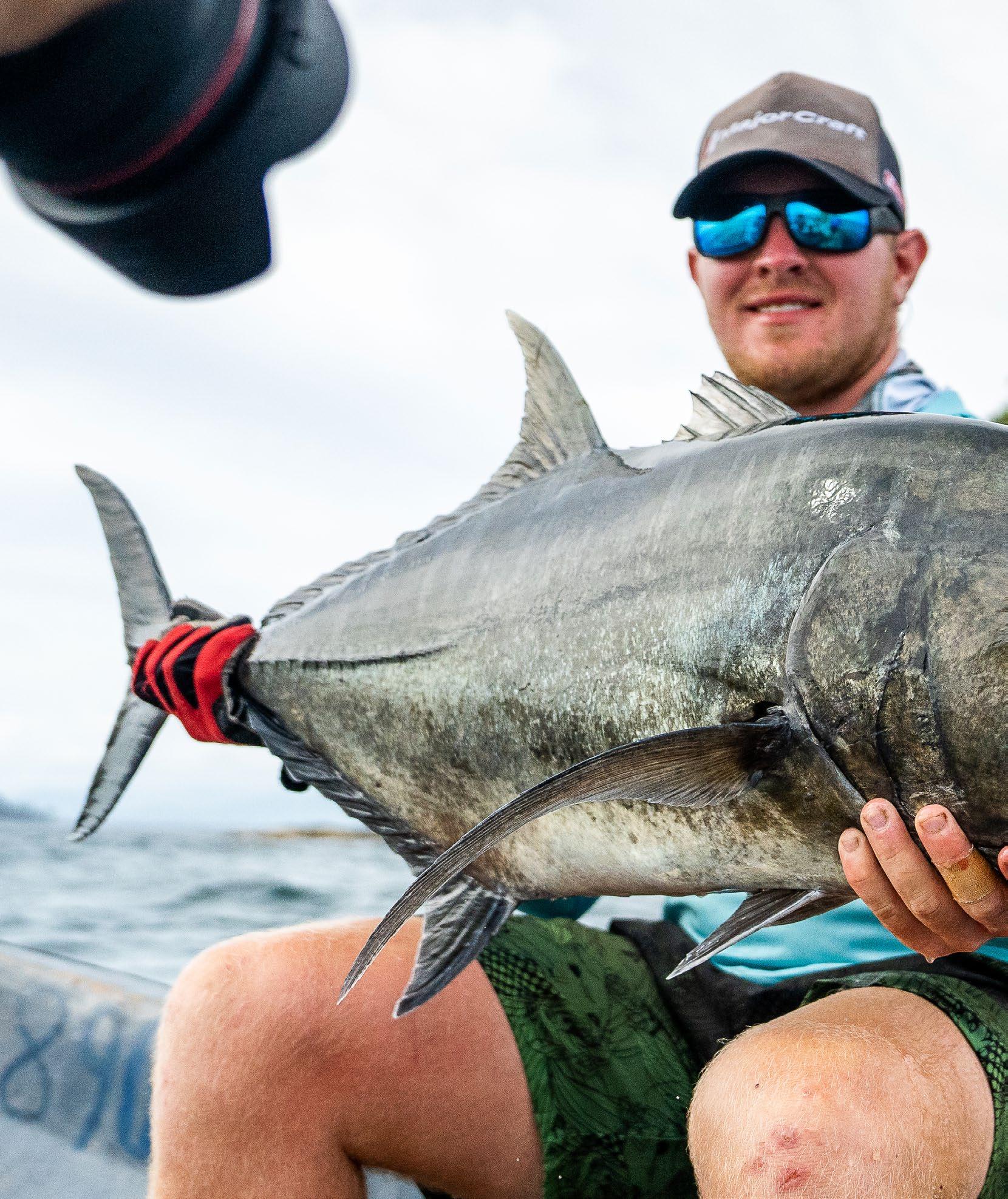

Most people know very little about Papua New Guinea. The first image that probably comes to mind is the stereotypical image of a shirtless indigenous person with face paint and a bone through his nose. Beyond that, the image is rather blank. I must admit, I was one of those people. However, that all changed in late 2022 when we decided to plan our first exploratory trip to this place at the end of the world.
By FELIX HANSVENCLOur mission in travelling to Papua New Guinea was to catch giant trevally and as great a variety of the endless species swimming in the country’s waters as humanly possible - primarily with a fly rod. But before we get into how it all went down, let me summarize a few things for you from the typical “Wikipedia and co research” that you do before flying to a place you haven’t been to before.
Papua New Guinea (PNG) is a place of superlatives. Everything is just “more,” “bigger,” and “wilder” over there:
• Papua New Guinea (PNG) is situated north of Australia. It represents the eastern half of “New Guinea” - one of the world’s largest islands. The western part of the island belongs to Indonesia and is called Western New Guinea or just West Papua. Papua New Guinea achieved independence in 1975 and is part of the Commonwealth.
• It is the country with the most dialects in the world (over 800 spoken languages). English is the
official language from the government side but Tok Pisin (English based creole, referred to as Pidgin) is probably the most commonly spoken language throughout Papua New Guinea.
• Papua New Guinea is home to some of the most amazing creatures in the world such as the world’s biggest butterfly “Queen Alexandra’s birdwing” (Ornithoptera alexandrae) which was discovered in 1906 in these pristine rainforests. To go even further, scientists say that Papua New Guinea is one of the most biodiverse places on our planet and most of them believe that there are still several undocumented species roaming these islands.
• The biodiversity includes the ocean and its coral reefs, being part of the Coral Triangle, with massive amounts of species below the water surface. Its archipelago of islands is almost endless. In addition, the jungle holds rivers with some of the best black bass fishing in the world.







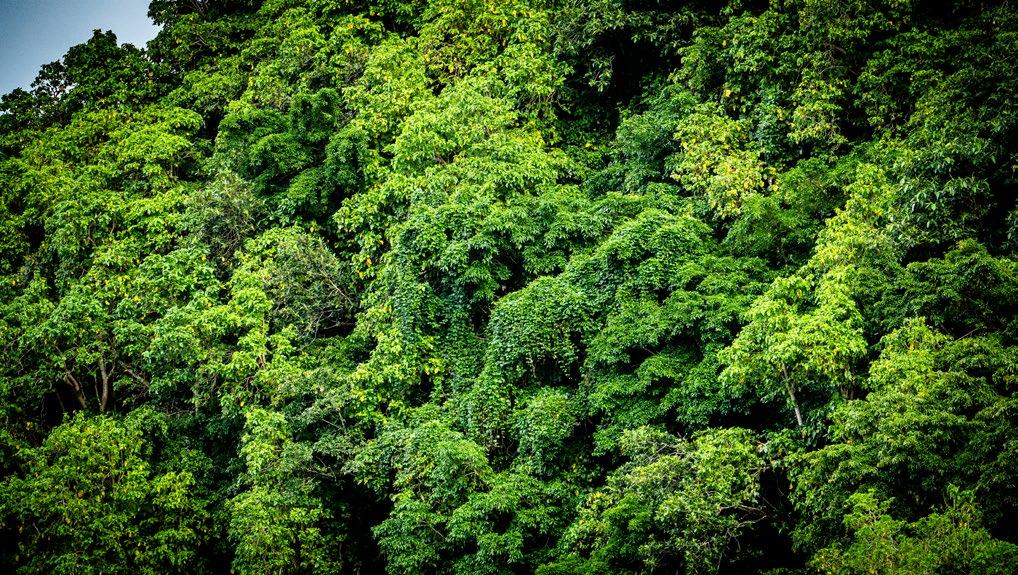


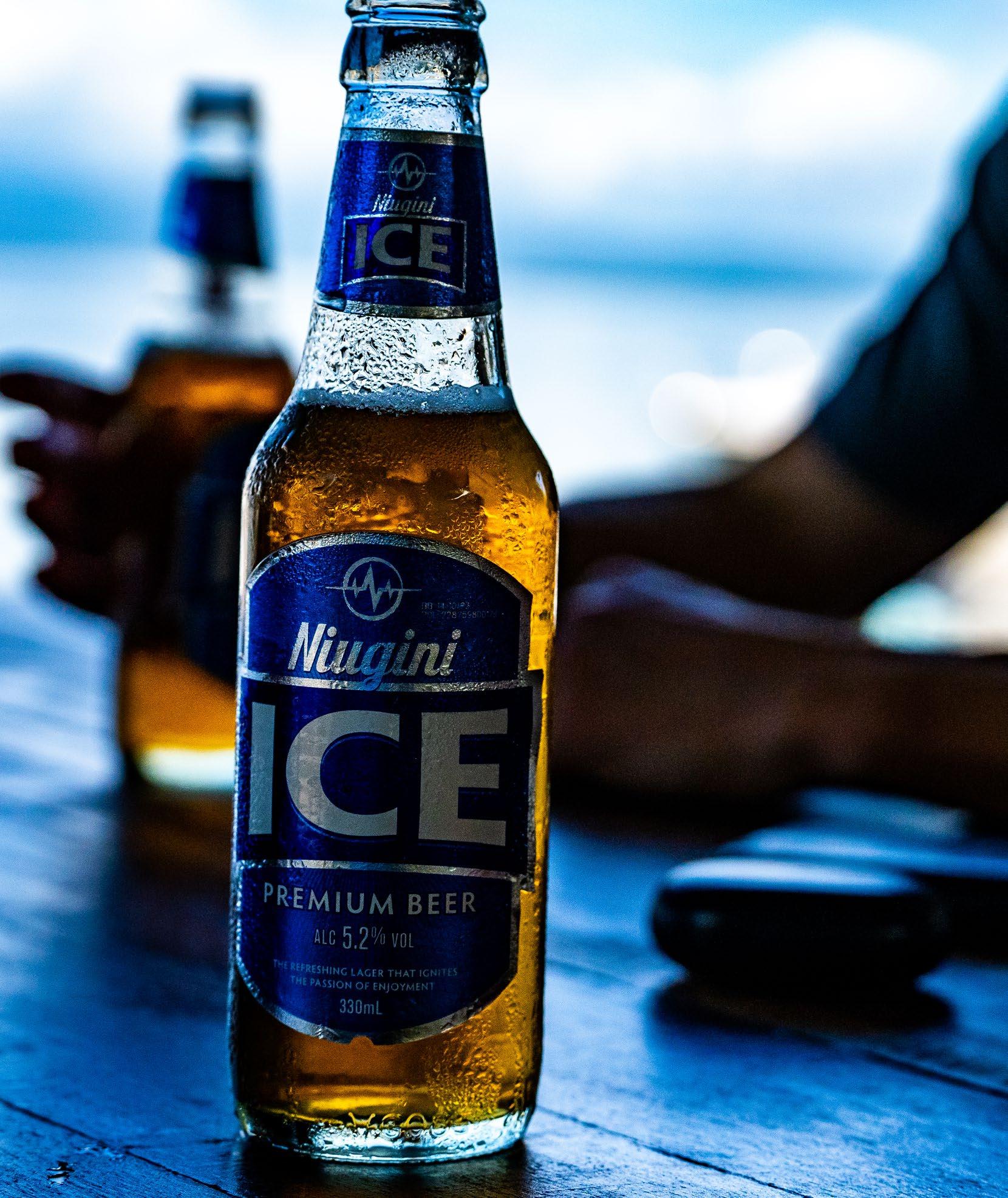
How’s the weather?
It all started in June last year when we embarked on our first scouting expedition to Papua New Guinea. We had assembled an amazing group of people, all excited to be part of the early days of fly fishing in this far-flung part of the world. We knew that planning a trip in June was a bit risky in terms of weather, but unless we wanted to wait another five months, it was our only option. Our local contacts informed us that June had been amazing the previous year, with warm weather and almost no wind, so we decided to give it a go.
Unfortunately, the weather was not on our side this time around. We encountered rain, strong winds, and overcast skies for most of the trip. We still caught fish, but it felt like something was off. Apart from the rain and wind, the water was cold, and we couldn’t visit some of the places we had planned to fish due to rough weather. This is something people quickly forget when it comes to scouting new places; it is fraught with uncertainty and factors far out of your control.
vs reality
There is so much planning and research involved; you study maps, tide charts, etc., but in the end, “boots on the ground” is the only real way to find out.
For example, what does that atoll you have in mind actually look like when you see it? Is it really a good flat for fly fishing? How deep is it during each tide (ankle-deep, waistdeep, or deep enough for diving)? Is it sand or just a field of corals that is impossible to wade on? These and a hundred other questions can only be answered by actually going there.
Having said all this, scouting expeditions are probably the most exciting and memorable adventures you will ever experience. They are the types of trips you will brag about around the dinner table, along riverbanks, and in fishing lodges for years.
The feeling of being one of-, if not THE first, to ever make a cast on a flat or in a lagoon is priceless, and if it all comes together, it is probably the best feeling in the world.


We had to come back; we just had to. We all knew it as soon as we set sail towards our final anchorage in the harbor of Alotau. There was unfinished business that had to be taken care of, and next time we were going to get it right. Less than six months later, we were back during prime time at the end of the year, and conditions were in our favor. It was truly exhilarating to finally be able to reach the grounds that we had pointed out a year before. The first atoll we anchored at was heaven on earth, a steep cliff rising out of the ocean, surrounded by crystal-clear blue water painting a perfect picture. The waters were boiling with fish, and our crew quickly caught a Dogtooth Tuna to prepare sashimi and filets for lunch.
I remember waking up quite early in the morning, everyone having coffee and watching the sunrise, me brushing my teeth outside on the railing when suddenly a sailfish came clean out of the water several times just in front of the boat. You could feel that the ocean was alive and we were in the right spot.
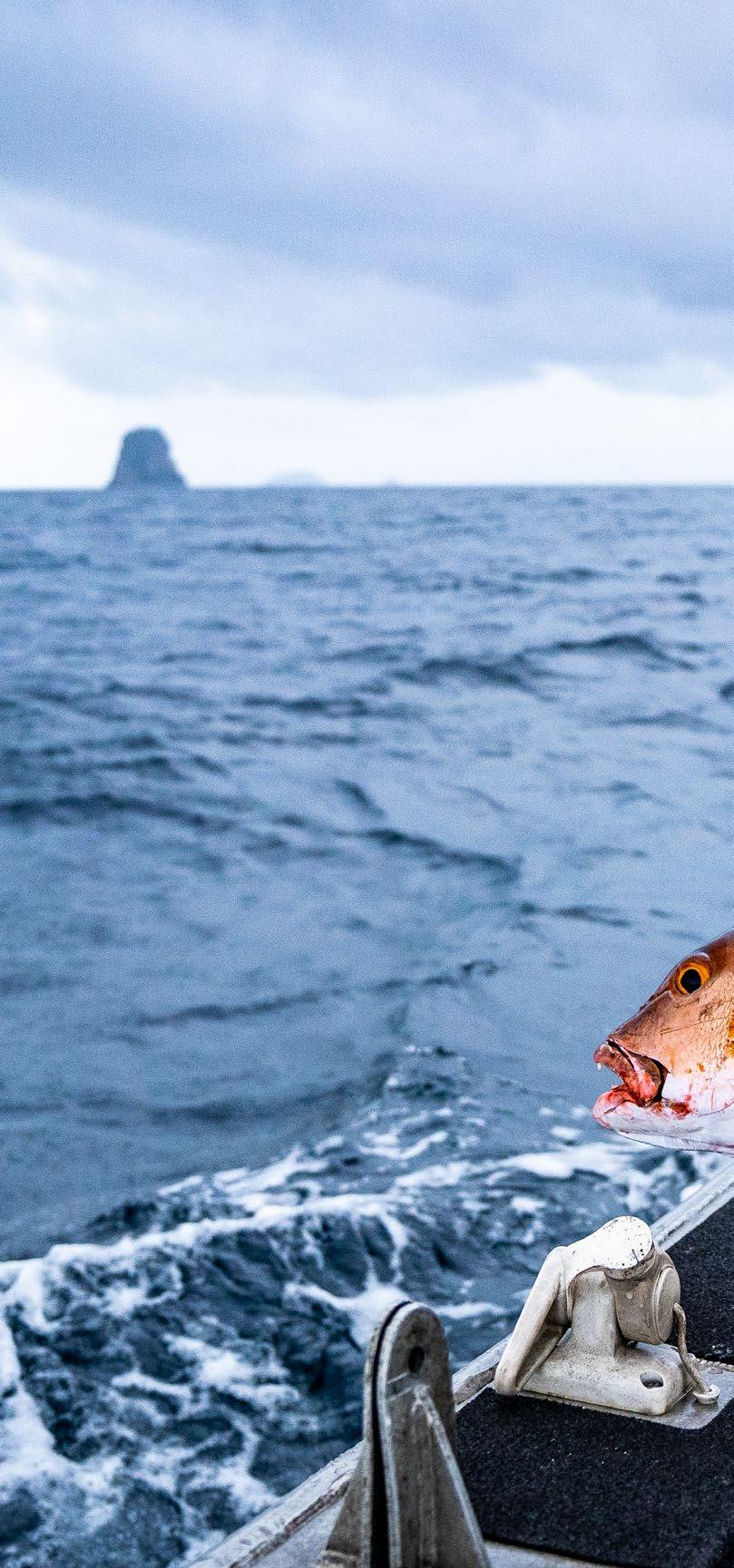


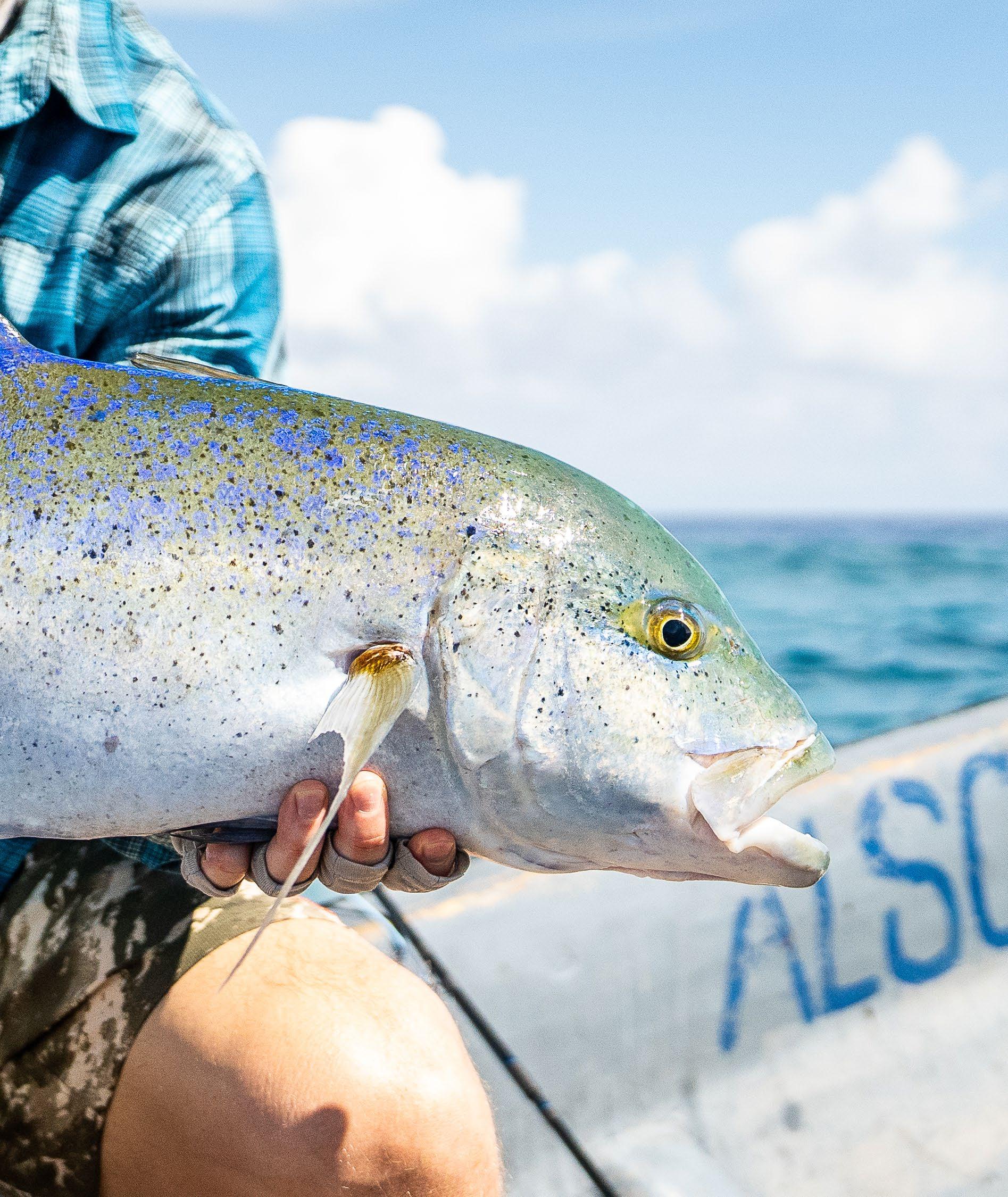

We quickly rigged our 12 and 9 wt rods, giving us maximum flexibility as we still didn’t know exactly what we would find. We had reports from locals who had seen fish, and we obviously knew what you could catch on the open ocean, but in the end, we didn’t know for sure what we would bump into on the flats, which were our main target.
The action begins
We used our first afternoon session to get an overview of the area and plan how we would fish depending on the tides over the next few days. We finished that first day with a couple of sunset drinks and a beautiful, freshly caught dinner before hitting the sack.
The following morning couldn’t come soon enough, and the boys were ready as the sun started to rise. Our local guide, Rapha, started the motor and said, “Today we will catch Bat Bat, VERY BIG!” We were pumped, all fist-bumping and letting out weird, very manly noises as we set our sights on the flats. For those interested, “Bat Bat” means giant trevally in the local Pidgin language.
We decided to focus on a beautiful flats section we had seen the day before. At that time, the water was too deep for wading, so we drifted the boat, with one person in the front casting and three guys filming, taking photos, flying drones, and whatnot. Casts were aimed towards various coral bommies and structures where bigger fish like to lurk, attacking unfortunate prey swimming too close or being pushed off the flat by the tide.
What followed was what we had been dreaming about for a year. We fished a popper fly when suddenly, out of nowhere, we all saw a big fish coming up from behind a coral head, slurping in that popper like it was nothing. I set the hook with everything I had, but the fish initially just stood there sideways, shaking its massive head.
In that moment, we got a real glimpse of its size, and suddenly the mood changed! The fish finally realized it was hooked, took off like a freight train, backing was flying out, and we did our best to follow it.






I think the fishing gods decided that we deserved this fish after all we had gone through to get here, because this time we had all the luck. When the backing got tangled around coral, it turned out to be the softest coral we had ever seen, with zero sharp edges, allowing us to get the backing up and over without breaking.
“After all the efforts and planning, it was true euphoria to land this fish”
With more than 100 meters of backing out, the fish decided to circle another coral and another, but still the line didn’t break—a not-so-small miracle. Thanks to the help of an amazing crew, including freediving god Colin, we cleared the line two more times before we finally got the fish close enough to get a real look.
The fish ended up measuring 118 cm, and it is probably no surprise that we were all pretty much freaking out when we finally managed to land it. After all the efforts and planning, it was true euphoria to land this fish, and every setback along the way was instantly worth it.


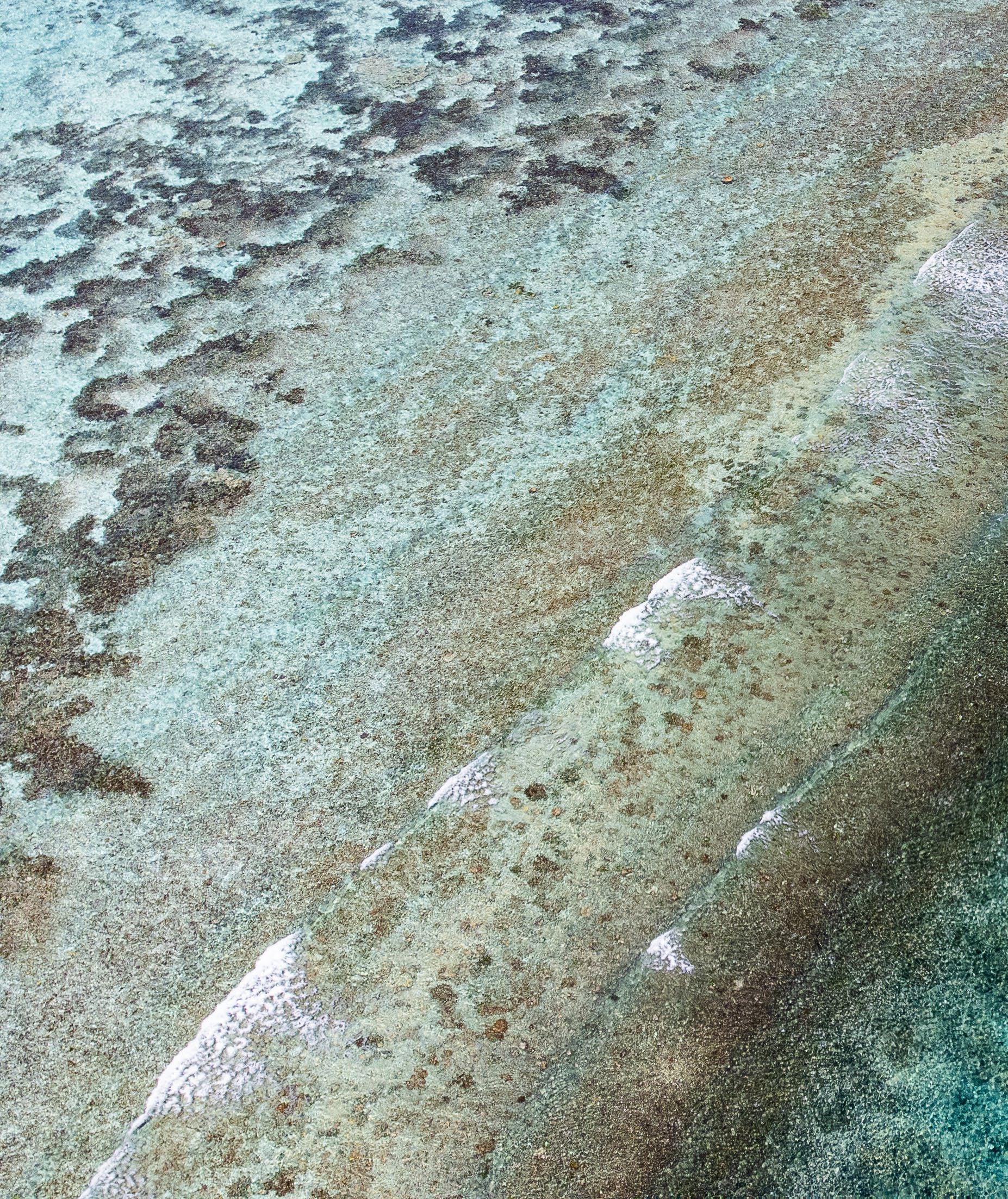


On that first day, our group landed another couple of GTs in the lagoons and sand flats and lost 5-6 more fish. Two of those lost fish were well over a meter long, but there was no way to stop them in time before they found some coral to break the fly line or leader.
“We covered an area as big as a small country in Europe”
Obviously, everyone was on fire that evening, discussing what else might be swimming around there over the next few days and how to fish this atoll in the best way possible. It was a perfect start to our trip, and for the rest of the week, we covered an area as big as a small country in Europe, with one good-looking place after another. We landed several GTs on the fly while wading sand flats and drifting with the boat over coral and reef structures. Sometimes massive bait balls were pressed against shore;
we landed a big barracuda cruising along the beach, saw huge dogtooth tuna swimming along the deep dropoffs on the atolls, landed a sailfish, hooked a black marlin while commuting with the mothership between spots (we hooked a Spanish mackerel when suddenly an angry marlin, shining neon green, came flying from the left and attacked the mackerel), saw permit swimming in deeper water, as well as bumphead parrotfish and napoleon wrasses on the flats.
We caught all these amazing species in between, like bluefin trevally, bohar snappers, black trevally, etc. Time was limited, which made it impossible to go after everything we saw, but there are certainly many things on our list for future trips.
A trip to Papua New Guinea is for anyone who is up for an adventure and eager to explore waters unknown to most people. From autumn 2024 onwards, we will return regularly, aiming to learn about these places while also exploring new spots along the way.


Our main focus will be on finding giant trevally, with additional areas searched for permit and triggerfish. We have seen schools of milkfish on the flats, and we already have groups joining us in 2024 who are keen to catch one of these big dogtooth tuna on the fly. If you want to catch a sailfish or marlin, there are great current lines with baitfish around. Who knows what else we will find?
The possibilities are endless, and these atolls are full of surprises and opportunities.
A few facts about a week: The trip starts in Alotau, where you will board our newly acquired yacht, “Tiata,” offering all the comforts you will need, including A/C, nice rooms and bathrooms, good food and drinks, as well as a knowledgeable local crew that knows these waters well. This is definitely a different level of accommodation for an exploratory trip, but we went for it and are glad to offer a first-class home away from home.
modate more. Once everyone is onboard, we set sail overnight to our first spot. From the following day, it’s seven full days of fishing where we will cover different spots we have already visited and, depending on how the fishing goes, we will also explore new areas. We have made arrangements with the local tribes for those areas, and you will likely meet some of these friendly people along the way when we trade food and other supplies with them.
We only take six anglers per week, even though the boat could accom-
“The possibilities are endless, and these atolls are full of surprises and opportunities”
Usually, you will have a morning session and an afternoon fishing session. In between, we will return to the mothership for a big lunch, and after fishing it’s time to relax on one of the sundecks, have a drink, or go for a quick swim. It is worth snorkeling one day; you will be amazed by what you see.


Last time, we encountered manta rays, big schools of bottlenose dolphins, turtles, all kinds of reef fish, and much more. For group bookings, we can accommodate and tailor the trip exactly as you want it.
The tackle you should bring doesn’t differ from other GT destinations. A 12-weight rod is necessary for everything big, and a lighter rod for going after permit, triggerfish, milkfish, etc. This could be a 9-weight (which we usually prefer), but you can easily go one line class up or down depending on your preferences and what you want to target.
As always on a saltwater trip, bring backup rods and lines! Things break on these trips, especially when the fishing is good. In terms of flies, we didn’t see any particular patterns needed as these fish will be seeing a fly for the first time. We were very successful with popper patterns for targeting GT and other predators, as well as brush flies in tan, red, and black. There is much more to learn and figure out in terms of what works and what doesn’t; maybe you could be
the one cracking the code for catching a permit or other species?
There are many options to get to Papua New Guinea. For our Australian friends, it’s basically just “around the corner,” and from the US, it is a fairly straightforward trip via Singapore or Manila. You can also travel via Australia, which is a good reason to stay a few days before or after the trip in Sydney or Brisbane with the Gold Coast nearby.
From Europe and the UK, it is usually best to fly to Hong Kong or Singapore and then take the connection to Port Moresby. It is recommended to stay one night in Port Moresby to be on the safe side with flights. The city offers great hotels (e.g., Hilton) that always arrange a private transfer service from/to the airport, making it easy and safe. From Port Moresby, it is a very short 50-minute flight to Alotau.
To know more about the trip and book your spot: felix@solidadventures.com www.solidadventures.com



Cape York Peninsula is located in FNQ (Far North Queensland) Australia. It is one of the largest wilderness areas in northern Australia. The land is mostly flat and about half of the area is used for grazing cattle. Much of the peninsula remains pristine, with a diverse repertoire of endemic flora and fauna. The northernmost point of the peninsula is Cape York. The land has been occupied by Aborigines for tens of thousands of years. In February 1606, Dutch sailor Willem Janszoon aboard the Duyfken was the first European to land in Australia.
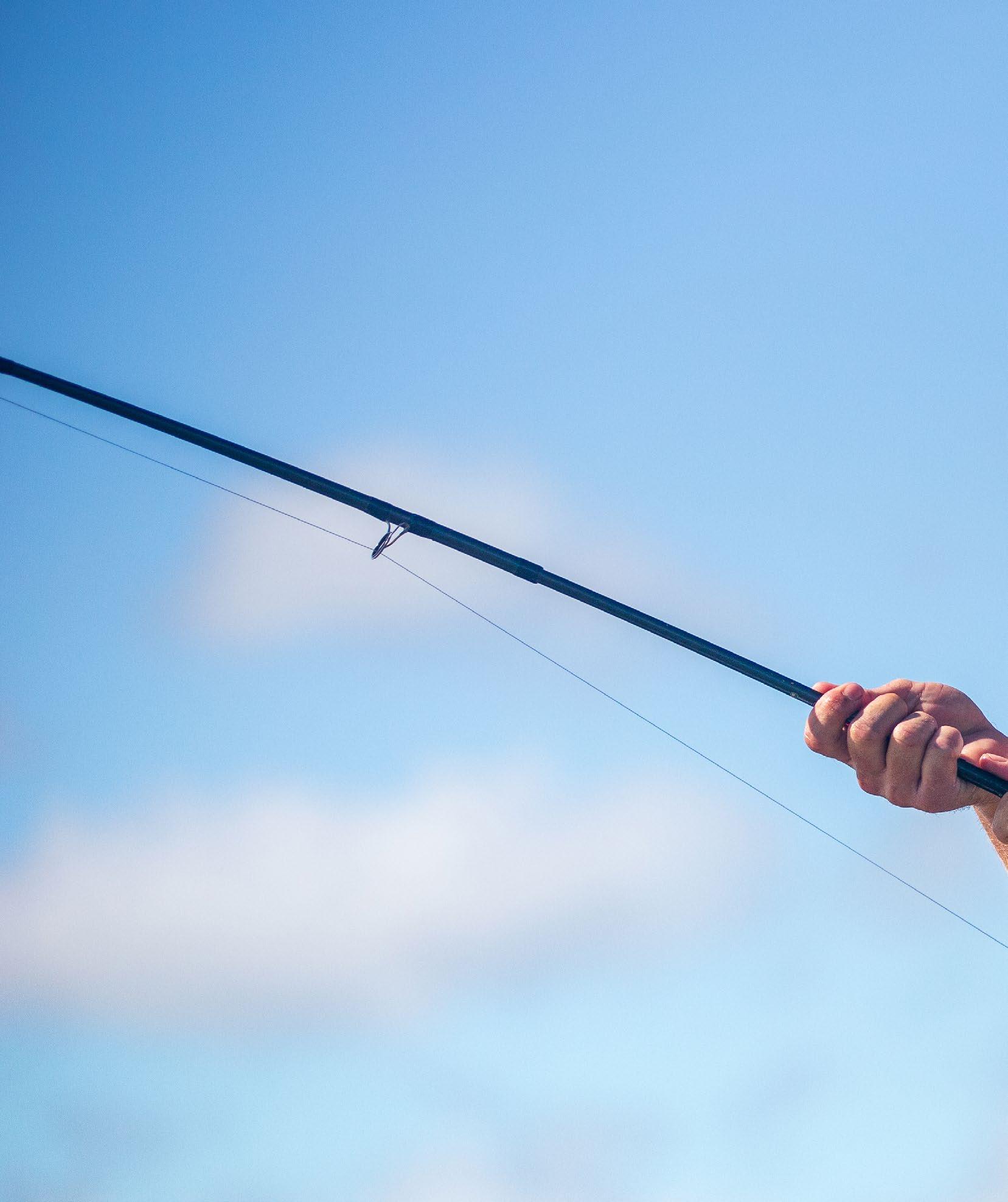 By: EUGENE PAWLOWSKI
By: EUGENE PAWLOWSKI
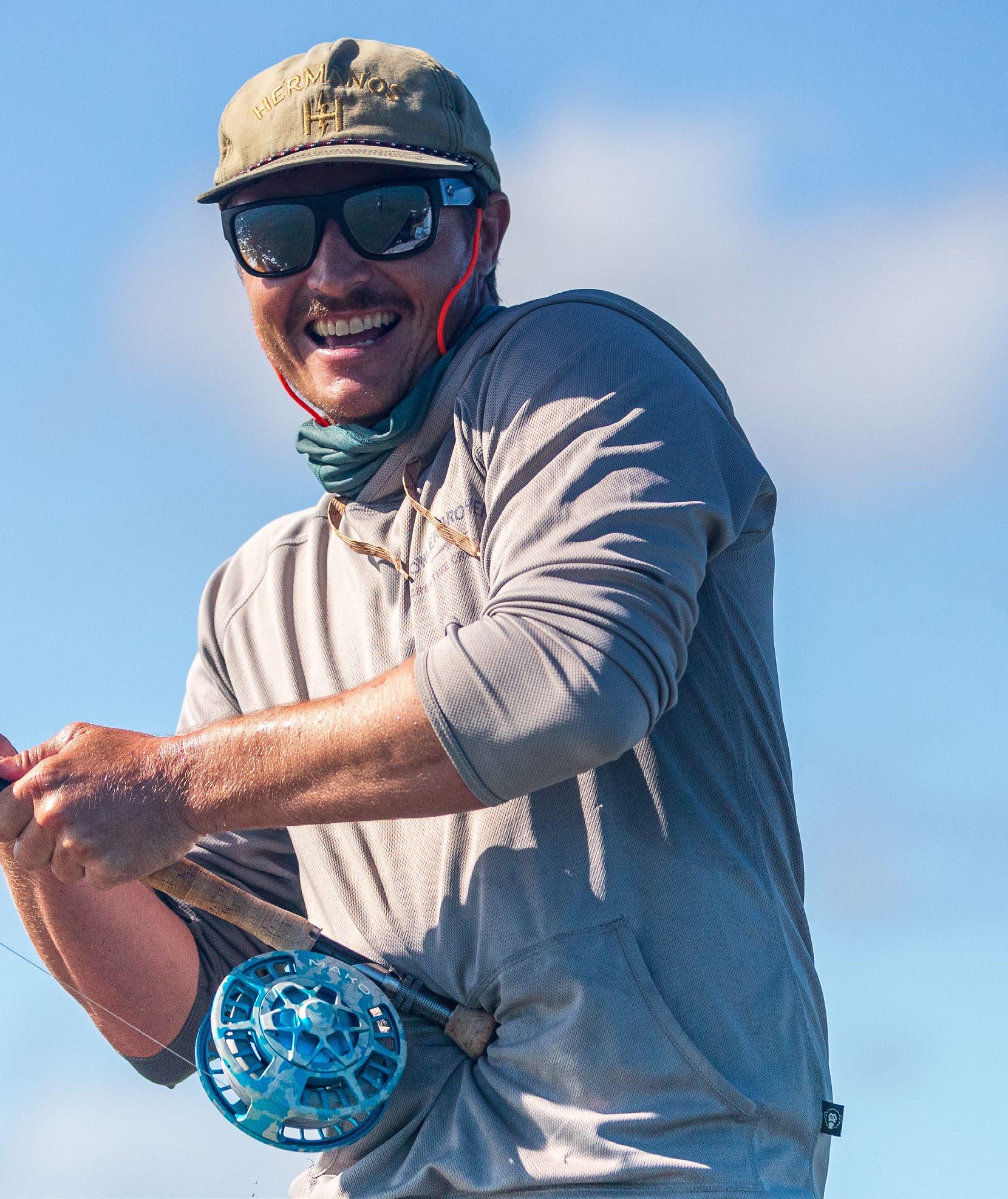

The tip of Cape York’s peninsula is the northernmost point on the Australian mainland. The west coast borders the Gulf of Carpentaria and the east coast borders the Coral Sea. The peninsula is bordered by water on three sides (north, east and west). With multiple large river system on the western side off the cape running into the gulf this makes for a rich marine environment.
The wetlands and coastal mangroves are noted for their importance as a fish nursery and crocodile habitat, providing important refuge. On the eastern side, the northern Great Barrier Reef, which encompasses over 40% of the Great Barrier Reef coral reef’s area and is an important marine habitat. The inside of the GBR has numerus reefs, Islands, sand kays, reef flats/sand flats major rivers that all add to this diverse and untouched part of the world.
On the western side of the cape the mouths of some of these rivers that run into the gulf have expansive sand flats, in the winter months the water remains relatively clear with trade winds blowing offshore add to the mix
a large range of fish that inhabit these river mouths and sandflats this is what makes it so appealing to fly fisherman.
The climate on Cape York Peninsula can be broken into two seasons with a heavy monsoon season from November to April, this is constant rain and possible cyclonic weather and very high humidity during which time the forest becomes almost uninhabitable, and a dry season from May to October. This is perfect weather with low humidity, plenty of sunshine, and constant trade winds. The temperature is warm to hot, the mean annual temperatures range from 18 °C (64 °F) to 30 °C (81 °F). Annual rainfall is high, ranging from over 2,000 mm (79 in) in the north of Weipa to about 700 mm (28 in) at the southern border. Almost all this rain falls between November and April, and only on the eastern slopes of the Iron Range is the median rainfall between June and September above 5 mm (0.2 in). Between January and March, however, the median monthly rainfall ranges from about 170 mm (7 in) in the south to over 500 mm (20 in) in the north.
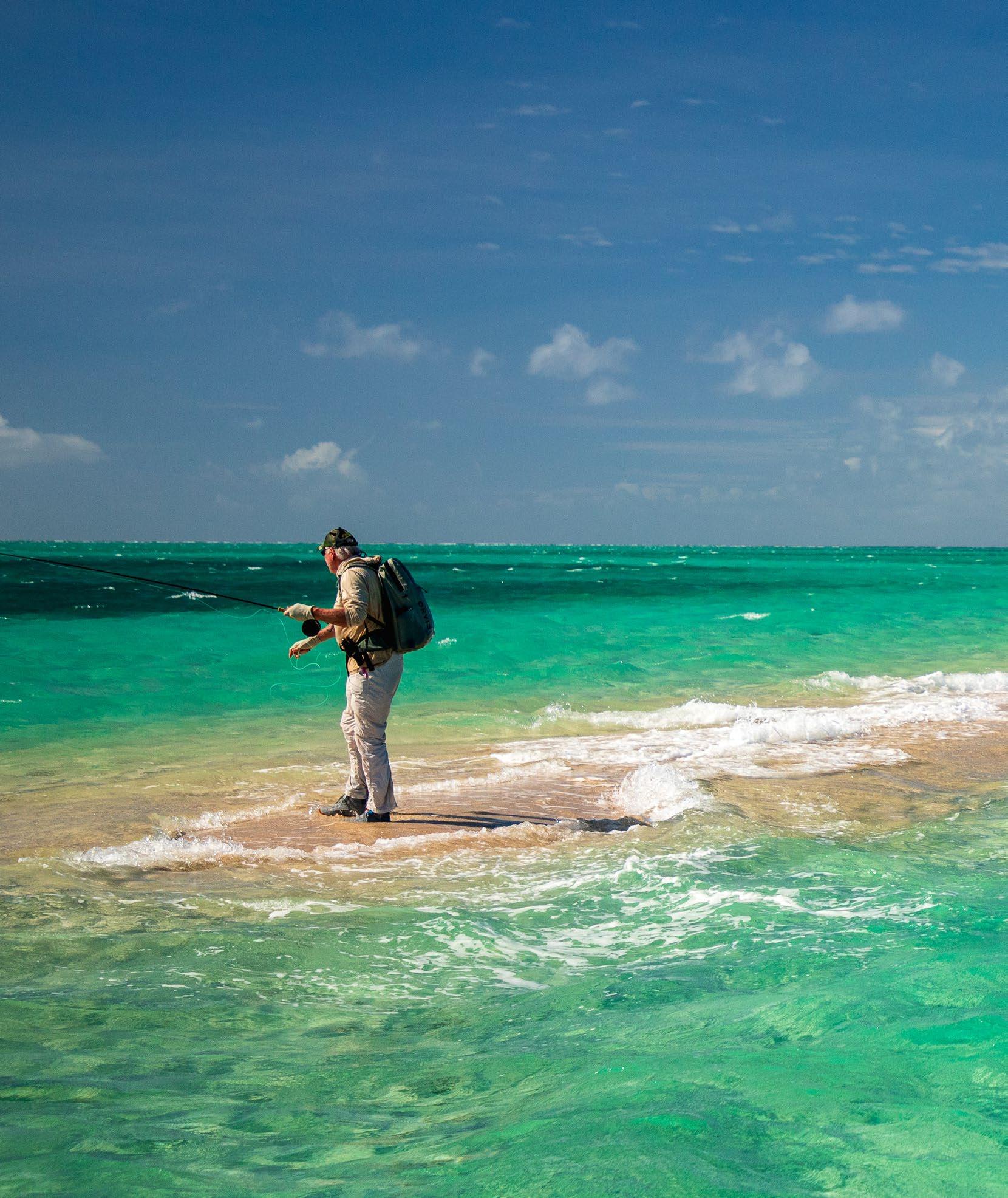
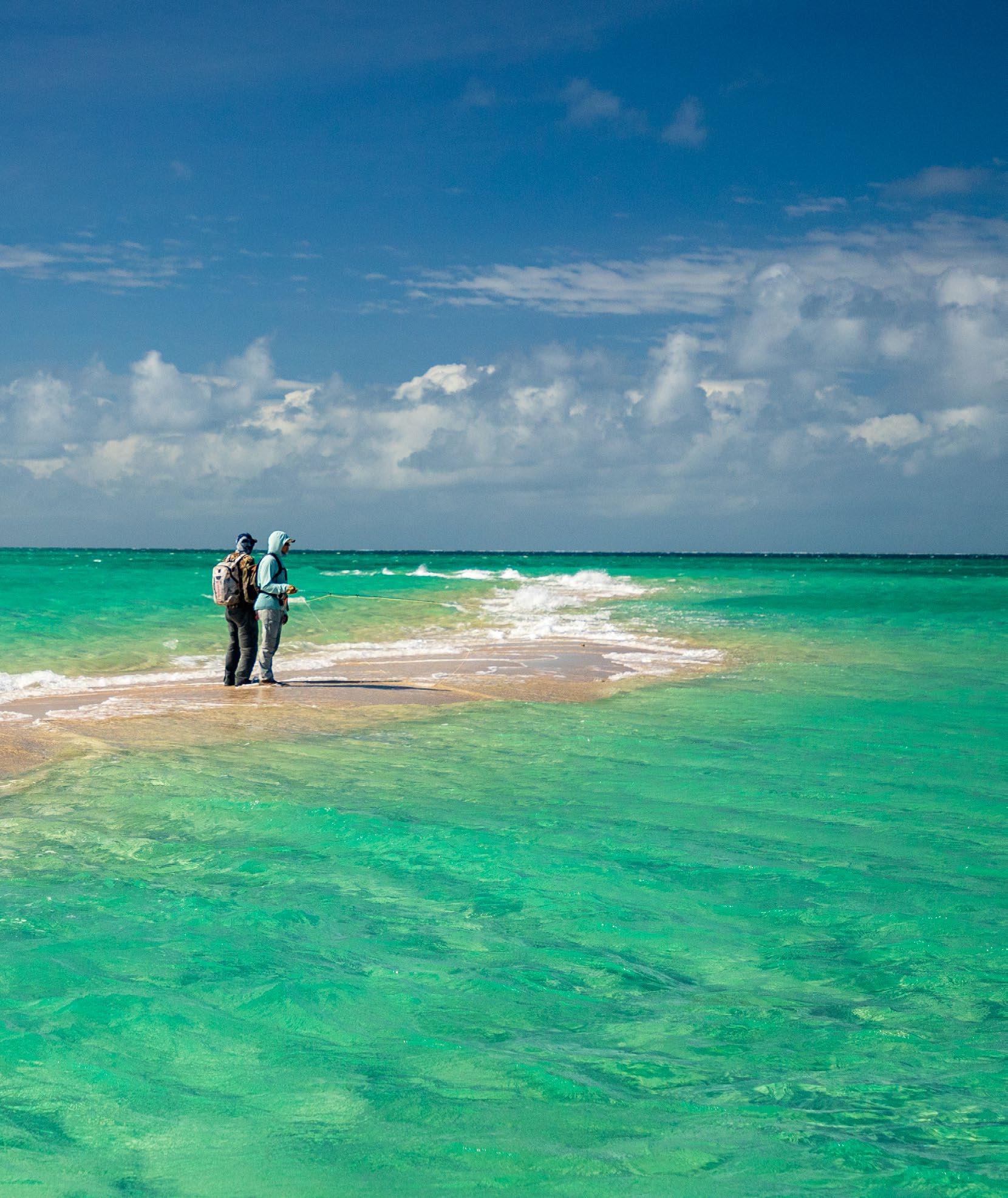
The winter months May to October favour the western side of cape York as the south east trades blow offshore making the inshore coast line flat and calm. The eastern side of the cape is buffeted by the trades from May to October/November.
“Western Cape is a vast fishery, with more than 100 miles of coastline”
You can get some weather windows at this time of year. The best time to look at fishing the eastern side is November & December and February / March as the trade’s winds are a little kinder at this time. However, you can run the risk of a tropical cyclone more so in February and March.
Western Cape is a vast fishery, with more than 100 miles of coastline with sand flats, beach’s, gutters, river mouths, mangrove lined creeks & rivers. Western Cape York boasts a huge range of fly rod target species, from the iconic barramundi to permit (Trachinotus anak) endemic to Australia and makes up the big 4 of permit.


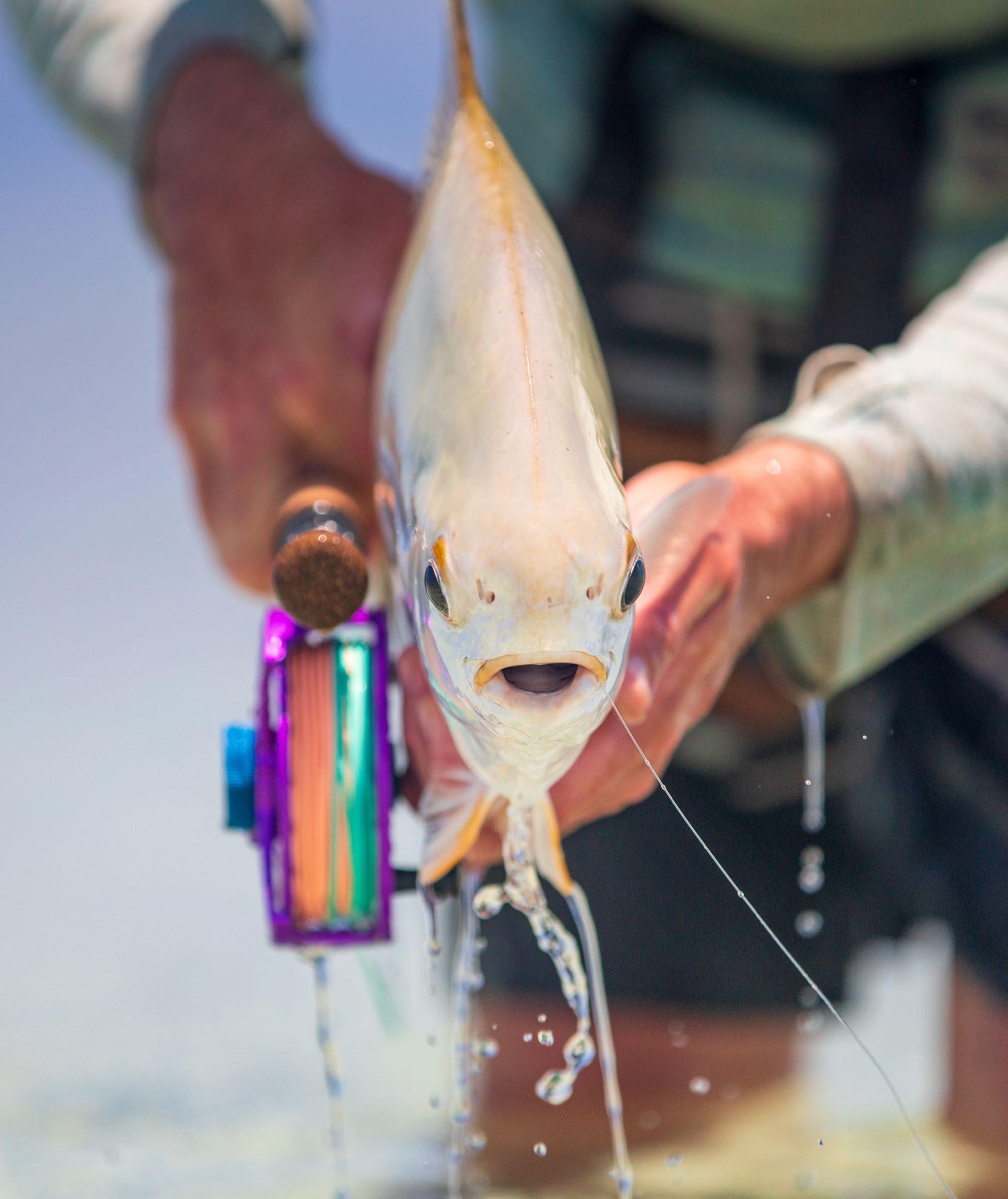
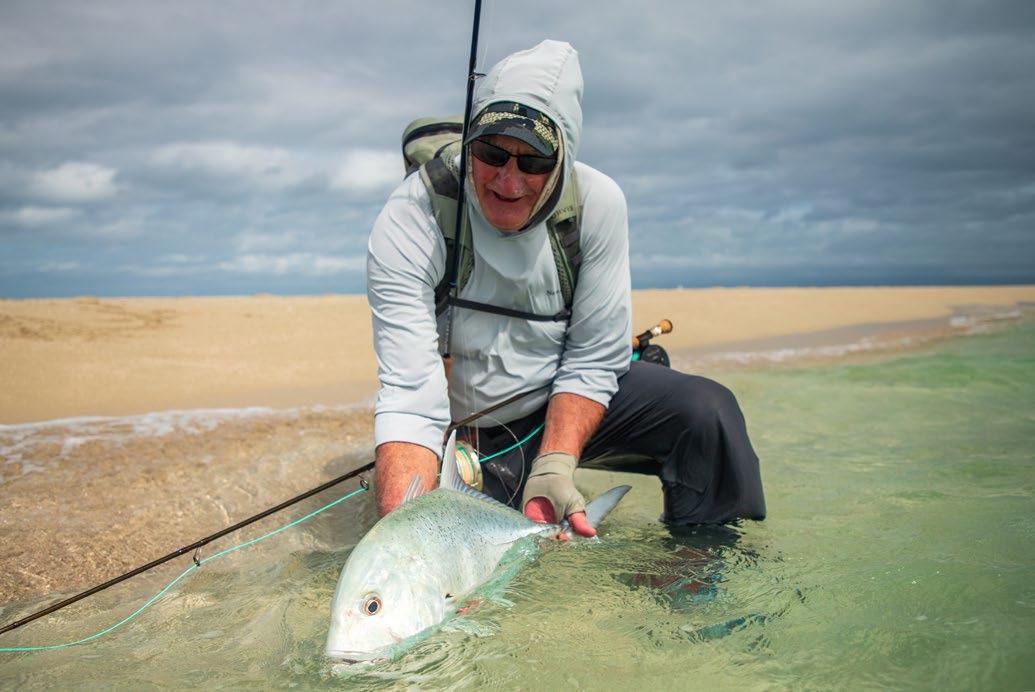







“Often the species count is well in excess of 30 species for a trip”
Golden trevally, GT, brassy trevally, diamond trevally, longtail tuna, mack tuna, queenfish, cobia, giant herring and many more, often the species count is well in excess of 30 species for a trip. Also don’t forget the big boys at the top of the food chain, monstrous Queensland grouper, tiger sharks, bull sharks, hammerhead sharks, guitar sharks, and sting rays.
The eastern side of the cape is very remote and unexplored especially looking at it from a shallow water flats fishing view, the remoteness with limited access motherships can give you a good taste of what’s on offer but even in a week you are only scratching the surface. The weather also guards many of the eastern Cape York flats secrets as the SE trade winds can blow 40 bastards for months on end.


They normally start around May and start to back off a little come October, but this is not guaranteed. November through to March or April is the northern Australia summer. This would be the pick for the eastern side but you can run the risk of cyclonic weather events. At a safe bet November / December would be the prime window.
The eastern Cape York flats are varied from sand to reef rubble /coral flats to the more inshore mangrove mud/sand flats. The eastern cape flats are best known for the Aussie flats icon blue bastards (Painted sweetlips), and permit (Trachinotus blochi), and GT. These are the big 3 but the list of what can be found or encountered is endless. You can move inshore to the Mangrove or river mouths and encounter Trachinotus anak permit, and also the 3 bad boys I just listed above, plus you can find barramundi in the creeks or mangrove forests. On the GBR flats the T blochi fishing is some of the best around. When conditions are ideal you will find multi-
ple fish riding rays. This is fantastic fishing as you can wade into position and get a great shot and hopefully a goldie or small GT does not get you shrimp before a perm does!!
Western
On a typical day on western Cape York, you can be way up-river chasing barramundi and mangrove jacks around snag piles or saratoga in the freshwater, then - after lunch - be staked out on a sand flat casting at golden trevally and permit. And then just before the day is over quickly shoot a mile out and find some tuna schools.
Or if you really want to have some fun stake out at one of the river mouths and catch queenfish until your arms fall off or see how many white clousers you can go through in a session. Or for some real fun put on a foam gurgler and rip it back as fast as you can. You will have queens exploding all over that little foam gurgler trying to tear it to bits.
All this chaos normally brings in an XL queen or two to add to the pandemonium.
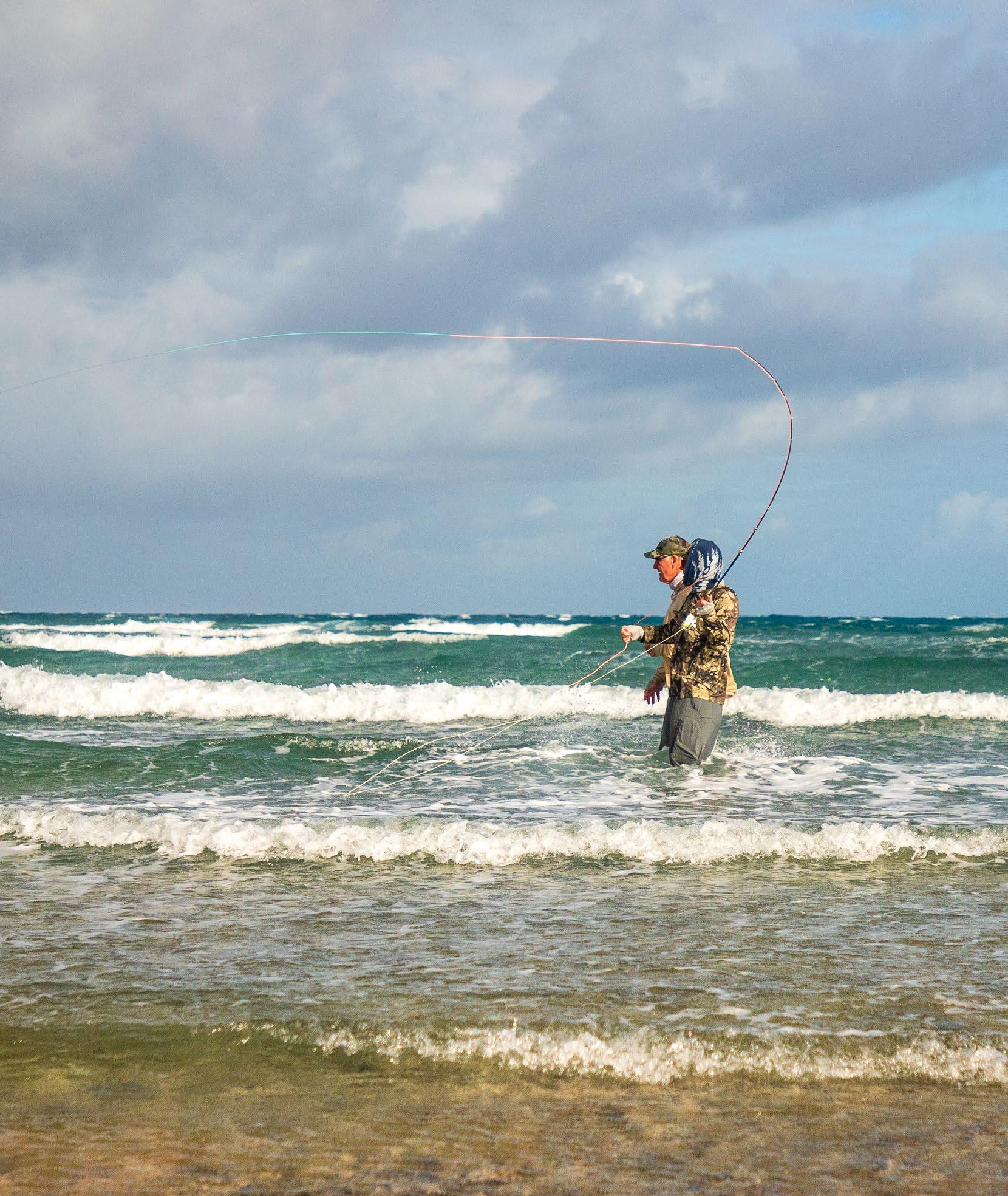








For anyone just starting out fly fishing this type of action is great as you are constantly hooked up getting to work out how to use rod angles and how much drag pressure you can apply and getting to strip set down so when you find yourself with that perm or GT closing in on your fly you don’t suddenly turn back into a trout fisherman.
The best way to approach the fishery is go with what your guide says, be open-minded, and go with the flow of what is happening. The local guides have spent countless hours in the fishery and are dialled-in on were to be fishing given the stage of the tide. But remember there is only so many hours in the day that the flats are productive, with the fish up on the flats in a good mood and with adequate tide and light to spot them.
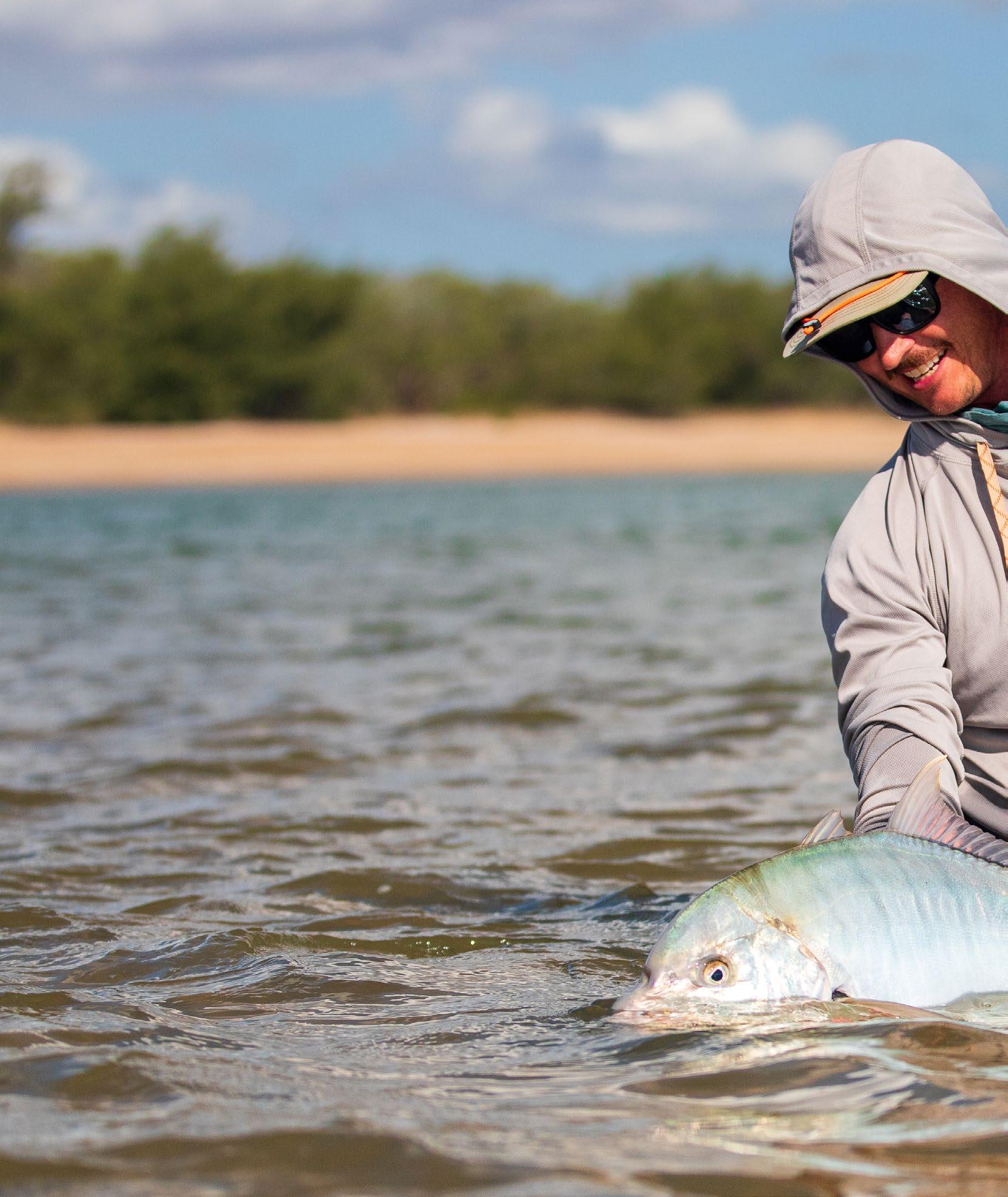

If you just want to fish for permit this is a great location especially if you’re looking to tick the T Anak off the big 4 list. If you are just a permit obsessed lunatic then the western cape York flats are prime for this. But you really have to be disciplined and block out all the other fish swimming around because there are many species around - especially the goldens and queens. We all know what happens when you hook a golden, a permit swims right up to the boat!!
“If you are just a permit obsessed lunatic then the western cape York flats are prime for this”
Gear for Cape York Rods ranging from 8 – 11wt will do the trick, and good fly reels with firm drag systems with a solid amount of backing. Floating, Intermediate sink tips and full Intermediate fly lines are the right ones to match these outfits. Possibly also bring a sinking line if you want to do some dredging offshore. Your go-to rod will be a 9wt that will do most of the work and a 10wt for permit fishing - especially in the wind. On the 11wt, I would just have this set up with a floater and a brush fly for when that random bus GT turns up. It happens way more than you would think.
Both sides of the Cape, the possibilities are pretty much endless. You can start out with a target in mind and end up doing something completely different as at times you just don’t know what’s going to swim up to you or what you’re going to find when you get there.
Leaders / Material in 16lb, 20lb, 25lb, 40lb and 60lb fluorocarbon leader will cover all applications. Tapered leaders in 16lb and 20lb can be handy for the golden trevally and permit.
Flies
Crab patterns, the Alphlexo Crab is hard to beat, colours Tan/Yellow Legs, Clear/White Barred Legs, clear/white legs, clear/pink legs, tan floating crabs – size 2 and 1/0.

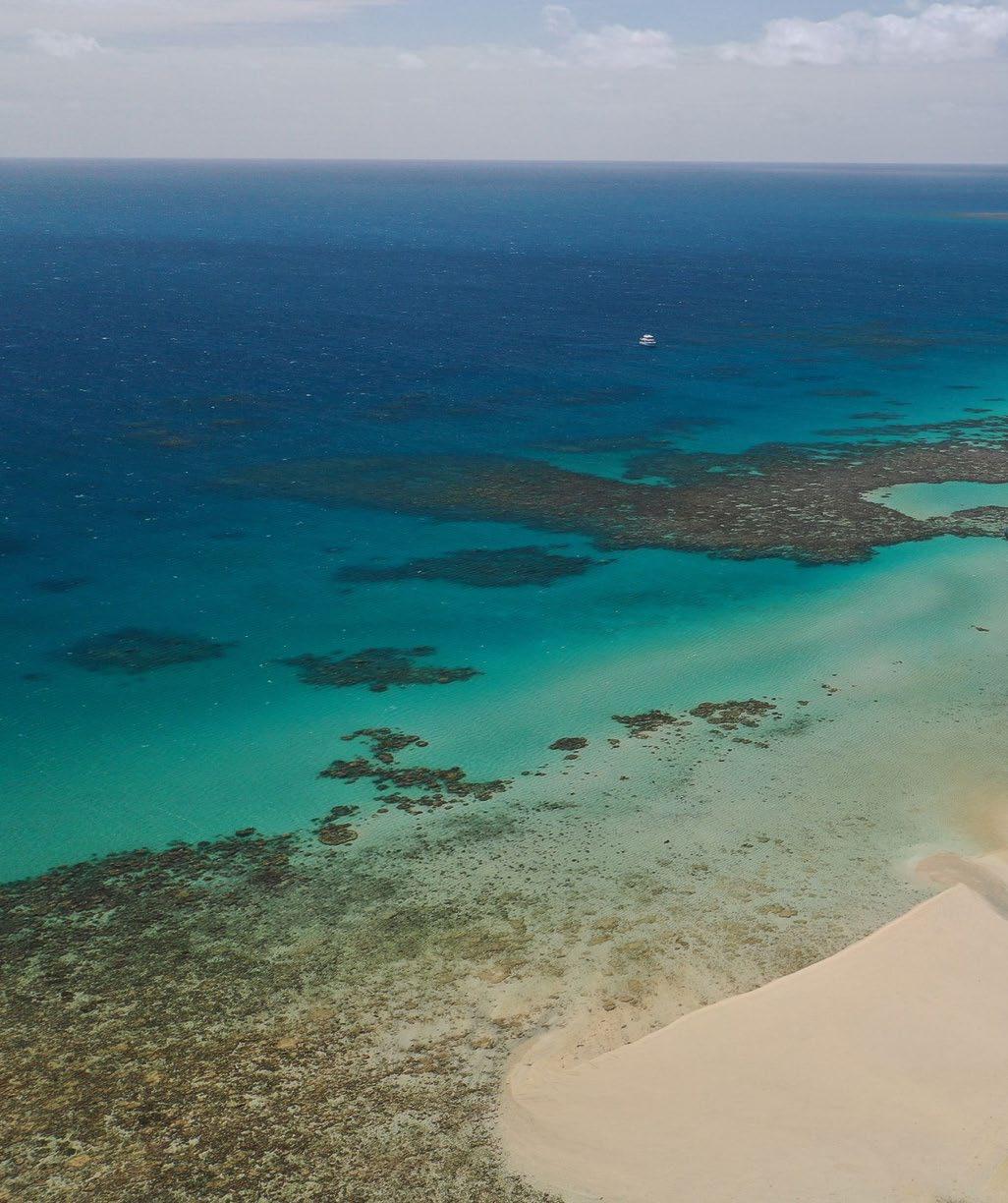


Shrimp Patterns ranging from 1/0 to 2 in tan and white.
Gav’s Crab is also racking up a good tally of Perms and other flats critters. Clousers in size 2 -2/0 in chartreuse/ white, all white, yellow, tan.
Brush Flies 4/0-6/0 in dark colours, surf candies, gurglers, poppers. For Barramundi - Pink Things, Barra Bunnies, Barra Toads in 1/0 to 2/0 in white/pink, chartreuse/white, black purple some of these with weed guards.
The weather is very comfortable in the dry season. I would recommend bringing clothing to maximise your comfort when out fishing whether it be in the sun, rain or whilst wet wading. A decent Spray / Waterproof Shell Jacket, quick dry long pants, quick dry shorts, a tech fishing shirt, long sleeve collared or hooded shirt, skins pants/ tights for wading the flats highly recommended in the warmer months (August onwards), hat, t-shirts, casual clothing, flats wading boots or neoprene wading boots.
If arriving from overseas, the best entry ports are Sydney, Melbourne or
Brisbane with same day connections to Cairns. From Cairns you take a connecting flight with Qantas airlines to Weipa if you are heading to the western side of the cape. If you’re venturing to the Eastern Cape, you will likely be flying up to Lizard Island or Portland roads from Cairns to meet your mothership.
I would recommend giving yourself a day or two either end of your trip for a little R&R in Cairns. Cairns is a great location with many accommodation options and restaurants and bars. You could also do a day excursion out to the Great Barrier Reef as Cairns is a popular destination for this.
Or if you want some more fishing do a day or two with Rory Brookes from @Tropical Sport fisher. He specialises in the Cairns area for salt and freshwater fly fishing.
If you’re looking to mothership either side of the cape, get in touch with myself or Rory@TropicalSportfisher. com and we can get you lined up for a trip of a lifetime.
www.tropicalsportfisher.com



Where the massive Ndogo Lagoon meets the Atlantic Ocean, lies a fly-fishing paradise like no other – Sette Cama, Gabon. This spectacular destination offers anglers an unparalleled opportunity to pursue numerous saltwater species, including some of the world’s largest tarpon, all while immersing themselves in its richness of wildlife, culture, and community spirit.
By EMILY RODGER PAGEAU Photos by ALEXIS
The sweeping vistas of untouched coastline that Sette Cama is known for, where pristine sand and tide flats abut against the lush rainforest and its awe-inspiring inhabitants, create celestial spectacles with every sunrise and -set. The backdrop of the sun’s rays painting the sky with hues of pink and orange adds to the visual appeal. There’s no question that it’s visually stunning. But the magic of the location extends beyond its aesthetics. Sette Cama is a tarpon haven, with a diverse fishery teeming with a variety of species. The long fin jack, red snapper, and African threadfin are just a few of the many treasures lurking beneath the surface, eager to take a fly. Every fishing session feels like an entirely new adventure, as you never know what the magic of the water will reveal.
Africa is a destination I’ve yearned to visit since childhood, particularly for a safari. I’ve dreamt of seeing elephants in their natural habitat and embracing my inner Dian Fossey by going on a gorilla trek. Despite traveling to numerous destinations worldwide, my dreams of Africa had yet to materialize.






I thought planning a trip to Africa would be too logistically difficult, and the timing never seemed right. In hindsight, I’m glad it didn’t happen until now. Not only did I experience Africa exactly as I had envisioned, including encounters with elephants and gorillas, but I also experienced it through my passion for fly fishing.
“What a gift to combine the sport I love with a lifelong dream!”
What a gift to combine the sport I love with a lifelong dream! My perceptions of the logistics of planning this trip had held me back from coming over to this beautiful continent. It was ultimately the incredible team at African Waters that made this dream seamlessly come true –the logistics were all taken care of by the team, waiting with open arms for anglers and adventures like myself to come and experience it.


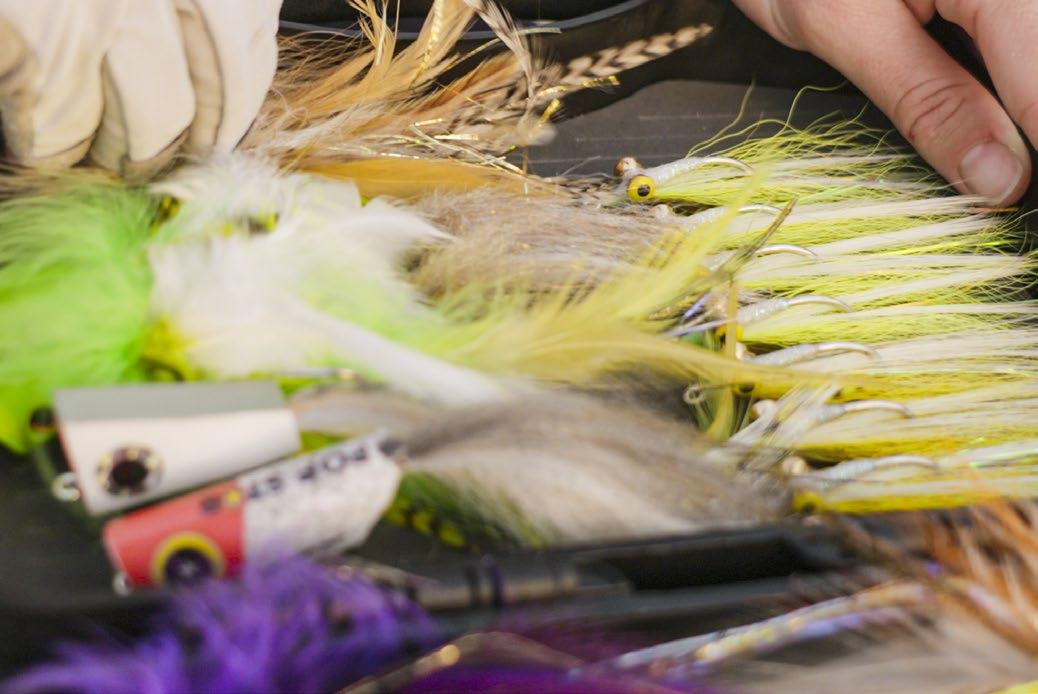
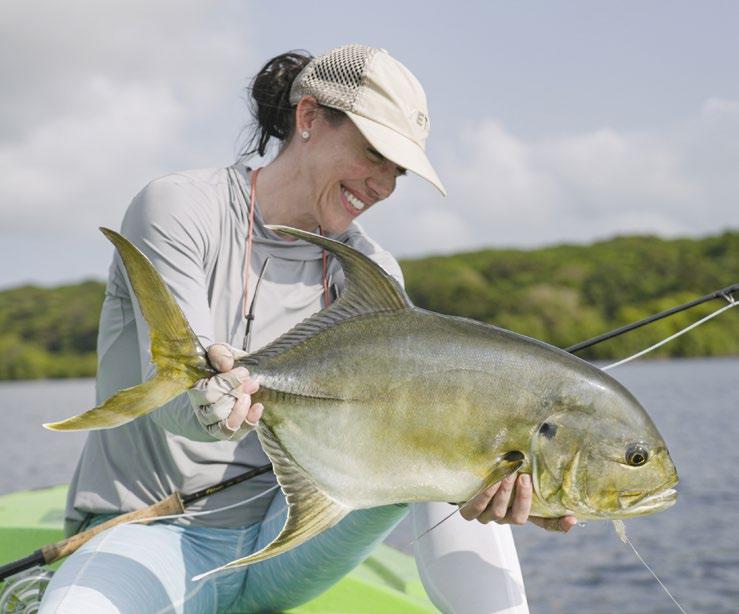


Casting my line on the beach and suddenly realizing elephants were moving silently through the foliage behind me is a moment that will forever stand out as a highlight in my life.
It was a moment where memories of the elephant stuffed animal gifted to me by my grandmother at the age of two flooded my mind. That stuffed animal still remains in my home 38 years later, a symbol of the dreams I held as a child of traveling the world and encountering wild animals. Dreams that, for so long, felt unattainable, yet here I was, finally living them.
Amidst all these wonders, there was yet another spectacle waiting to be witnessed - the surfing hippos. I had heard about surfing hippos while watching the documentary series Our Greatest National Parks and knew that it would be worth postponing a morning fishing session for the chance of trying to find them. Rising before sunrise with
anticipation fuelling my excitement, my friend Alexis and I began our beach hike guided by Ewan and the dim light of dawn.
After trekking 8 km along the beach, we reached the area where Ewan thought they would be. As the first rays of sunlight pierced through the horizon, casting a golden glow over the landscape, I beheld a sight that few are fortunate enough to witness.
There, amidst the rolling waves, was a majestic hippo, its massive form gracefully riding the surf with unexpected ease. It was a surreal moment, witnessing this mighty creature embracing the ocean waves with uninhibited joy.
That moment was a reminder of the endless wonders that await those who dare to venture off the beaten path and embrace the beauty of the natural world. As I sat there, captivated by the sight before me, I knew that this was a memory that would stay with me forever, a testament to the magic of Sette Cama and the incredible experiences it has to offer.




But amidst all these wonders, there was yet another spectacle waiting to be witnessed - the continued dedication and expertise of the guides. Yes, they were certainly knowledgeable incredibly guides, extremely familiar with the region and its fish, and I anticipated being well served by them. But what really stood out to me was the depth of their passion and dedication, and the pivotal role they played in shaping my Sette Cama experience. Ewan and Mike, two of the hardest-working guides you’ll ever encounter, went above and beyond to ensure every moment was memorable, becoming companions on this adventure.
Mike, with his infectious laughter and energy, quickly became more than just a fly-fishing guide, as I jokingly called him my “emotional support guide.”
His enthusiasm for fishing and tarpon was contagious, and his knack for finding the best spots made each excursion unforgettable. We shared countless laughs and stories, forming a camaraderie that added an ex-
tra layer of enjoyment to every fishing session.
Similarly, Ewan’s calm demeanour and wealth of knowledge about the local wildlife and ecosystem enriched my experience beyond measure. He not only guided us to the surfing hippos and the best fishing spots but also shared fascinating insights into the natural wonders of Sette Cama and shared the thrill and hard work of reeling in a bull shark with Alexis and me. Ewan’s passion for guiding and for the environment was palpable.
Together, Mike and Ewan created an atmosphere of camaraderie and fun that made every day at Sette Cama truly special. Their dedication to ensuring our enjoyment, both on and off the water, was evident in every interaction. Whether it was swapping fishing stories over dinner or sharing a laugh during a full day of casting, their presence added immeasurable value to my time at Sette Cama – a testament to the light-hearted bond formed amidst the pursuit of piscatorial dreams.




It didn’t take me long to notice that this community spirit I witnessed is authentic and long-lasting, extending far beyond the staff and guests at the lodge. What sets Sette Cama apart isn’t just the exceptional fishing – it’s the deep-rooted connection between the camp and the local community. The mutual respect between the lodge and the locals is palpable, creating an atmosphere of genuine collaboration and shared appreciation for the pristine environment they call home.
The camp’s commitment to community involvement is evident in every aspect of the experience. The locals actively participate, showcasing their love for the camp and its guests. It’s heartening to witness the seamless integration of the camp into the local culture, fostering a sense of unity and shared responsibility for preserving the natural beauty that surrounds them.


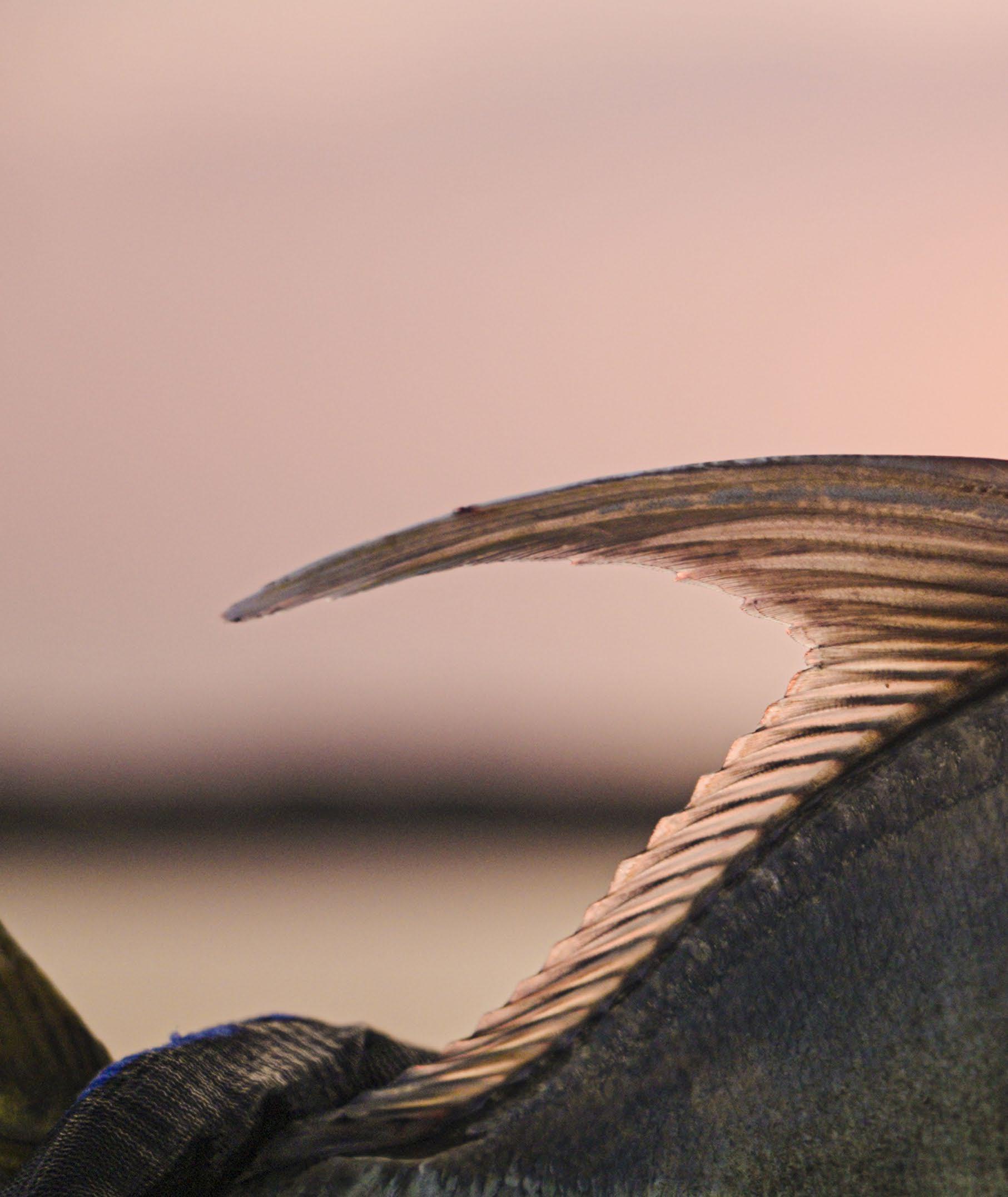

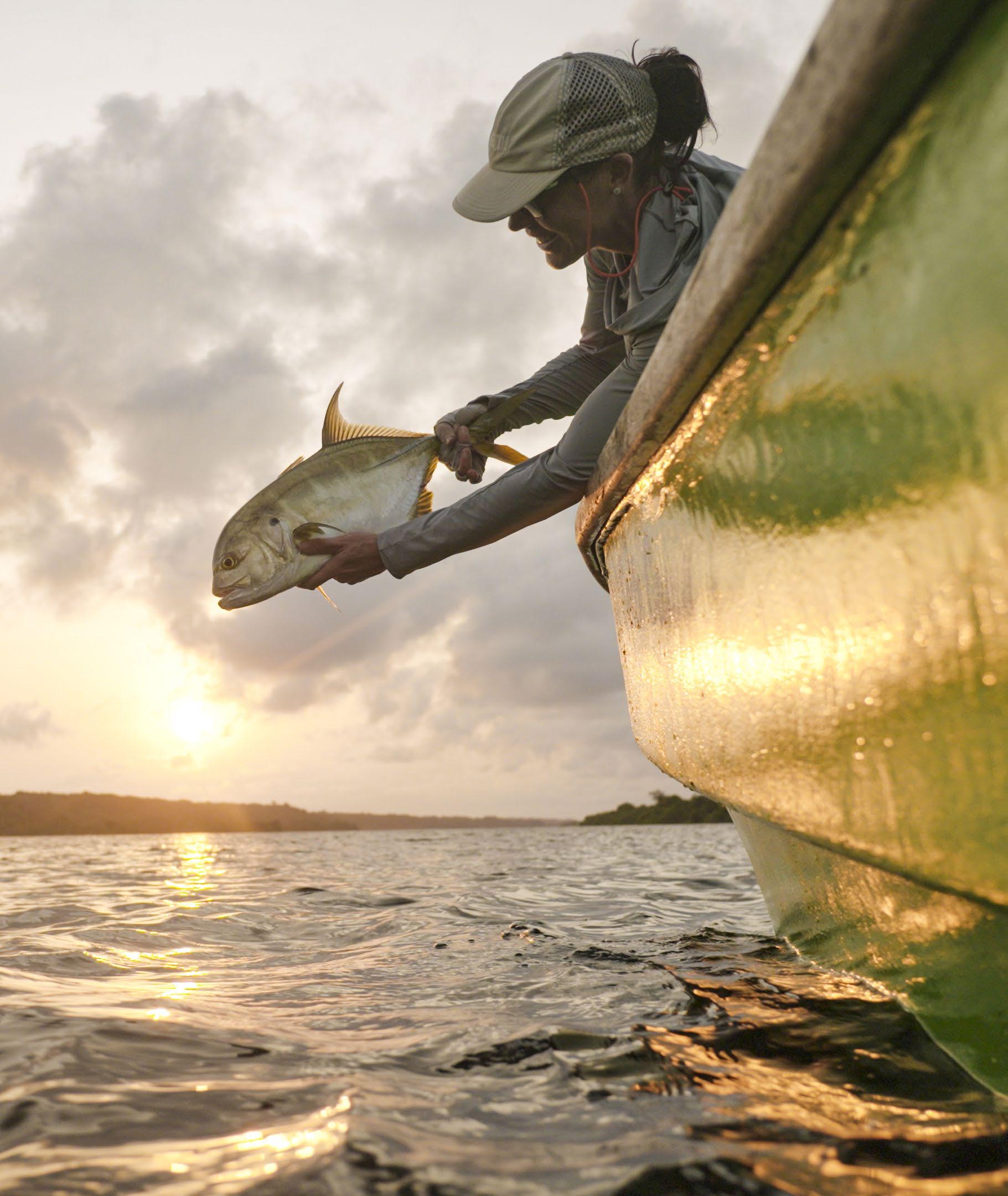
When you fish in Sette Cama, you let the ebb and flow of the Atlantic tides guide you. They call the shots, not the clock. Many anglers rise early, donning their gear with the first light of dawn, eager to capitalize on the morning bite. Actually, about half of my fishing during this trip was in the dark, late at night or in the early morning. This was a new experience for me, both fishing in the dark and even just staying up past my routine 9pm bedtime! The darkness of Sette Cama is not the same as the darkness of an urban setting. In Sette Cama, dark is dark. It’s complete - and completely enveloping.
But isn’t it amazing how limiting one sense truly does kick all your other senses into overdrive? There were no distractions, nothing else fighting for my attention. It felt as if this is how we are meant to live in nature - able to immerse ourselves fully in it, aware of its rhythms, its energies, the overall feel. In the darkness, I became much more aware of the feel of my rod loading (or not loading!) and of the sound
of the movement of the fish - paying close attention in determining their location solely on sound (and, in many circumstances, Mike or Ewan just telling me where to cast!). In the dark, I could truly feel the unbridled power - but also the incredible harmony - of nature all around me.
“In Sette Cama, dark is dark. It’s completeand completely enveloping”
Being in tune with nature in this incredible sport helps me to tune out all the noise and distraction of daily life. Do I love catching fish? Of course! Pursuing that catch is an incredible rush. But the outcome of a caught fish is certainly not the whole story. The journey - the waiting, the watching, the understanding of the rhythm and strengths of the fish all around me - takes me outside of myself, leading me into something greater.


It forces me to focus on the world around me, as well as my own response to it - am I getting impatient? Am I giving up easily when I don’t immediately get the outcome I want? Am I trying to understand the patterns of the beings around me or just hoping they’ll conform to my own schedule? I need to be there, in the moment, and experience what’s happening. I need to shut out the distractions of day-to-day life and focus on the process, and on the environment and my encounter with it. I think this is part of the reason I’m so drawn to fishing and travel. I truly believe that we all need, at times, to pull away from the busyness of everyday life to refocus on what’s important to us. Like all of my trips, my trip to Sette Cama reminded me, yet again, how crucial this is.
In some ways, the entire trip was like that experience of fishing in the dark. When I fished in the dark, I was amazed at how much more self-aware I became. I noticed minute muscle movements that might have escaped me if my attention had been more split. I could feel in more detail how I held my rod, how the vibrations from the water travelled up it. The actual act of fishing became entirely central in my mind, with nothing to pull me away from it. In the same way, the lodge’s attention to detail and genuine warmth and care for their guests meant that I could tune out the distractions that sometimes hound us when we travel, and I could focus instead on being present in the moment.

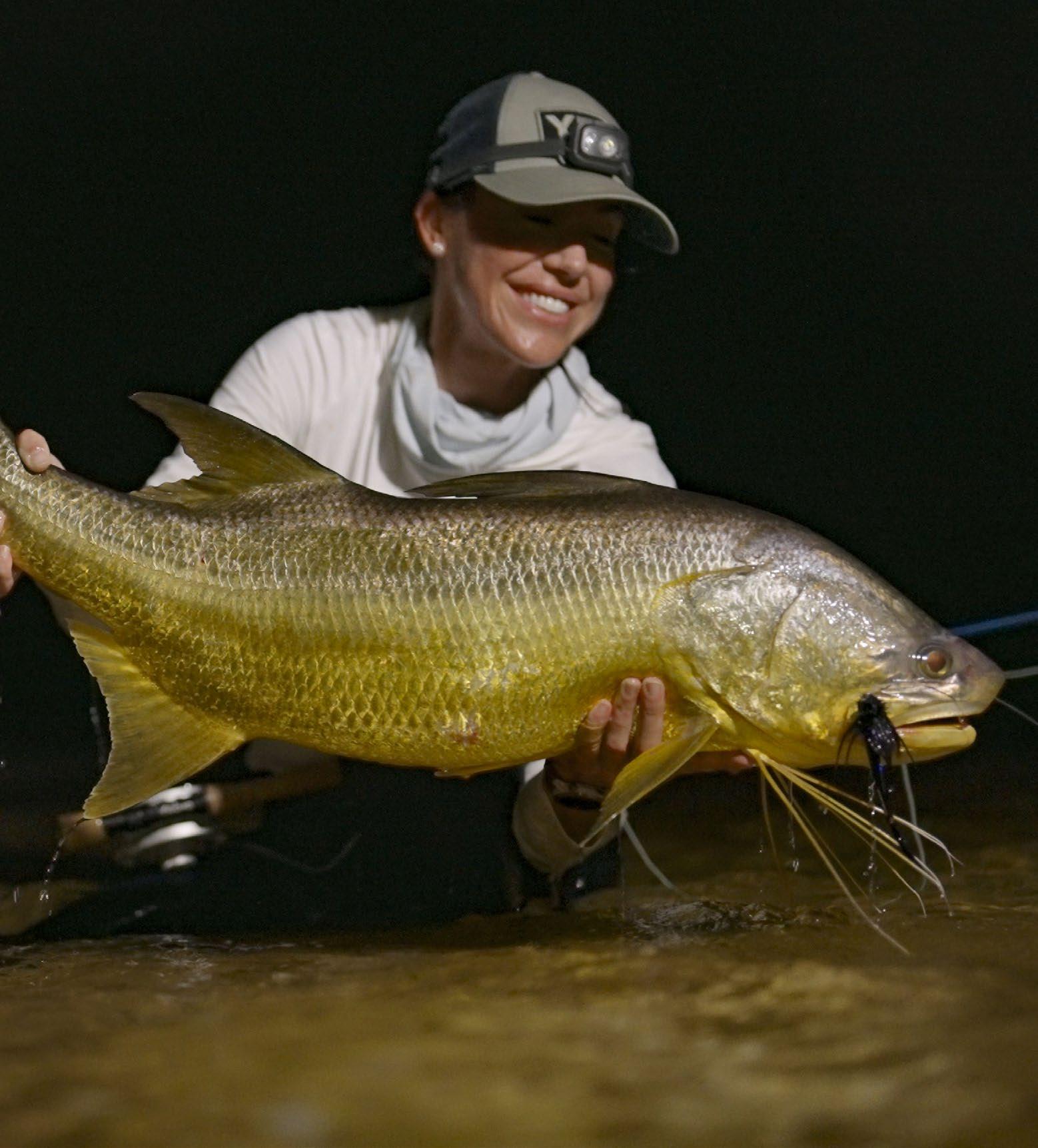

My arrival, the amenities, the warm and knowledgeable guideseverything about the trip was well executed and seamless. There was nothing to pull me away from what was right in front of me, nothing to dull the impact of nature as it was made to be experienced.
Sette Cama was everything I’d hoped for - and so much more. Yes, it was the scenery, culture, wildlife, and sport that I’d always craved, but it was also the human care and connections that allowed me to be myself, regardless of setting. It was being so well taken care of, with my needs continually anticipated and met, being able to focus on what was in front of me, and all around me.
Inexplicable magic
Reflecting on my journey to Africa, I realize now that my delayed visit to this magnificent continent was partly due to my misconceptions about its logistical challenges. However, thanks to African Waters and their dedicated team, I’ve come to understand that nothing is
too logistically difficult when you have the right support, creating an unforgettable experience to explore Africa’s wonders. From the pristine waters of Sette Cama to other destinations throughout Africa, African Waters offers a gateway to adventure, camaraderie, and the profound beauty of the natural world.
This trip to Africa has left me yearning to explore even more of the continent’s incredible fishery and wildlife, reigniting the childlike wonder from years past of what else I can experience in Africa. As I sit here at my desk, basking in the warmth of these memories, I realize the profound value of being present in the moment. There’s an inexplicable magic in immersing oneself fully in the now. Amidst any darkness, whether it’s the unknown depths of the sea or the uncertainties of what lies ahead in life, there’s a unique calmness found in casting a line and being in the shadows, guided only by instinct and the whisper of possibility. There is something to be said for fishing in the dark.



Built with ruggedness and durability in mind, Grundéns Vector Stockingfoot Wader stands as one of the most-durable waders on the market. The ultra-dense, 4-layer waterproof, breathable shell provides best-in-class abrasion and puncture resistance for those looking to fish harder and adventure further both in and out of water, yet maintains an awesome 30K+ waterproof rating to keep you protected, dry, and comfortable all day long. All Grundéns Waders feature their proprietary wading mobility patterning which offers ease of movement when navigating your river of choice, while Vector adds molded-in kneepads, anatomically-shaped-to-size warming stocking feet, and easy-access storage, tackle, and hand warming pockets that pave the way for a truly better wading experience. For more info: www.grundens.com
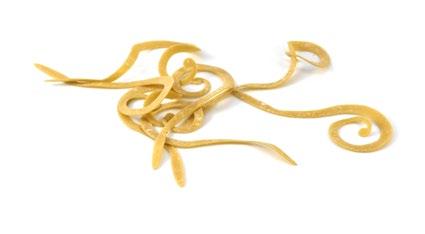

With the Slow Rolla Tails from Fly Skinz you can add some action to your favorite fly. Whether you’re fishing for seatrout, carp, bass, perch or finicky species on shimmering flats these tails will provide your flies with an amazing slow-rolling action. We’ve tried them for both seatrout in the fjords and triggerfish on the flats and have now come to rely on these tails. For more information, please refer to: www.flyskinz.com

The Bare Fishing Sling Pack is handcrafted in the USA from lightweight, durable, and water-resistant materials. It is designed to empower every fly fisherman with the freedom to customize the placement of their gear, ensuring easy access to essentials. Features include built-in attachment straps, two foam fly pads, and one velcro patch. For more info, please refer to: www.barefishingco.com
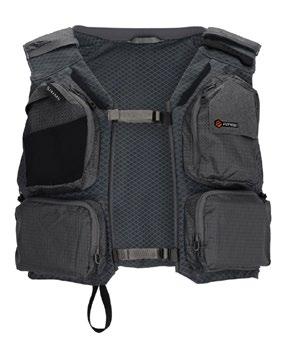
The new Flyweight Vest packs rugged durability and smart fishing-focused features into an unstoppable modern build that is supremely breathable. The features include: Single-entry rear compartment with just enough storage for an extra layer or lunch, two quick-access drop pockets, four zippered pockets and two small stretch mesh pockets, spacer mesh back, side and chest panels provide padding and breathability in warm conditions, dual rear pockets for stowing water bottles or extra tackle, and much more. European dealer: www.flyfisheurope.com/simms/
Fisheries biologist Paul Vecsei and aquaculture specialist Martin Hochleithner are both internationally known experts in the field of salmonid research and culture. In this book, they cover all members of the trout and salmon genus (Salmo) in detail. The book showcases the numerous taxa (species, varieties, morphs, forms, etc.) and highlights their plasticity. Each species’ chapter includes informative text: classification, description, distribution, biology, conservation and references.


Fly Men Fishing Co
CHOCKLETT’S MINI
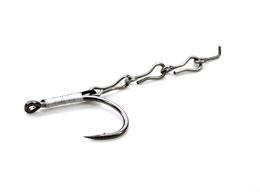

The Minnow Changer #2 is a highly articulated, realistic small scale baitfish streamer perfect for targeting many freshwater and saltwater gamefish species from trout to tarpon. It can be used interchangeably with its big brother, the Minnow Changer 2/0 and the smaller brother Minnow Changer #6 based on the fishing situation at hand. This Fly Tying Kit contains everything you need to tie 6 Minnow Changer #2 flies, including basic step-by-step tying instructions. For more info: www.flymenfishingcompany.com
The Saltwater Revivals are equipped with Vallon’s exceptionally clear and polarized V52® optics. The grey-tinted lenses improve color perception and are fully mirror coated to protect against strong sunlight, making them ideal for fishing, boating and sailing. The sustainable frame is made from recycled fishing nets fused into a highly durable and resistant nylon polyamide. Additional features include antiscratch, oil and water-repellent coating, and a rubber nose pad. They come protected in a functional case with a clip-on hook and belt straps. For more info: www.vallon.com
The Streamer Patch™ is the patented, extreme access, double-sided fly patch system especially designed to hold streamers and large terrestrials/dries. Its exposed ribs protect your flies from damage and loss due to rub-offs. Double-sided… it holds a lot of flies within an ergonomic and adaptable form. Flies are held securely in custom micro slit foam and protected from damage or loss by its patented exposed ribs. Attach it to a lanyard, a vest D-ring or a zinger, it’s exceptionally easy to use with unparalleled access to secured flies. It’s designed to be worn on vests or clothing, chest / sling packs. A stainless-steel attachment cable is provided. For more info, please refer to: www.smithcreek.co

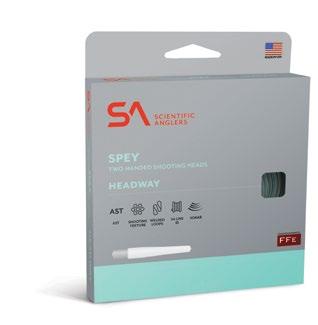
Lightweight, fully submersible 9-liter hip pack keeps gear dry, organized and within easy reach. Made in a Fair Trade Certified™ factory. The pack has a body and webbing made of sturdy 100% recycled nylon. Back panel, shoulder strap and lining are made of 100% recycled polyester. On top of that, the hip pack has an inside organizer pocket and is fully waterproof submersible IPX-7 rated for keeping contents safe even in full immersion. For more info, please visit the following link: www.patagonia.com


The new Headway Single Hand/Switch belly and integrated shooting head system is developed for seatrout & salmon anglers. The tapers are designed to perform equally well for spey and underhand casts as overhead casts with distance and powerful turnovers in mind. Due to the adaptability of the bellies together with the Headway interchangeable tips this is, probably, the most versatile belly/ tip system on the market. This system is fully customizable. Based on skillset, fishing/ river conditions or rod type there is a belly/ ip combination available, whether you’re into “Skagit style”, “Scandi Style” lines or a hybrid version of the two. Interchangeable tips in 5 densities from float to sink 7 ensures versatility in fishing situations. For more info, please check out the website of the European distributor: www.flyfisheurope.com/sa/
Sight-fishing requires laser focus on the slightest indication—that split-second opportunity when you’ll either set the hook or lament over the one that got away. With so much on the line, you need sunglasses that give you every available advantage. Something solid as a rock. Introducing Roca (rock in Spanish), named for the productive Roca Flat near Campeche, Mexico. These are a solid pair of performance shades indeed. Made with tough, bio-based nylon, this modern oversized frame protects eyes with complete coverage and vented side shields, reducing glare off the water and overall light intrusion without fogging up. For enhanced clarity and acuity, the colorenhancing polarized lenses feature Bajío’s blue light-blocking LAPIS™ technology that minimizes eye-fatigue and strain for longer, more productive days out on the water. For more info: www.flyfisheurope.com/bajio/

Having just returned from the Red Sea, we’ve had the opportunity to test Variva’s Maguro Shock Leader for giant trevally. Fishing over craggy corals, this leader material proved extremely sturdy and abrasion resistant. Also, the knotting abilities proved excellent. Even in the 1,04mm 140lb test version that we fished, knots would seat effortlessly – and with a 100lb core Scientific Angler’s Big Water Taper, we could play fish with as much confidence as any GT-fisherman will ever be afforded. For more info, please refer to: www.varivas.fishing
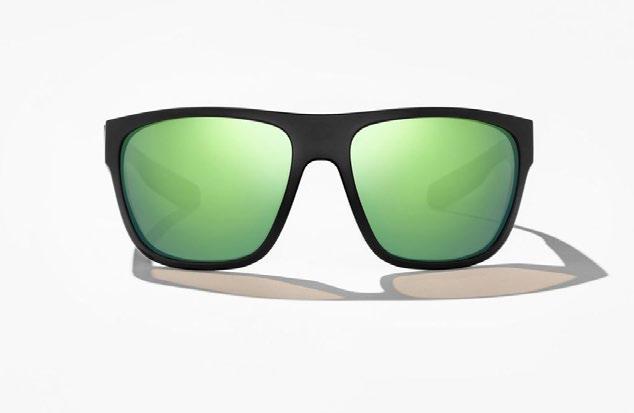




JCC has specialized in producing silicone light protection devices for cameras. They prevent false light from entering the view-finder, LCD display and the lens, and help achieve the perfect, light-true shots while out fishing. For the full range of products, please refer to the distributor’s website: www.kamda.se/jjc-sokare-for-lcd-skarm-universalmodell
We’ve already praised Ryan Johnston’s ‘A Reel Job” in a previous edition. The writing was both witty, reflective and evocative. Now he’s back with a new book called “Reely Unbelievable Fly Fishing Guide Stories”. We’ve thoroughly looked forward to it and we’ve not been disappointed. We’ve all fished with a guide or wondered what it would be like to be one. Well, as it turns out guiding is way more weird, hilarious and – at times – frustrating than most of us realize. “Reely” is one of the most entertaining fly fishing books in recent years, and it may prompt you to immediately look for a job as a fly fishing guide or head out and book one. Or do the exact opposite. No matter what, you won’t regret reading this book. For more info: https://amzn.to/3wU8uCf

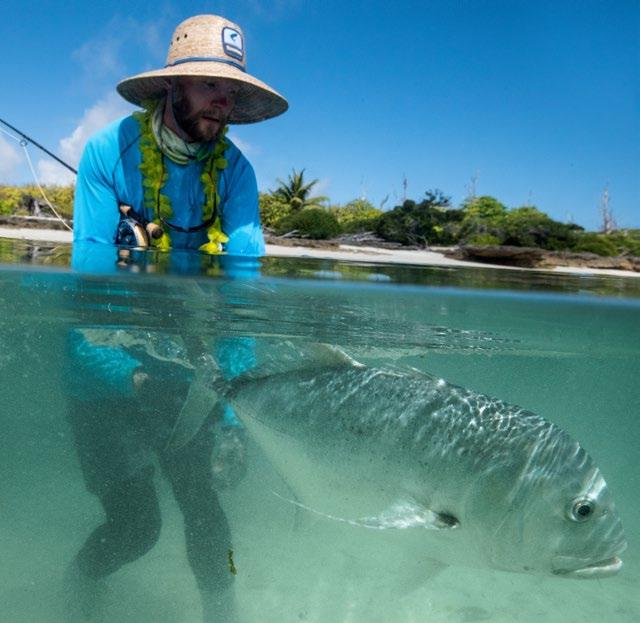
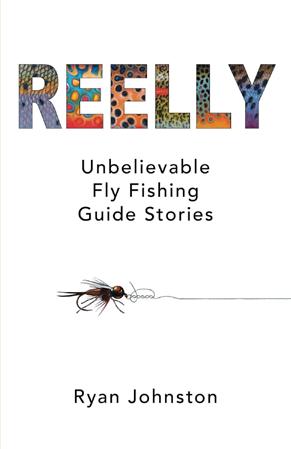

Here’s the world’s first universal underwater water housing for smartphones, action cameras, & 360-degree cameras. Tired of having to upgrade your dome setup every time you get a new phone? Then the new Gdome is the way to go. It can be fitted and set up to accomodate a vast selection of mobile phones and action cameras (iPhone, Samsung, GoPro, Insta360 and other leading brands), and it has a long list of features including: Significantly sharper and clearer underwater images by pushing the camera lens further away from particles in the water, omproved underwater field of view by up to 33%, allows image stabilisation (EIS) algorithms to work underwater, this is a big issue for modern cameras like the GoPro Hero 12 and the Mobile 3 solves this problem, Achieves a depth rating of 10m / 33ft. For more info: https://getgdome.com/products/mobile-3 or visit the European distributor: www.lacameraembarquee.fr

GPS Smart:
The new Huawei Watch Fit 3, with great features for healthand fitness monitoring, is an excellent companion for fly fishing enthusiasts and travellers alike thanks to its impressive GPS capabilities and long-lasting battery life. The watch features a built-in GPS chip that provides accurate location tracking, making it easy to navigate remote fishing spots and keep track of your journey.
Additionally, the Huawei Watch Fit 3’s battery life can last up to 10 days on a single charge with typical use, ensuring that you can enjoy your fly fishing adventures without worrying about running out of power. The watch’s water-resistant design also allows you to wear it while wading in the water or engaging in other water-based activities. On top it has a very comfortable lightweight design and is compatible with both iOS and Android devices. More information at www.consumer.huawei.com



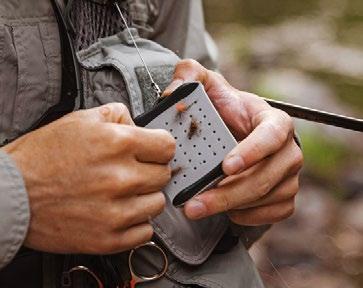
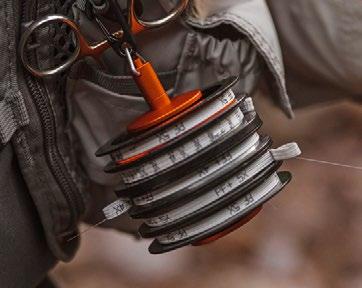




It is truly hard to put into words what it’s like to fish the final frontier. Everything from the landscape to the wildlife is truly breathtaking. My first trip to Alaska would be a three month endeavor guiding at Chelatna Lake Lodge. The lodge is situated on Chelatna Lake just outside of Denali National Park and on the headwaters of Lake Creek. The lake itself is eight miles long, over 2700 acres in size and 460 feet deep. With that being said there are also just under three miles of Lake Creek accessible from the lodge by jet boat. Additionally, there are two smaller feeder creeks to Chelatna Lake itself that can offer tremendous fishing. Fishing in other tributaries to Lake Creek is also accessible by hiking or by aircraft. The species available to the lodge are Northern pike, Arctic grayling, rainbow trout, lake trout, and all five species of pacific salmon native to Alaska.
By JOSEPH CLARK

When it comes to species to target around Chelatna Lake, or even in Alaska in general, it’s hard to beat the beauty of Arctic grayling. At the beginning of the season, they are the most consistent fish to target in Lake Creek. During June and early July, rainbows in Lake Creek are usually harder to come by and are found further downriver. However, Arctic grayling are abundant in the upper Lake Creek during this time.
Early in the season, it seems for every ten fish you catch, eight are grayling. The diet of a grayling mostly consists of aquatic insects, but they can also be caught on streamers or baitfish patterns.
One of the most enjoyable ways to catch grayling is with dry flies. In this area, we have an abundance of caddisflies, but stoneflies, midges, and mayflies are also present. The biggest hatches occur when the clouds break, and the sun starts to warm the tundra. During these hatches, you can find many grayling feeding on the surface.
My go-to setup for fishing these hatches is a 4 – 6-weight rod with a floating line and a 12-foot leader. For flies, I often use tan caddis dry fly patterns in sizes 14 - 16, but I believe that presentation is more important than the specific fly.
“The biggest hatches occur when the clouds break and the sun starts to warm the tundra”
When approaching a group of rising fish, always make longer casts and let the fly drift into them. Consistently casting ten to twenty feet above a feeding grayling will yield greater success.
During periods of cloud cover or rain, which seem to occur most of the summer, grayling can be seen eating emergers. The easiest way to tell the difference between a fish eating emergers and feeding on the surface is by watching their heads.


Typically, when a grayling eats just under the surface, only their dorsal fin breaks the surface. When fish exhibit this behavior, swinging nymphs is the most effective technique. For targeting these fish, indicator rigs with two flies are ideal. The point fly should be a larger pattern such as a size 1012 stonefly, followed by a flashback hare’s ear in olive or tan. With Lake Creek being larger in size, we would anchor the boat twenty to thirty feet above the fish and then swing the flies downstream into them.
As we transition into August, the river undergoes a huge transformation. During this time of year, we tend to catch far more rainbow trout. As the sockeye salmon make their annual spawning run from the Pacific, the rainbows follow closely behind. While there is a lull in the fishing when the salmon first arrive (around the last week of July), what follows is truly amazing. As sockeye stage up to spawn on shallow gravel bars in Lake Creek, the trout will sit just downstream, await-
ing the salmon to drop their roe. This behavior can also be found in the smaller feeder creeks at the north end of Chelatna Lake. This is typically referred to as “The bead bite.” When this type of fishing is in full swing, it can be some of the most hectic and exhilarating trout fishing imaginable.
When targeting trout and the occasional grayling feeding on salmon roe, indicator rigs are a must. This is where the somewhat controversial bead rig comes into play. Essentially, a bead rig is no more than a plastic bead resembling the size and color of salmon eggs pegged on the leader above a hook. While some might not consider this fly fishing, it is the most effective way to catch fish during this time of year.
In my opinion, this is no different from any other “hatch” you might encounter. Due to the abundance of salmon eggs, fish are mostly keying in on them. Rigging is similar to any other indicator rig, with the bead pegged on the tippet three to six inches above the hook.

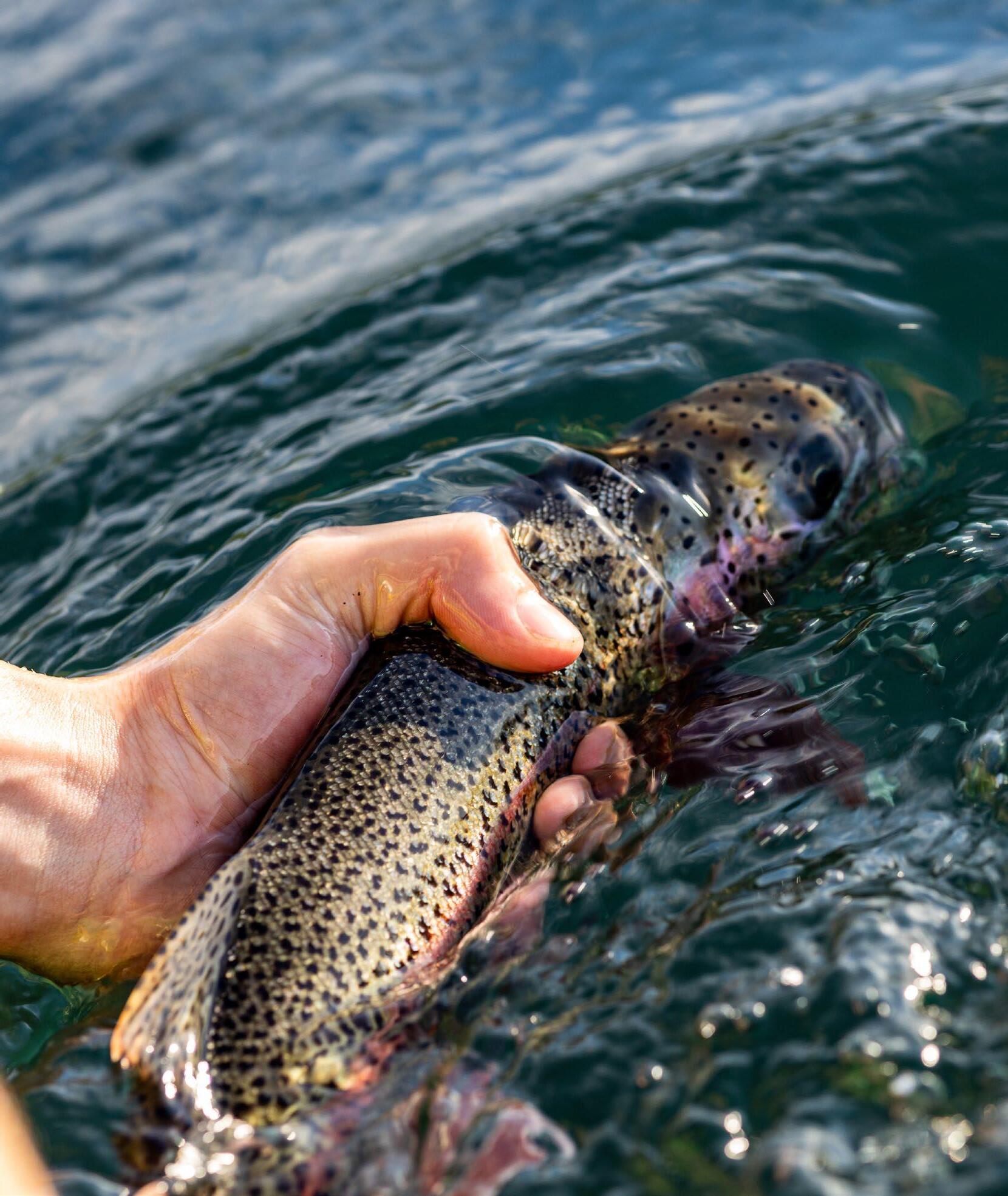





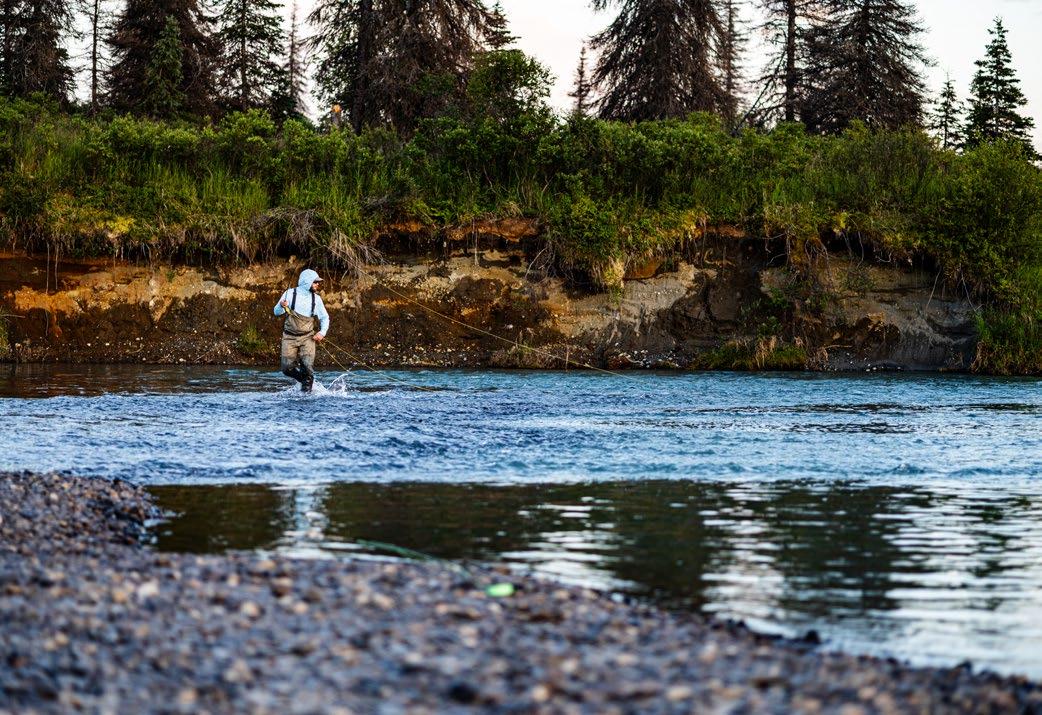

This gap greatly reduces the chance of gut hooking fish, as trout are gorging themselves on salmon roe.
Bead size and color can vary, but six-millimeter beads worked best for me. Color varies depending on the freshness of the eggs. For example, when the sockeye first lay their eggs, they are a bright translucent orange. As the roe spends more time in the river, they turn a more opaque pink or cream color.
For hooks, I prefer barbless curved hooks in sizes 10-12. Leaders are the same as you would use for typical indicator fishing, but you can use slightly heavier tippet to help with fraying, as the bead will slide up and down the tippet while fishing. The bead bite has provided many 30-50 fish days, and on multiple occasions, we have lost trout while fighting them due to other fish eating the bead pegged on the tippet.
While trout and grayling fishing on Lake Creek and its tributaries can offer some amazing days on the water, we also enjoy fishing Chelatna Lake itself. Unfortunately, Chelatna does
not have any Arctic char or a fishable population of Dolly Varden; however, the lake is full of lake trout.
Lake trout are one of the various species of char that the last frontier has to offer and one of the funniest species to target in the lake. Though lake trout at the lodge only average from 15-20 inches, the sheer number of them makes up for the lack in size. With the lake being over 460 feet deep and over 2,700 acres in size, finding these fish might seem like a daunting task. However, just like any other char, they relate to places with current and highly oxygenated water. Any trickle coming off the hillsides into the lake creates great holding water for juvenile salmon and, in turn, lake trout. These “creeks” can often fluctuate greatly with the amount of rain or snowmelt earlier in the season, but we always find fish around them. Generally, when fishing in these situations, using sinking lines is the best approach. Lake trout also congregate around the two deltas at the far north end of the lake, where the two main feeder creeks flow into Chelatna.




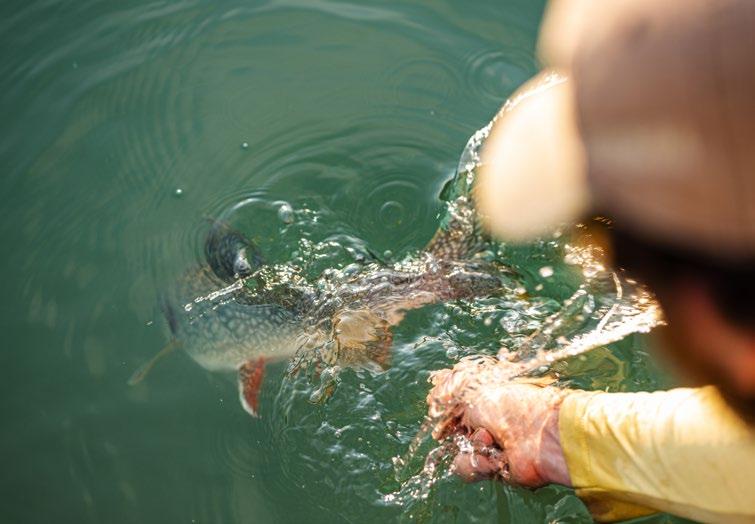



The delta itself is made up of sediment that the creek has deposited into the lake over time. This causes steep drop-offs, and paired with the current flow from the creek, creates tremendous habitat for lake trout.
The other species we target in the lake, and by far the most aggressive, is Northern pike. While invasive, they are one of the most exhilarating fish to catch at the lodge. Nothing beats watching a pike t-bone a big streamer in shallow water.
“The delta itself is made up of sediment that the creek has deposited into the lake over time”
There are times when the fish will push salmon smolt to the surface, and using a slow-sinking intermediate line can be beneficial. However, generally, a 6-weight rod with a full sinking line and a 12lb leader is the ideal setup. For flies, any baitfish flies in sizes 2-6 would work. My favorites are MFC’s sparkle minnow, clousers, Cowen’s Somethin’ Else, and polar fiber minnows. For fly color, olive and gray hues seemed most productive.
Although Chelatna Lake is an incredibly deep reservoir, it still has shallow grassy areas that make ideal pike habitat. The appropriately named “Pike Pond” has by far the highest density of fish, but we also find pike near the outflow of Lake Creek.
Northern pike at the lodge average around 20-25 inches, with some even exceeding 30 inches.
We target these fish by casting along the shallow grass lines and in deeper weed beds.
As far as tackle goes, an 8-weight rod with a floating or slow-sinking intermediate line is ideal. Leader setup varies, but typically a 6 - 8 foot tapered leader with wire tippet is the safest bet.

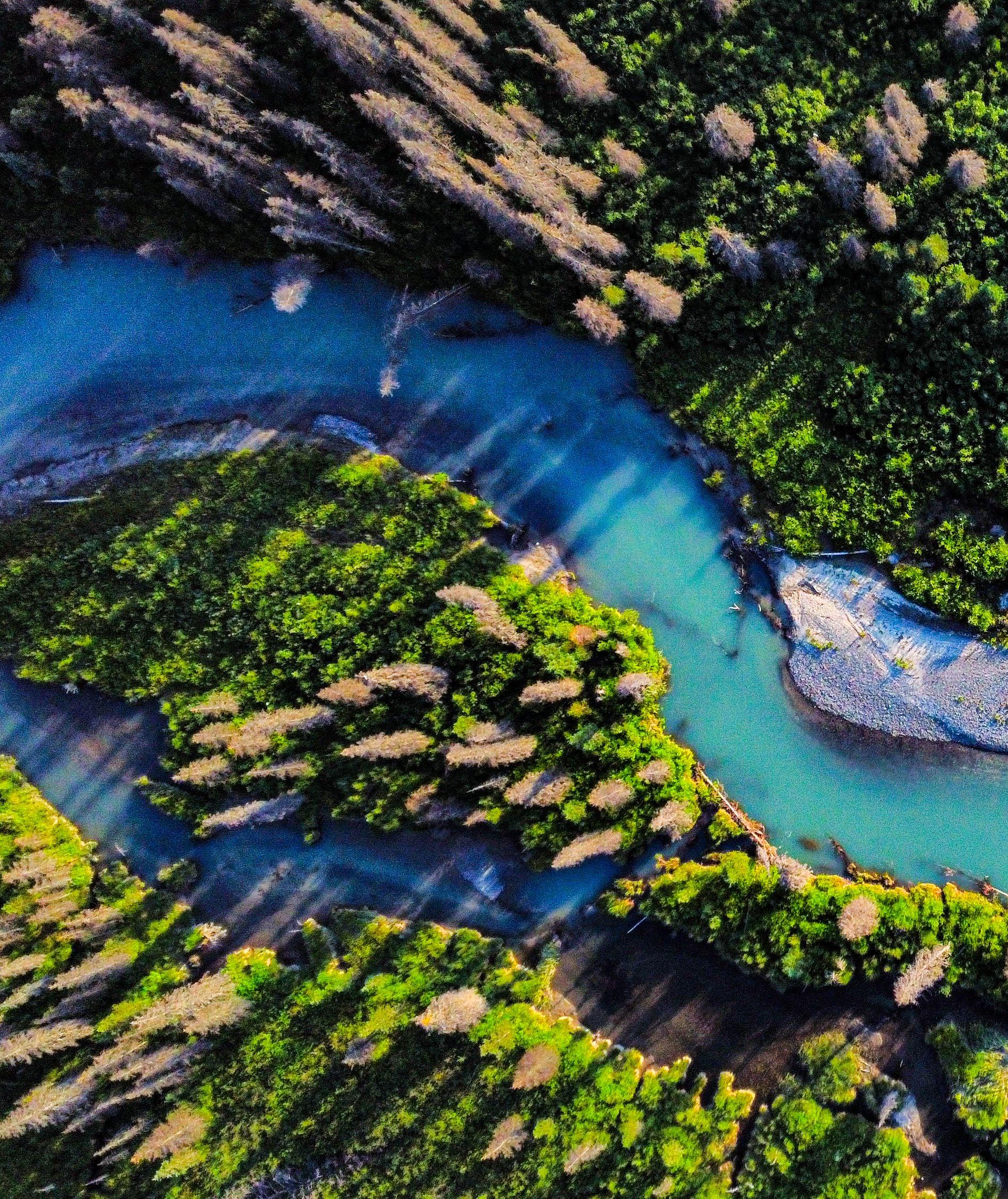
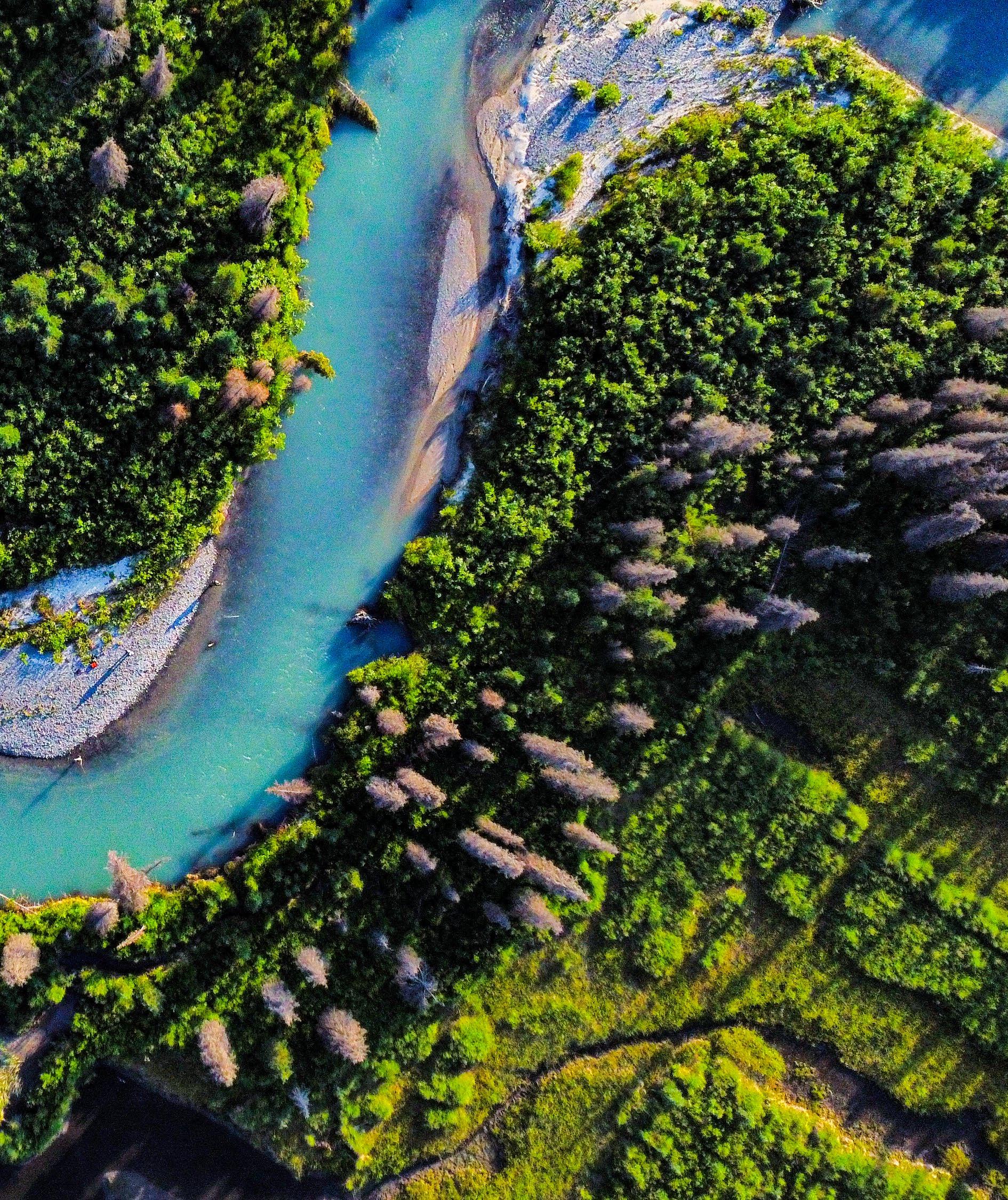


If wire is not available, I’ve found that a straight piece of 40 - 50 lb fluorocarbon works, but constantly checking your leader for frays and burrs is a must. Flies can vary, but with how aggressive pike can be, even tin foil could get the job done. I also would not recommend tying on any fly you care about due to the pike’s toothy nature. Lighter streamer patterns such as Lefty’s Deceiver, bucktail Deceivers, or Game Changers in bright flashy colors work great.
You can also catch these fish on various popper and topwater fly patterns such as baitfish poppers, Pole Dancers, Dahlberg Divers, and even mouse patterns. Topwater fishing for pike can elicit some extremely explosive strikes, but they often miss the fly on the first swipe, so keeping a cool head is often rewarding.
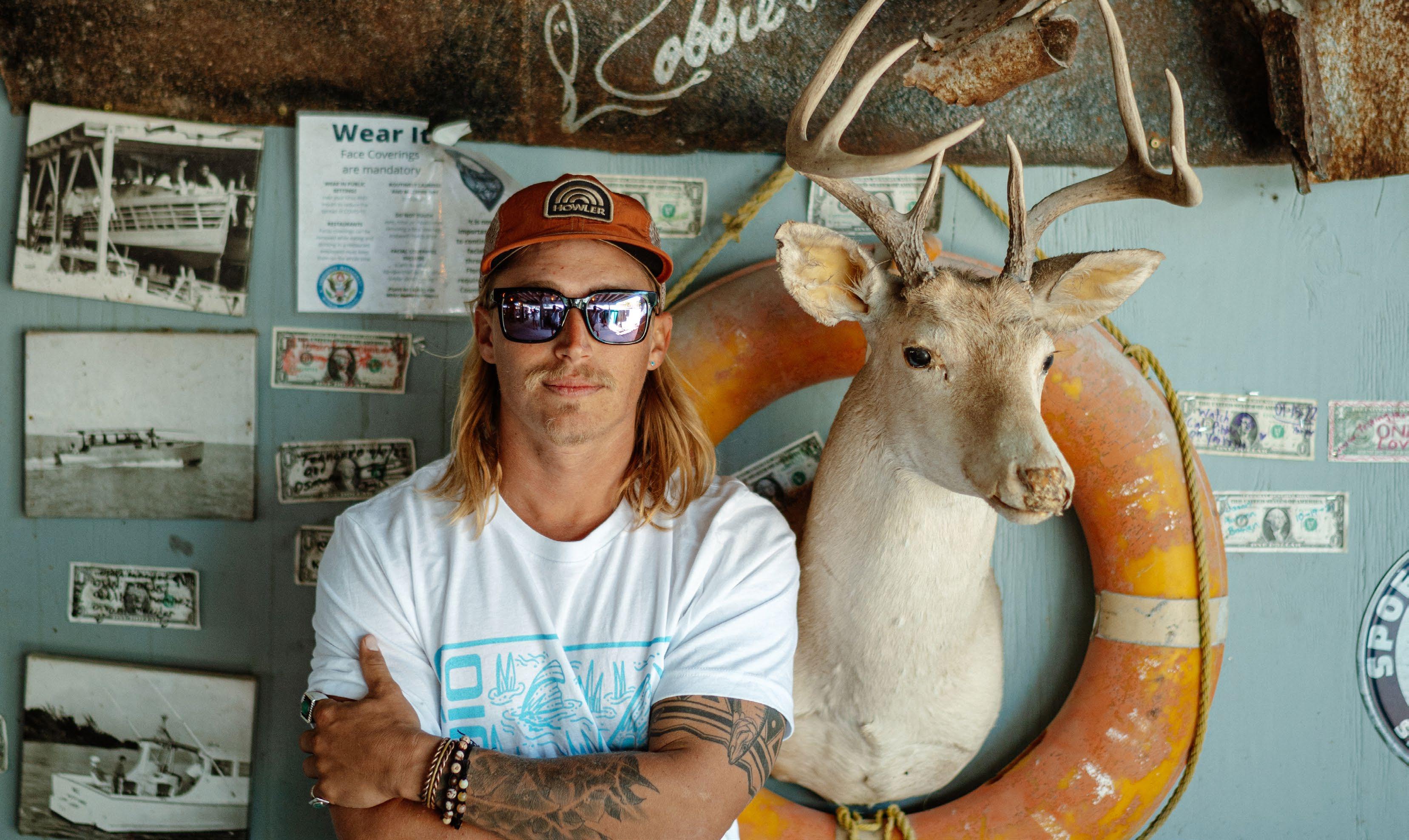

The emergence of the large mayfly, Ephemera Danica, marks a highlight in the trout fishing season for most anglers. Join us as we delve into insights from seasoned dry fly fisherman, John Petermann, as he shares his favorite flies - and a trick or two.
 By PETER LYNGBY
By PETER LYNGBY

The anticipation of encountering the first substantial hatches of the big mayfly ignites the excitement within every fly fisher. Days filled with the spectacle of large, swirling mayflies and trout eagerly rising to feed on the surface. It’s a hatch that entices even the largest and most elusive fish to reveal themselves. However, there are days when the fish prove elusive, or the hatch disappoints.
What then? Which conditions should you seek out, and how should you adapt when the fish prefer other insects?
John Petermann has spent over three decades chasing mayfly hatches in Denmark, and he graciously shares his wealth of experience. Within minutes of conversation, John delves into his vast entomological knowledge, speaking passionately about insects and their life cycles.
Equally passionate about fly tying, John eagerly discusses various techniques available to fly tiers. We’ve asked John to focus on the essentials and recommend stable, reliable flies.
Venturing to the river on the right day to encounter the hatches is crucial, and John gladly provides guidance on what to look for.
“Most of my mayfly fishing is on the Kongeå and Gudenå rivers in Denmark. These two rivers boast the largest mayfly populations in the country, and day tickets are available for both. The hatches typically commence in mid-May and persist until mid-June.
The initial hatches in May offer the best fishing, although the most significant hatches occur in early June. Fish seem less cautious during the early hatches, feeding more freely. However, they tend to grow wary after a few weeks and become more challenging to catch. While I wouldn’t settle for just one trip, if pressed to choose, I’d aim for the last week of May. Yet, timing a good hatch isn’t overly difficult. Keep an eye on the weather forecast for warm days and low barometric pressure, and the insects will emerge. Days when thunder looms, the sky darkens, the wind subsides, and you can almost feel the
electricity in the air—like the calm before the storm—are ideal. While sunny days are pleasant, insect activity tends to be lower, and the fish are usually more cautious,” John advises.
The largest specimens of Ephemera
Danica boast a wingspan of almost 5cm, necessitating a substantial dry fly to convincingly mimic them.
However, John points out that simplicity suffices in most cases.
“There are numerous exquisite and intricate imitations of the large mayfly, many of which feature extended bodies. However, I recommend my Modified French Partridge—a simpler fly crafted to resemble the smaller, slightly darker males of the insect.
A smaller fly is easier to cast and often provides a better hook hold.

Hawthorne fly:
Hook: Ahrex 521, size 10
Thread: Veevus 10/0, black
Legs: Black SpanFlex rubber, small
Abdomen: Twisted black PolyYarn
Wing case: Black foam
Wing: White ParaPost and pearl Crystal Flash
Hackle: Black cock hackle
Thorax: Black SLF Spikey Squirrel dubbing






While a large brown trout has no trouble engulfing a sizable insect or its imitation, not all trout are sizable. In my experience, smaller fish tend to nudge flies with extended bodies away as they rise to them. My Modified French Partridge can be fished as the dun, representing the adult freshly hatched insect resting high on the surface. If the fish are targeting the spinner stage— the dying insect lying flat on the water—I simply trim the underside of the imitation.
My Modified French Partridge serves as my all-round fly and deviates considerably from the original French Partridge. I’ve incorporated CDC into the wing to introduce a touch of mobility. I vary its size and color to match both male and female insects,” John concludes.
From mid-May to mid-June, the mayfly bonanza is not without interruptions, necessitating preparation for alternative scenarios. With a plethora of other insects in the air,
the fish are aware. Despite this, John chooses only a couple of other flies to carry.
“It’s crucial to remember that fish sometimes focus on other hatches, and different stretches of the same river can harbor different species. Smaller mayflies hatch during the same period, resulting in alternate hatches if observed closely. Despite the abundance of insects, fish can be highly selective.
My CDC Upright Spinner can mimic several species, including the darker yellow ones in their spinner stage. A brown spinner imitation covers multiple mayfly species, but I also include a few yellow dun imitations.
I incorporate a few white strands of FluoroFibre into the CDC wing to emulate the reflection seen on natural insects, keeping the wing sparse—a principle often overlooked in many patterns, in my view, making them easier for fly fishers to see but less natural,” John continues.

Hook: Ahrex FW 501, size 10
Thread: Veevus 10/0, brown
Legs: Pheasant tail fibres
Body: FlyRite dubbing, medium brown
Legs: Partridge neck feather
Wing Case: Pheasant tail fibres
Thorax: Hare’s ear or squirrel dubbing

CDC Upright Spinner:
Hook: Ahrex FW 501, size 10-12
Thread: Veevus 10/0, brown
Tail: Coq de Leon hackle fibres
Body: Brown peacock quill, stripped
Wing: Swiss CDC tied Compara-style with a few fibres of white FluoroFibre.
“Another reliable option is my Floating Universal Nymph. It’s suitable when trout are seen bulging on the surface, but their prey remains unseen. During evenings, this often indicates they’re targeting spinners, while during the day, they’re likely picking off hatching nymphs. I refer to it as the Universal Nymph because it mimics several species effectively, whether fished on the surface or just below it. Additionally, I carry a few Hawthorn imitations—a potential game-changer. Sometimes, trout meticulously pick off insects, while occasionally, they make a regular splash. In such instances, Hawthornes are often on the menu. Hawthorn flies are clumsy flyers, and a slight breeze is sufficient to push them onto the surface, where they dangle with their distinctive large legs. Particularly on Kongeåen, I’ve enjoyed successful days with fish rising to Hawthornes.”
For those not accustomed to dry fly fishing, casting the big mayflies on light tackle can pose a challenge.
Despite the recent trend toward lighter tackle, John recommends a 5-wt line without hesitation. He also prefers a line with a medium-length belly, avoiding it being too short. Large flies can twist thin leaders, so John often employs a 0.18mm tippet.
“I’m meticulous about my leaders and always tie my own. This is a longer story, but for beginners, I suggest extending a 9’ leader, opting for one with a 0.23mm tippet and adding approximately 1m of 0.18mm fluorocarbon. This aids in presenting the fly and achieving turnover.
When casting to a fish, try to angle it slightly. Avoid allowing the fish to see the fly line and aim for a drag-free drift. If you don’t entice a rise after two casts, refrain from making additional casts. You may have already spooked the fish, and if not, a third cast risks doing so. If the fish continues to feed on naturals, give it a rest. A well-presented fly that goes ignored suggests you’ve selected the wrong pattern— time to consider a change.
If the fish cease feeding, cease fishing and allow them to rest. Take mental notes of their location and avoid casting to them again until they rise several times more.
If you manage to time your outing correctly, the fishing can be exhilarating and highly productive. Remember to handle trout with care; the population isn’t what it once was, so opt for barbless hooks. They cause less harm and facilitate quicker, easier releases.”
The mayfly was classified by Otto Friedrich Müller in 1764 and named Ephemera danica. Müller, a Danish naturalist, classified over 3000 species of fauna and flora in Scandinavia. The name “mayfly” originated in England, where particularly the southern chalk streams harbor large populations. It is one of the largest mayflies in the world, measuring 6-7cm from head to tail with a wingspan of 5-6cm. While several streams in Denmark have mayfly populations, the largest populations are found in Jutland.
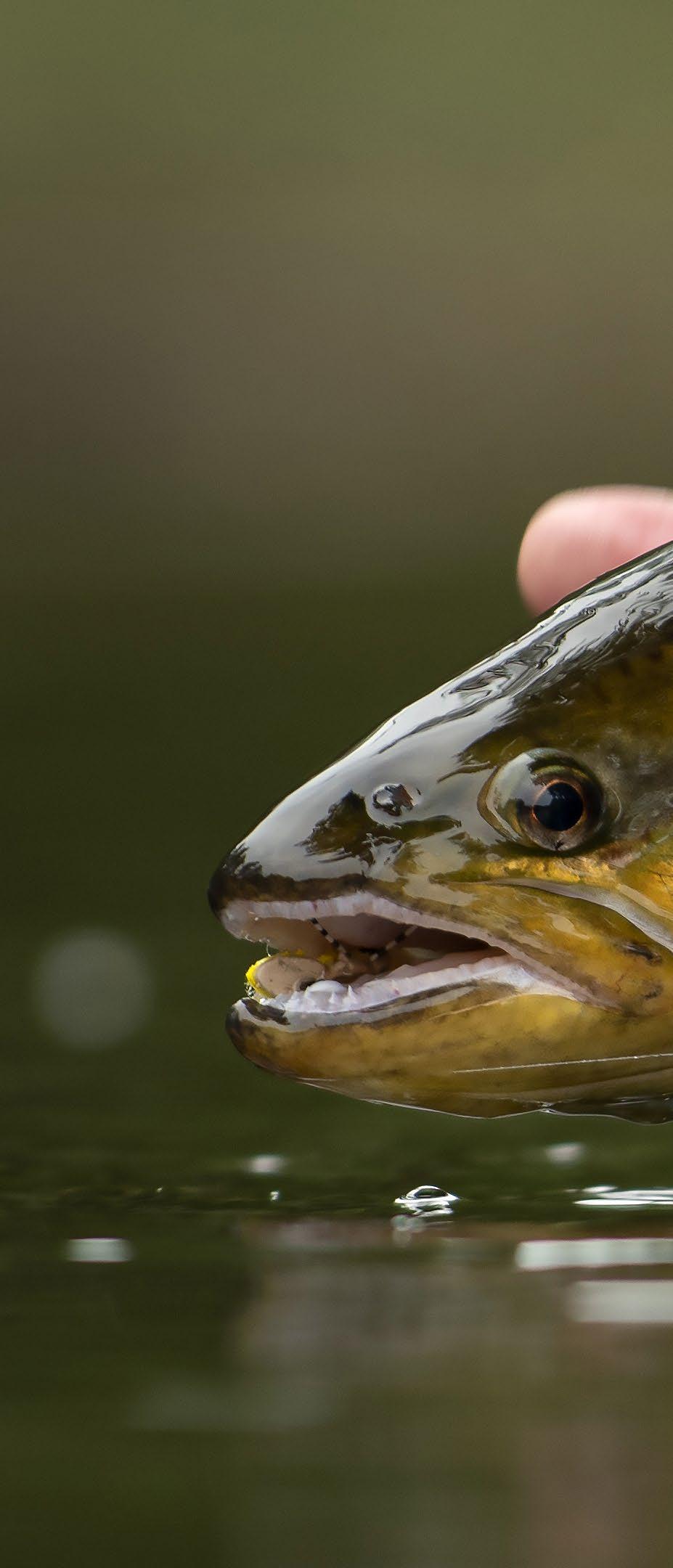
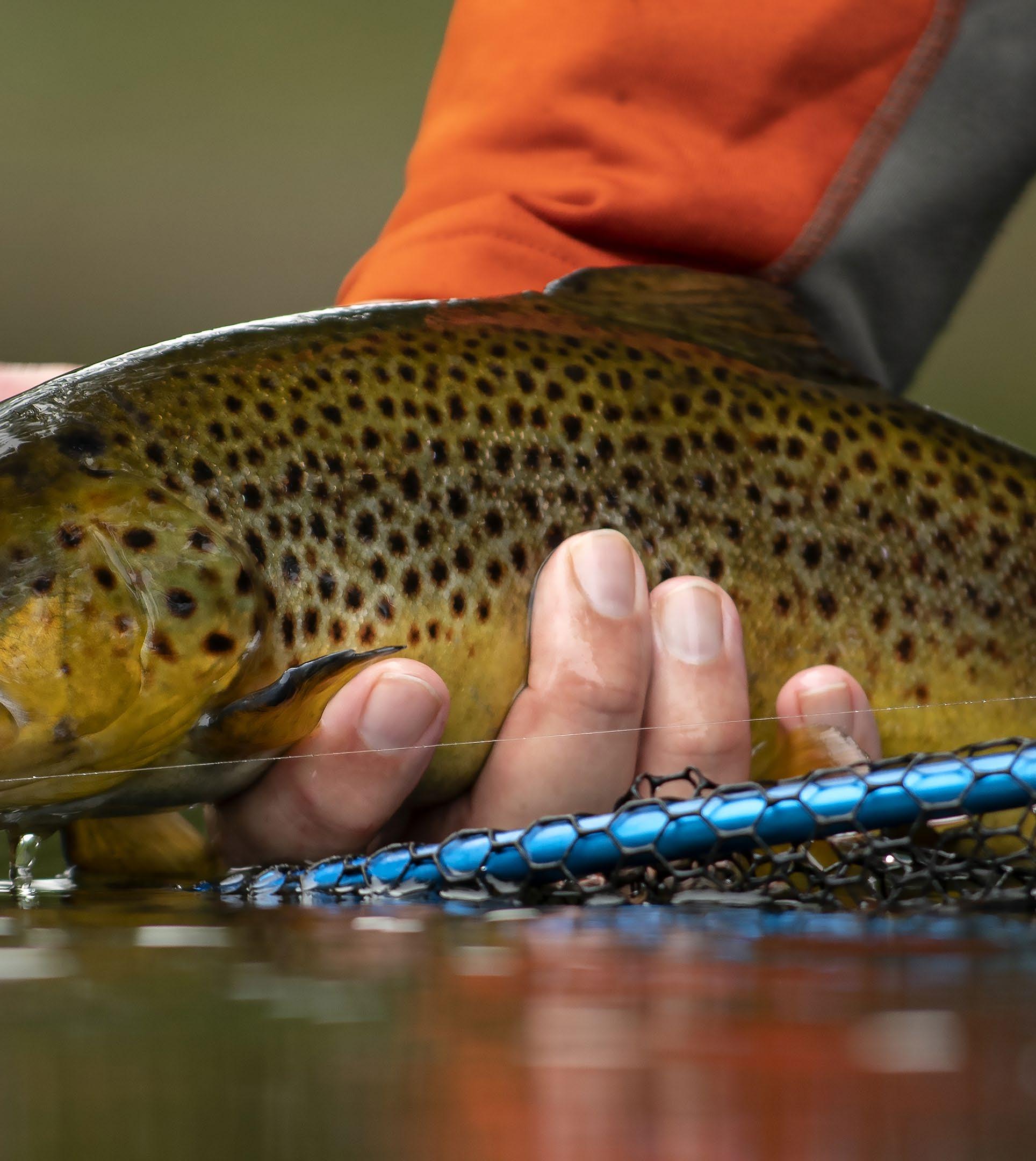

Modified French Partridge:
Hook: Ahrex 571, size 4-8, primarily 6
Thread: Veevus 10/0, brown
Tail: Three fibres from moose mane, natural brown
Body: FlyRite no. 34, Brown Drake
Palmer Hackle: Dark Dun cock hackle
Front hackle 1: Swiss CDC Ultra Select XL, Dark Grey Khaki
Front hackle 2: French partridge, natural

Step 1
Tie in three moose mane fibers, ensuring they fan out evenly.

Step 4
Apply more dubbing and cover the middle third of the hook shank.

Step 2
Dub the rear third of the body.

Step 5
Wind the hackle forwards, ensuring the fibers tilt forwards. 4-5 turns are suitable.

Step 3
Tie in the cock hackle in front of the dubbing.

Step 6
Form a dubbing loop and dub the forward third of the body, leaving some space behind the hook eye. Secure the fibers from the CDC feather in a clamp and transfer them to the dubbing loop.



Step 7 Step 8 Step 9
Spin the loop and wrap the CDC over the dubbed body.
Tie in the French Partridge hackle in front of the CDC.
Wrap the hackle 2-3 times, finish with a knot and a dab of varnish, and you’re done.



Fly tying is a wonderful pastime and in our “Fly Tyer Spotlight” column, we present some of the most talented and innovative fly tyers across Europe and beyond. They are fly tyers worthy of acclaim and attention – and they represent a great source of creative inspiration. Mikael Lindström –an experienced trout and salmon fisherman from the Northern parts of Sweden – is one of them. He has a knack for tying simple yet super-effective flies, especially for finicky trout in rivers.
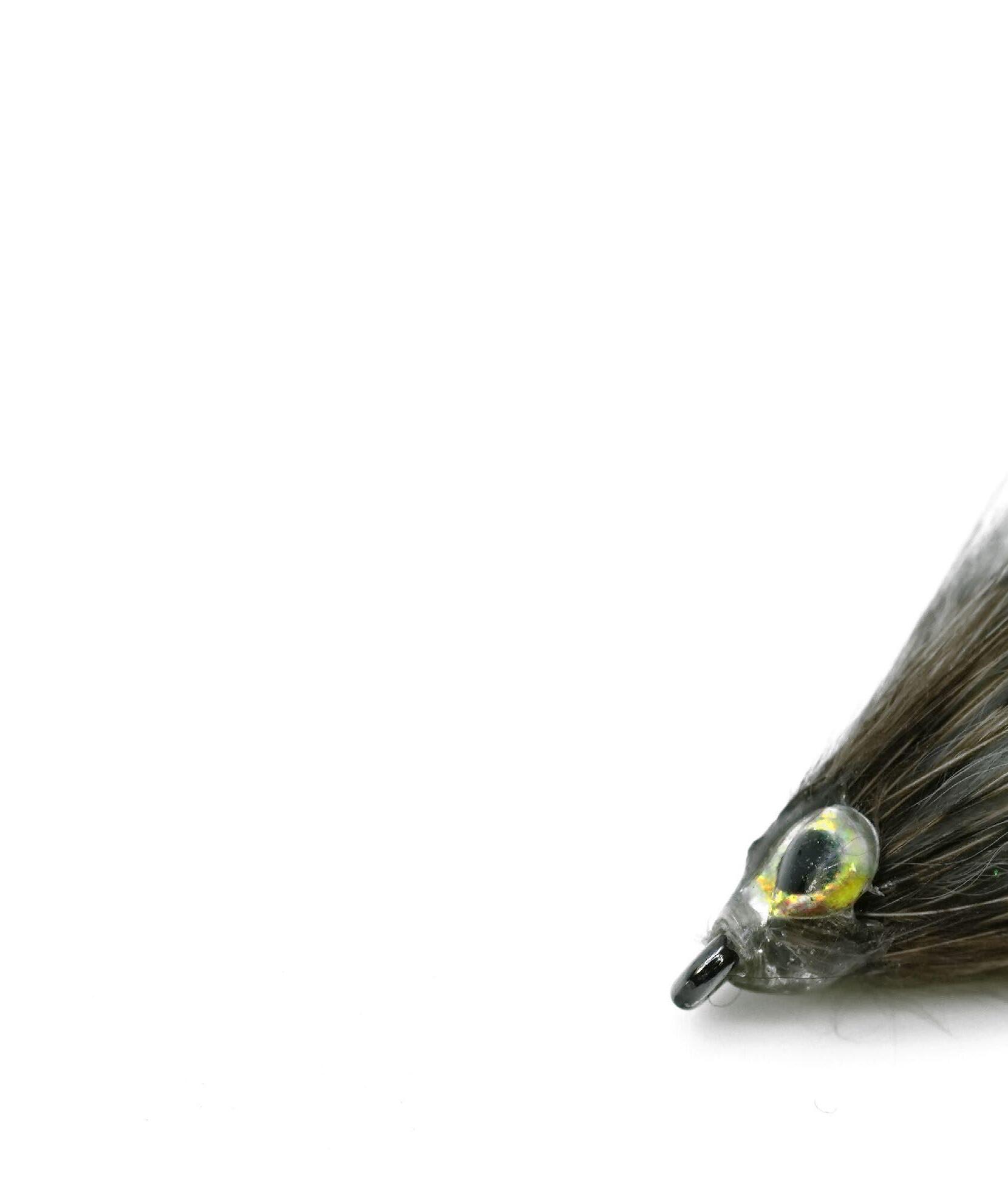 By THE EDITORIAL STAFF
By THE EDITORIAL STAFF
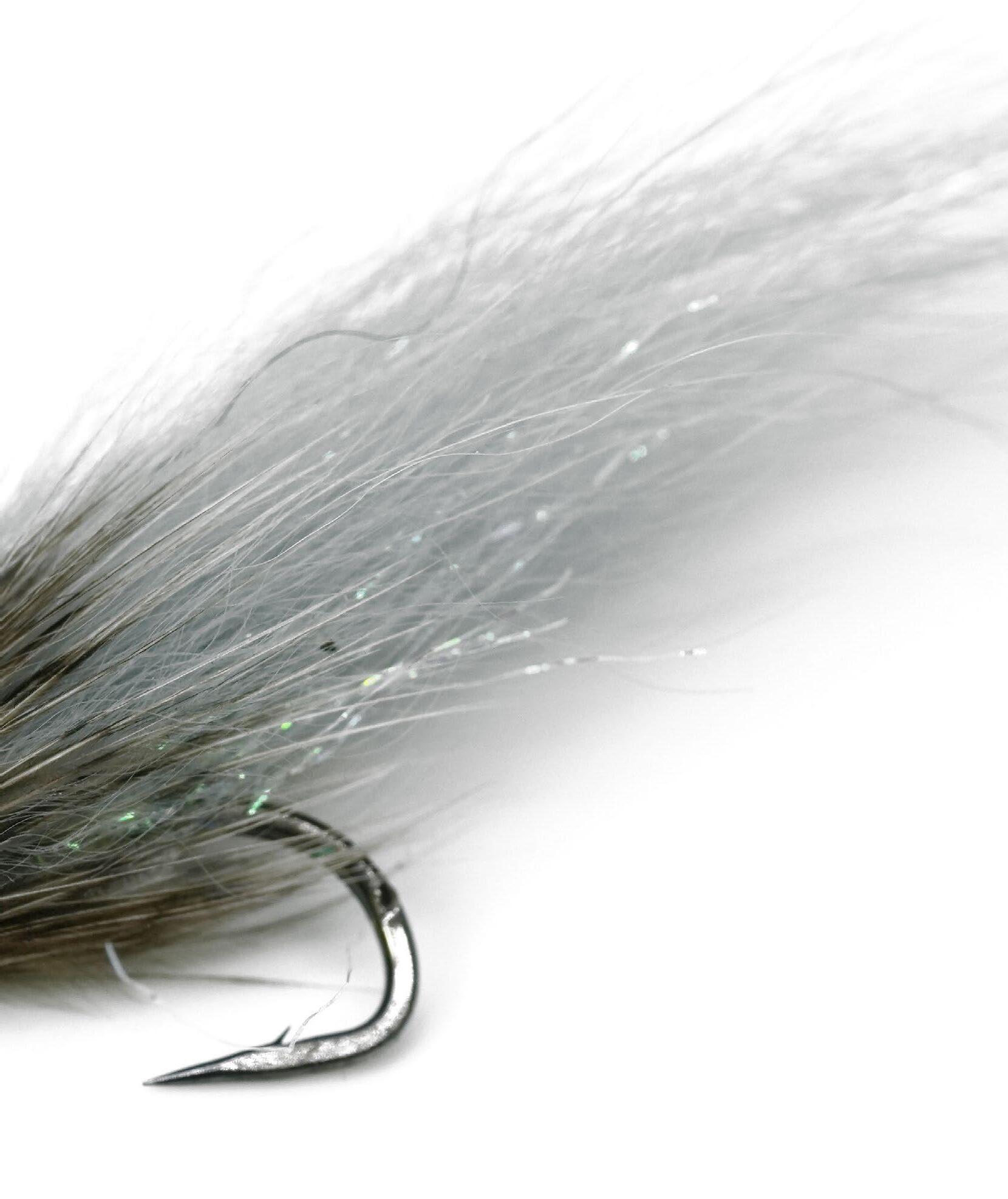

Full name: Mikael Lindström
Born (Year): 1966
Home country: Sweden
SoMe: www.instagram.com/micke_lindstrom_flies

From the tranquil waters of Kvitsleströmmarna in Jämtland to workshops and seminars around the world, Micke Lindström has honed his craft for over 50 years. In this interview, he shares his early inspirations, favorite fly patterns, and the techniques that have shaped his extensive career. Join us as we delve into the passion, skill, and dedication that make him a true artist in the world of fly fishing and tying.
How did you get into fly tying?
I have been fishing with my grandfather since I started to walk. My aunt had a cottage at Kvitsleströmmarna in Jämtland, and I began fishing for grayling with a spinning rod, a plastic float, and three flies. I read everything I could about fly fishing at the library and in the magazines available at the time. I got my first fly rod that midsummer in 1973,
and a neighbor, an older man who was a fly fisherman, had heard of my burning interest in fishing from my parents. He came over and gave me a big box of fly-tying materials and equipment. His eyesight was weakening, and he thought I needed the fly-tying supplies more than he did. I will remember that day for the rest of my life!
What is it about fly tying that you like so much?
From the beginning, I loved tying classic wet flies and dry flies like the Europa-12, Ants, and Goddard’s Caddis. I also started to read a lot about insects and learned more about entomology.
Over the years, my fly-tying became more varied, including pike flies, salmon flies, and seatrout flies.
While tying, I imagined places where I would fish with the fly I was creating, making it a calm and cool place for me. Fly tying became an obsession with positive sides, like meditation.
I had an early favourite baitfish pattern or streamer that I caught bigger trout with. My first big brown trout from Kvitsleströmmarna was caught on an original Muddler Minnow when I was 13 years old, and the trout weighed 6.5 kilos—I think I woke up the whole village! I then started tying the Muddler with white, grey, or black marabou, and later with different skins I found at flea markets or fur shops. I quickly realized that my catches were getting bigger and bigger.
Now, after 50 years of fly tying, my hobby has taken me around the world, leading workshops and writing articles. I have found both business and pleasure in my hobby. I still imagine the places and spots where I will fish the specific fly I’m tying and fly tying remains a meditative experience for me.
What kind of flies do you most en joy tying and why?
I have a big heart for my Zonker flies. Since the 90s, I have cooperat ed with The Fly Company in Den mark, which helped me get differ ent skins for my fly tying. However, every fly pattern has its time. I also enjoy tying Spey flies a lot; I like their appearance and how they look in the water—they just look fishy.
What are the most important fac tors when designing a new fly pat tern?

In my opinion, the right size, colour, and likeness to what the fly should imitate are crucial. For instance, our mayflies in Northern Sweden are a bit darker than those in the south. The main course in Northern Sweden is also caddis and sedge flies. For example, I fished a lot with the Superpuppa in darker shades, but then I changed the ordinary cut hackle to CDC, adding some movement in the “legs.” I noticed that the fish liked it a lot.



Lots of wasps and ants are also flying around during the season. It’s important to learn when the actual insect you are imitating hatches. The movement or lack thereof, along with the presentation using thin leaders and the right knots, is valuable.
What do you look for in a fly for trout and grayling?
First of all, I prefer the “Dry or die” saying for trout and grayling. I want the fly to imitate the actual insects on the water, or at least what insects the fish were eating recently. I think fish have a food memory and need to learn to eat a specific insect or food. And if you want to catch the biggest trout, above 80 centimetres, you need to imitate baitfish.
What’s your favourite fish species to catch and why?
Definitely trout! Big brown trout or seatrout in the rivers is my go-to. I like the trout for the many shades they come in. I believe I have to think more about what I’m doing when fishing for trout, such as casting at
the right angles, choosing the right fly, and using the right equipment. I have a great belief in what I’m doing after so many years of fishing in different waters. The leader and the knots are very important to me.
I use thin fluorocarbon tippets for my dries, as I don’t want any signs on the surface, and a double turle knot so the leader goes into the hook eye and is hidden on the fly head. I prefer small heads on my flies, both hook flies and my tubes. On my tubes, I prefer to balance them with soft tungsten split tubes on the underside to balance for the hook.
If I want a little more weight or colour, I have a box with lined cones in tungsten or brass to put on the leader in front of the fly, with the small head on the tube hidden in the cone while swimming.
Of course, I also do some salmon fishing, but it’s more of hard work. I fish for pike sometimes when I have the time. I’m a fly-only fisherman, and everything counts on fly, but trout is my favourite species.
Do you use flies that require adapted or alternative fishing techniques?
Yes, I like Zonker flies for trout, seatrout, and salmon. I started early with Zonker Matukas made of rabbit, and then I developed my own tying with Zonker strips. By looking for better skins to tie with than rabbit, I found squirrel, red fox, muskrat, American, and Australian opossum. These are the skins I prefer today.
I like to cut my own wings to get the optimal shape depending on the skin and the water I will fish in. Take a simple black tube, a black weight, and a squirrel Zonker wing, and you have a deadly effective fish catcher. For the biggest brown trout, I fish the fly very slowly, letting it hover just under the surface.
What’s your all-time favorite fly and why?
It’s hard to pick just one fly, so I’ll need to list my favourites in a few categories:
When it comes to dry flies, a Wasp I tie with glued black and yellow foam and black CDC for the legs is my favourite.
This is my go-to dry fly for the whole season. I rely on the fish’s food memory, and this fly has helped me a lot, even during the worst mayfly hatches with selective fish. They seem to have a strong taste for the wasp and can hardly resist it.
For brown trout, it would be The Muddler Zonker. I tie it with squirrel zonker, polar fox (for my grey baitfish), muskrat, or Australian opossum, depending on where I’m supposed to fish the actual fly.
A Golden Banana Zonker is my favourite for salmon. It swims better than an Olympic champion. I use Finn raccoon, red fox, muskrat, Australian opossum, and American opossum zonkers for this pattern. In the front, I use bleached and dyed ring-necked pheasant or yellow-dyed capercaillie for a little local touch.







And for seatrout: The Black Doctor Spey, or my black long Sunray zonker with squirrel zonker or Australian opossum. These are mostly tied on tubes.
Are there any specific fly tyers that have influenced and inspired you over the years?
Yes, from the beginning, it was the books of Nils Färnström, Preben Torp Jacobsen, Rolf Smedman, and Hans Lidman. Then I met Lennart Bergqvist, whose articles I had been reading in Flugfiske i Norden and Svenskt Fiske. I liked his thoughts and his skills with fly tying. He also praised my flies when I competed in a fly-tying competition in my early days. I managed to win the Northern Swedish Fly Tying Championships two years in a row, and Lennart was one of the judges.
For salmon flies, Mr. Håkan
Norling has been a major influence. I like his idea of tying the Templedog style with folded wings, which makes more durable flies with soft hair wings. I also appreciate his humble approach and his early ideas around the Scandi-style of tube flies.





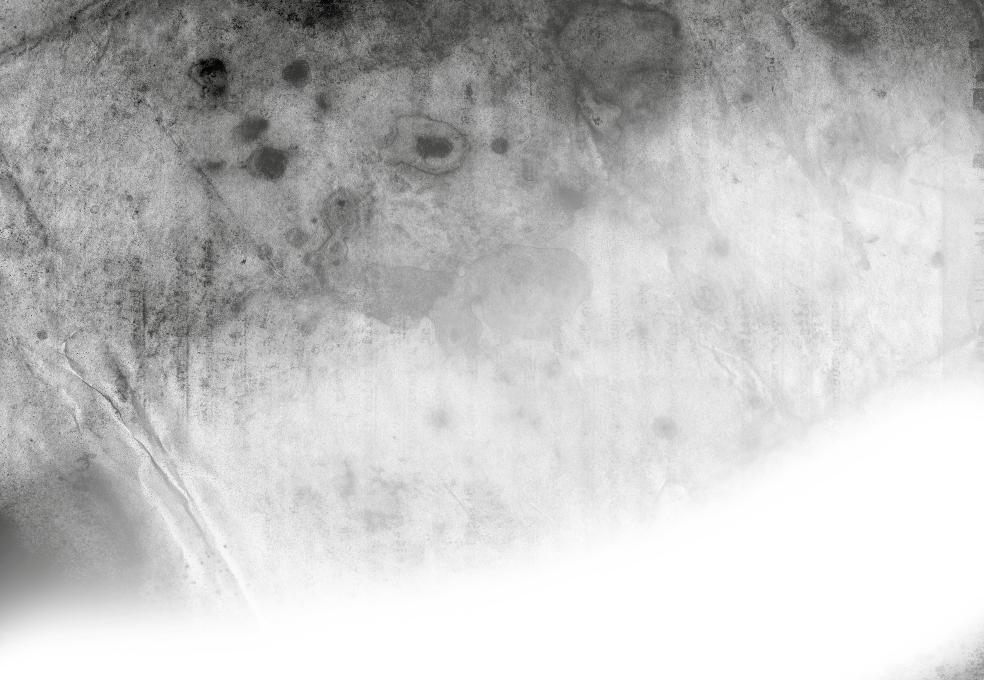

Nobody Likes a Bully. Anyone who says this hasn’t experienced the new Liquid Max, a bully and a beast of a reel. Liquid Max features our Cobalt Drag System: A fully U.S.-made, stop-anything drag system with proprietary Teflon alloy drag cone, Carbon PEEK thrust washers, custom self-lubricating seals and a Certified IPX8 waterproof rating.
We’ve housed this drag in a pressure cast and machined frame and spool, with features that include Ultra Large Arbor, integrated reel foot and pocket spar frame and spool-design that maximizes strength-to-weight ratio. Top it off with a large, easy grip drag knob you have a reel that will change your mind about bullies.


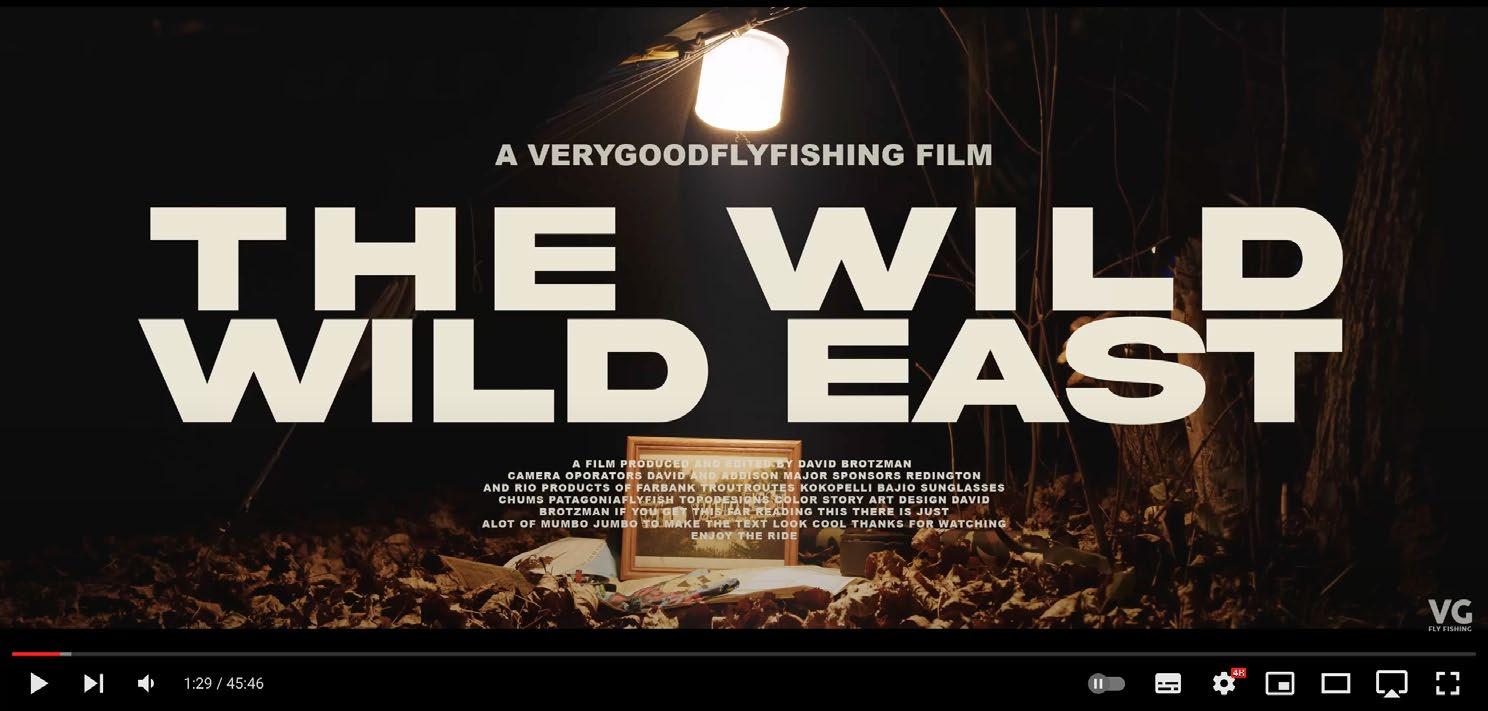
The Wild Wild East is a 45 Min adventure film that takes place in the Adirondack wilderness. Last fall 2023 Addison and I set out to make an epic adventure film comparing streams of the East and West. Utilizing tactics I’ve learned from my travels out west to try and combine the best parts of both. We partnered with some of our favorite companies to bring you an adventure film we are truly proud of
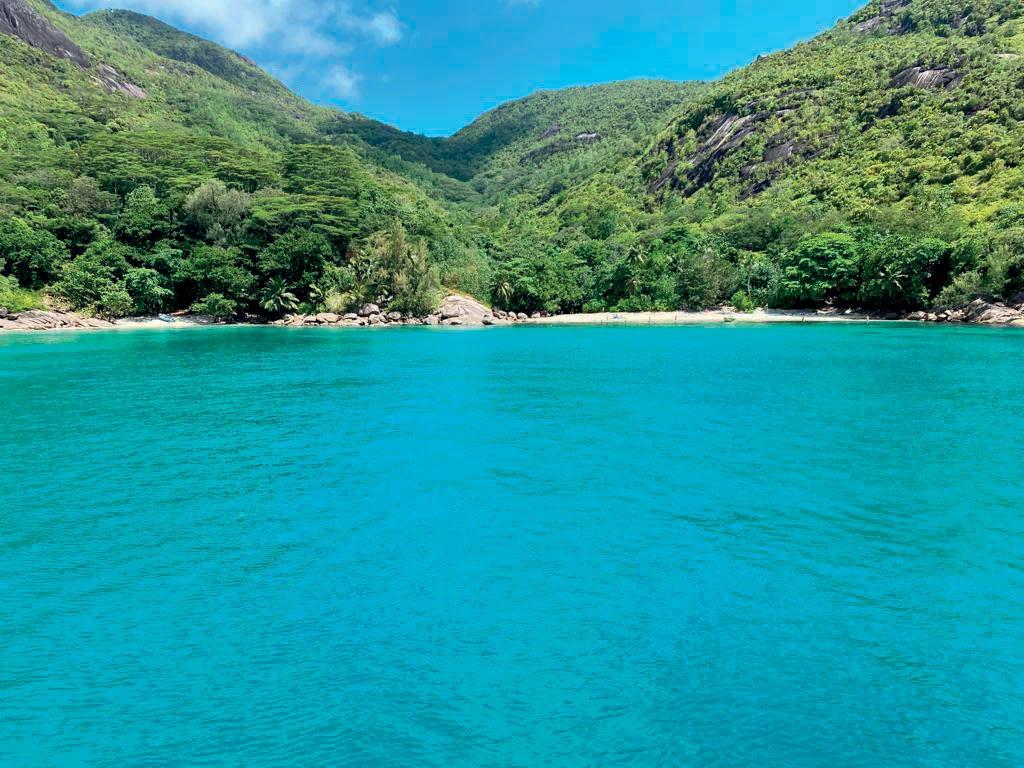



Eden Bleu Hotel
Just 5 minutes from the International and domestic airport!



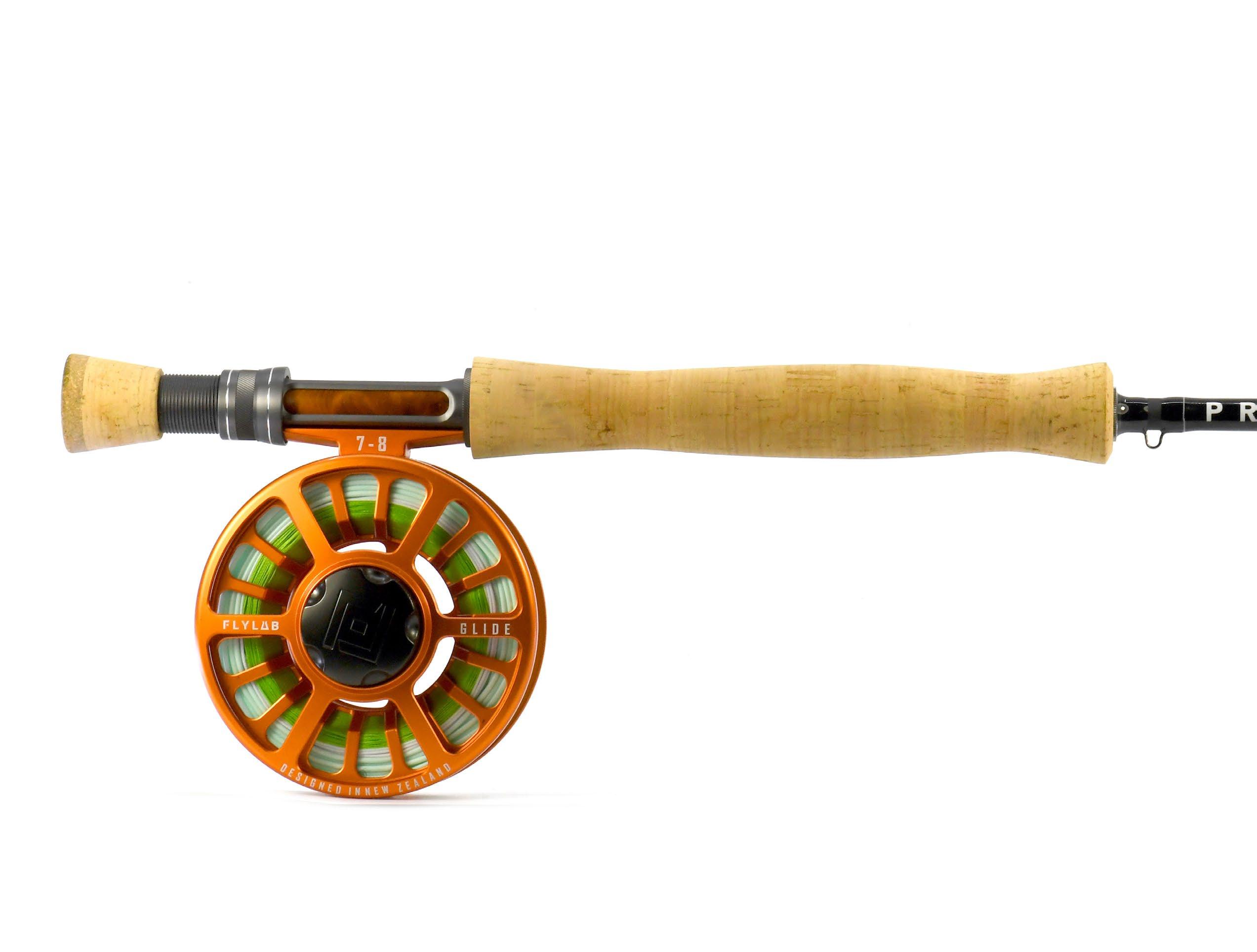






New Zealand by some of the most avid and experienced trout fishermen, Primal Fly Rods and Fly Lab Fly Reels epitomize performance and value for money. More info

Founder and CEO for Bozeman, Montana-based Yellow Dog Flyfishing (www.yellowdogflyfishing.com), Jim Klug began working in the fly fishing industry at the age of 14. Over the years, he has worked as a guide, sales rep, travel coordinator, and as past National Sales Manager for Scientific Anglers. He’s guided extensively in Montana, Colorado, New Mexico and Oregon, and has fished throughout the world in over 60 different countries.
By THE EDITORIAL STAFF Pictures: JIM KLUG


In 1999, Jim founded Yellow Dog – a trip booking and travel company that has grown to become one of the largest and most recognized entities in sporting travel. Yellow Dog currently represents and books more than 250 lodges and outfitting operations in 39 different countries. In 2022, Yellow Dog expanded operations with the acquisition of one of the largest fly shops in Montana, as well as the launch of a full-service e-commerce retail platform.
As Yellow Dog’s CEO, Jim spends a lot of time scouting and researching destinations throughout the world. Aside from his ongoing work with Yellow Dog, Jim is also the co-founder of Confluence Films, a film production company that created the fishing movies DRIFT in 2008, RISE in 2009, CONNECT in 2011, WAYPOINTS in 2013 and PROVIDENCE in 2016. In 2019, Jim launched the popular fishing podcast, WAYPOINTS, a program dedicated to fishing travel, adventure, and exploration.
In 2017, Jim was awarded the American Museum of Fly Fishing’s “Izaak Walton Award,” given out once a year to honor and celebrate individuals who live by the Compleat Angler philosophy. The award recognizes “a passion for the sport of fly fishing and involvement in the angling community that provides inspiration for others and promotes the legacy of leadership for future generations.” In 2018, Jim was the recipient of the “Lefty Kreh Industry Leadership Award,” presented to one individual each year by the American Fly Fishing Trade Association (AFFTA).
Jim’s writings and photos and appeared in numerous magazines and publications, and his photo work and galleries can be viewed at www.klugphotos.com. Fly Fishing Belize (released in October 2014) was Jim’s first full-length book project. Jim lives in Bozeman, Montana with his wife Hilary and children Carson, Finn and Gus.
We’ve been fortunate enough to sit down with Jim for a chat about his life in fly fishing
You’re the founder and director of renowned travel agency, Yellow Dog Fishing. How did Yellow Dog come about?
Well it was a bit of an accident, really, as in the beginning, I never really planned to build or create a booking company at all. Back in the late 90s, I was working as National Sales Manager for the fly line company, Scientific Anglers, which at the time was owned by 3M Corporation. When I took the job, I had to move from Montana to Minnesota, where I quickly found myself working out of a small office in 3M world headquarters – the exact opposite of where I thought fly fishing would take me.
“It’s no coincidence that the most laidback, easy-go-lucky anglers are always the ones that seem to catch the most fish!”
was spending a lot of time down there. People that I knew started asking for advice on the area, and eventually, word spread that I could help people dial in the right location in Belize or line up the right guides. Pretty soon, I was fielding a number of calls and emails, and without even thinking about it was sending more and more people to El Pescador and a handful of other lodges in the country.
Logan eventually sat me down and showed me some numbers, saying, “You need to quit your job at 3M and start running your own booking company.” At that time, however, there were some seriously large bookings agents and companies out there, and I doubted that I could get any traction if I were to jump in with both feet. But … after some serious thought and research, I saw an opportunity to start a new company that offered something different, and the rest – as they say – is history. We’re now entering our 24th year in business, and we’ve grown Yellow Dog from a oneman operation that focused solely on Belize to an operation with 250+ lodges and locations in 39 different countries.
It was a great learning experience, but honestly, I was pretty miserable living and working in the Midwest. For several years at that point, I had been spending a lot of time saltwater fishing – mostly in Belize. A good friend of mine named Logan Gentry has recently purchased the renowned El Pescador Lodge in northern Belize, and I
To many, running a fly fishing travel agency is a dream occupation. Are there any downsides?
How many pages do I have to answer that one? This can for sure be a dream job, but just like anything, if you’re going to be good at it and consistently do it right, it takes a ton of work.


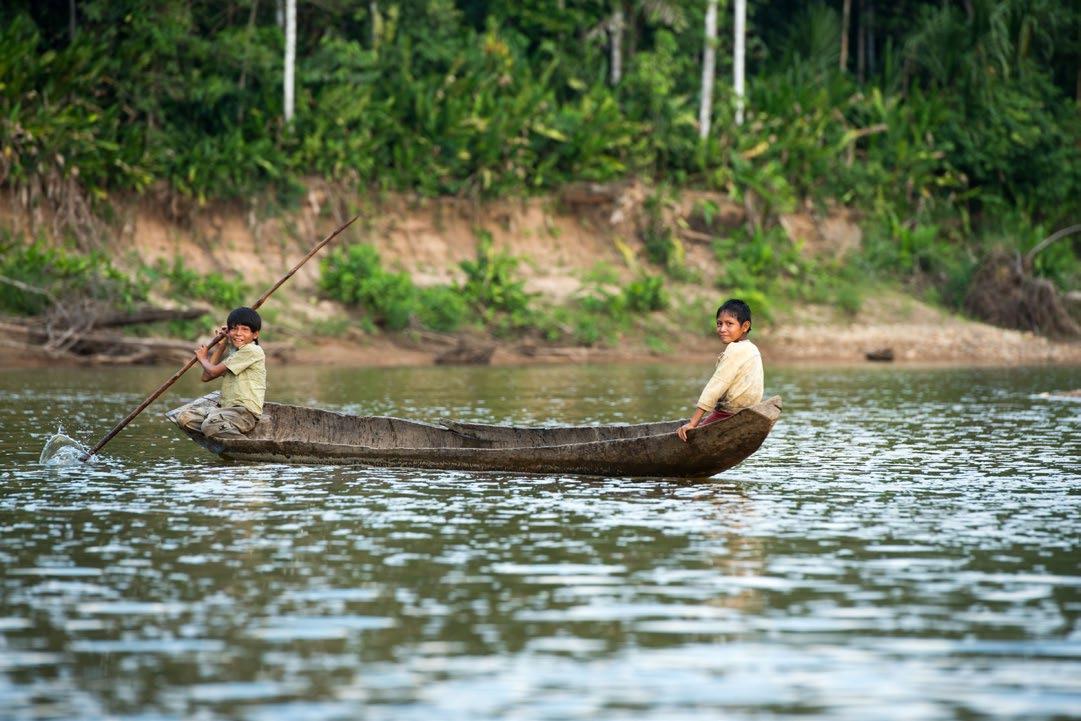







Most booking agencies and fishing travel companies are pretty small and operated by hobbyists – people who love to travel and fish, who hope to book a few trips and maybe score some free fishing and lodge visits. But to be a legitimate agent, you have to provide actual services and solutions for your clients every step of the way – 100% of the time. Because the fact is that great fishing trips don’t just happen by accident. They’re created through detailed planning, a proper amount of research, and – most importantly – by working with the right agent that really knows each product and destination.
When you plan and book a trip, you of course want to be working to with someone who can ensure you end up in the right place, at the right time, with the right gear, equipment, and information. And to be that person takes a lot of work and years of experience.
A far as specific downsides go, the pandemic was obviously the mac daddy of problematic situations for our industry, and it was especially brutal for every company and agency that focused on international travel. Sadly, it put quite a few of the smaller travel players, a number of lodges, and even independent guides out of business. Things bounced back in late 2021, however, and travel has been busier than ever for the past couple of years – something that has now created a “new crop” of booking agents and trip providers who’ve recently arrived on the destination angling scene.


From small fly shops, to hobbyists, to Insta-famous “celebrity trip hosts”, it seems that everyone now wants to be a worldwide expert when it comes to destination angling and travel. Very few of these “new” players were even in business during the dark days of the shutdowns, however, and if they were, many simply locked the door when the shit hit the fan and laid low until the world re-opened and travel once again resumed. So yes – this can be the “dream occupation” when things are easy, the weather is sunny, and the fish are dumb and hungry, but when a customer’s travel plans are disrupted, when a trip has problems outside of normal hours, or when a global pandemic shuts the planet down, you need to work tirelessly – and quickly – to find options and solutions for your customers. That is the difference between the dream and the reality.
What are the main challenges involved with scouting new fly fishing destinations?
The initial challenges – and a lot of the hard work – usually revolves around pre-trip research. These days, you can cut through a good bit of the “noise” and learn a lot about an area, an operation, or a fishery by doing your homework ahead of time. So, when we arrive on location to actually scout and visit a new operation or a potential addition for the Yellow Dog lineup, we’ve already done a lot of research to determine whether or not it will potentially be a fit. And if the visit goes well and matches up with our research and expectations, it usually makes the cut. That said, we don’t ever represent a location or sell a destination until we’ve been there to experience it and fish it ourselves.





You have to know what you’re selling, and you need to have first-hand experience on location. And of course, there have been plenty of scouting trips and research trips that have resulted in us NOT bringing on a lodge or destination, as in the end, it was simply not a fit for our clients for a number of different reasons.
But asking about how we scout a new destination does bring up a great point about first-hand knowledge. When you’re talking with an agent or working with someone who claims to be an expert on an area or a specific destination, always start the conversation by asking, “have you personally been there?” And if the answer is yes, ask “how many times” and “when was your last visit?” Relevant, up-to-date, first-hand knowledge and information is invaluable.
What are you most concerned about when curating a travel product for your customers?
Setting the right expectations has to be the biggest concern these days. I think that every lodge, outfitter, and agent (ourselves included) naturally wants to market a destination and operation by showing it at its “best.” Photos and video of happy clients holding big fish, celebratory moments around the lodge’s dining table, perfect weather, and bluebird days … these are the elements that are ubiquitous in pretty much all desti-
nation marketing and advertising these days. And while there are times at every destination when things are firing on all cylinders and the fishing is amazing, the reality is that fly fishing for ANY species is usually going to be a challenge.
“It’s almost as if bonefish were designed with fly anglers in mind”
We always need to remind ourselves that fly fishing – in general – is not easy. Regardless of how much money or time we may spend planning a trip, nothing is guaranteed when it comes to hooking and landing fish. Most of the gamefish that we as anglers choose to pursue when traveling to fish are by nature spooky, hyper-alert, and wary. Fooling these fish into eating a small piece of metal covered with chicken feathers and belly-button lint is always hard – even on the best of days.
Setting proper expectations is always key when we work with our customers, and we always try to remind clients that destination travel is about so much more than just the fishing. When you take time to remember where you are and why you’re there, you can’t help but enjoy your trip – regardless of the size or number of fish caught.


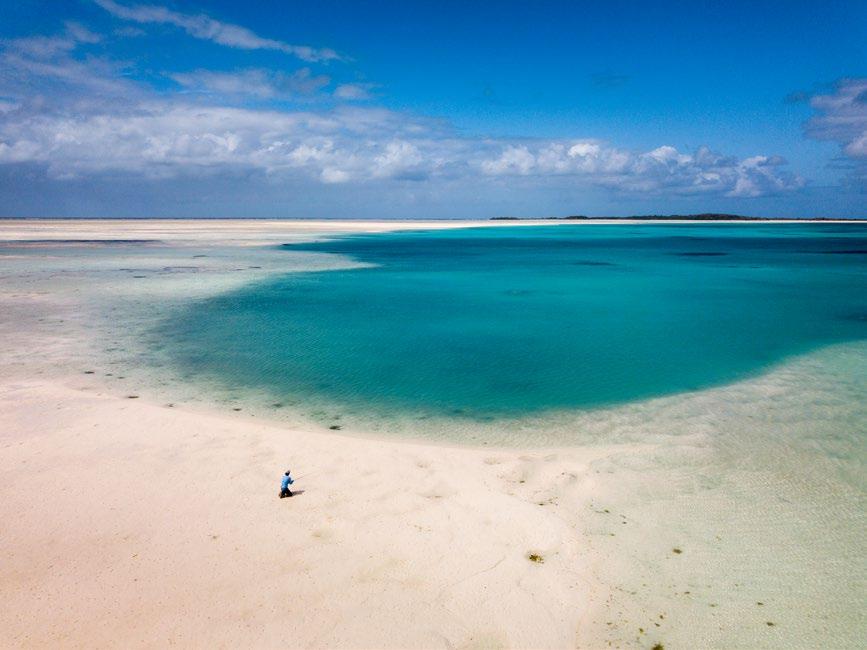





What are your ambitions for the future?
As we continue to build our company and send more people out into the world to chase fish and experience new places, I really want to see our customers more engaged in the places they’re visiting and with issues that really matter to our sport. To that end, we launched a non-profit project several years ago called the Yellow Dog Community and Conservation Foundation (YDCCF). Since its inception, YDCCF has helped give back to key angling communities and fisheries throughout the world by funding numerous conservation efforts and grassroots, locally driven projects.
To date, the Foundation has invested more than $1.5 million to help preserve, protect, and enhance the fishing communities that matter to traveling anglers, and our platform provides these same anglers a way to donate directly to the areas and fisheries they visit and connect with. And these communities need more help than they’re currently getting from the normal influx of traveling anglers. For them to overcome the threats and challenges they face, it takes investment by those who profit from utilizing their resources as well as those that visit and fish their waters.
Any cool trips or projects coming up?
Always! The biggest project that I am currently dealing with right now is the continued integration of the new fly shop and retail e-comm platform that we acquired and launched in early 2023.
Yellow Dog purchased one of the most established and successful fly shops in the Northern Rockies last year, which gave us immediate access to every top brand in fly fishing. We now have the ability to offer our customers and clients (as well as any traveling angler looking to source the right gear) the most relevant equipment and fly solutions for the world of fishing travel. The right inventory, on-hand and in stock at all times.
Moving forward, we’ll not only be able to book and arrange the best adventures in the world, but we can also outfit anglers with exactly what they need for success on the water – no matter where they are fishing or traveling.
People can read more about the Foundation, the work we’ve supported, and how to get involved at www.ydccf.org
As for new travel offerings, we’re continuing to add new destinations in Europe and Africa, and we have some exciting new things we’re working on in South America. On a personal level, I have a remote atoll trip that I’ve been planning for the past several years that may actually come to fruition in 2024 –if we can actually secure the permit and permissions.


Any advice for readers who would like to carve out a niche for themselves in the fly fishing industry?
Well … you have to decide if this is a short-term hobby or phase, or if this is something that you really want to pursue as a career. And if it is the latter, then you need to be very realistic about what a career in fly fishing can provide.
“A career in this industry can be tough”
On the plus side, you usually work with and deal with amazing people who are friendly, fun, and who share your love for wild places, healthy waters, and beautiful fish. It is a great profession if lifestyle matters more than income or if you value travel and time on the water more than a big paycheck. The realities, however, is that a career in this industry can be tough. First off, when you make your passion your profession, it inevitably changes your relationship to that activity. Secondly, there are few high-paying jobs in fly fishing, and the reality is that many are seasonal. You need to decide if that a factor or not.
When I talk with younger people looking to “break in” to the fly fishing industry, my advice is to start by working retail in a specialty fly shop, and then – as soon as you are ready – guide. Even if you are young and fairly new, you can still find
solid guide opportunities in places like Alaska, South America, and certainly throughout the US West. The best way to learn the ropes and gain experience is to go to work for a solid operation that is willing to train and teach young guides. Once you have guiding experience in your quiver, it will open all sorts of other job opportunities in the fishing and outdoor recreation industries.
In terms of the environment, what has you most concerned you as you’ve traveled the world?
There are honestly a lot of issues that threaten the resources and species that our sport depends on. Population declines of native species, water pollution, habitat degradation, fish farms, and hatchery impacts on native populations, overfishing and increased pressure … the list of threats is long and serious. For me, however, the number one concern I have is the overall health of our oceans.
The amount of plastic that is floating around in the oceans of the world is beyond insane. Today, it is almost impossible to find any beach – any place on the planet – not covered with plastic waste and micro trash. When you travel to the most remote islands and atolls on the planet – to beaches that should be pristine and untouched – you instead find these ecosystems full of plastic water bottles and other non-biodegradable garbage.
It honestly makes you wonder about the future of our planet.
Every major ocean on the world now has one or more massive trash vortexes full of plastic and other marine debris. The Great Pacific Garbage Patch – currently floating around in the North Pacific Ocean – has an estimated size of 1,600,000 square kilometers, which is about three times the size of France. The Atlantic and Indian Oceans also have massive garbage vortexes and plastic patches that are continuing to grow.
Do you have any advice for fellow fly fishermen who would like to make a difference on behalf of the environment and our precious fisheries?
Absolutely. If you really care about this sport and the places that matter to fishing, then you need to get involved and you have to pay attention. Many of us found our way to fishing because time on the water was peaceful, restorative, and usually stressfree. Stepping into the water with a rod in hand has always been something that allows us to unplug, tune-out the noise of life, and connect directly with our surroundings.
The reality for anglers these days, however, is that “tuning out” and finding a peaceful escape is becoming more and more difficult. So much of what we love – the very things that we identify with and are drawn to as anglers – are increasingly threatened and under attack.



If we look down the road and try to envision what the sport of fly fishing and the fisheries we love will look like in 15 or 20 years, the picture is hazy at best.
Amplified threats to public lands. Deregulated extraction industries and the ever-present threat of massive mining projects in crucial ecosystems like Bristol Bay in Alaska and the headwaters of blue-ribbon rivers throughout the US West. The continued decline and loss of angler access. Diminished watershed protections. Rollbacks on regulations designed to protect clean water. Rampant gillnetting in crucial marine ecosystems.
The list of looming and legitimate threats is long and at times overwhelming, and it is hard to make the case that conservation is “winning” right now. For this reason, the days of carefree, detached participation by those that love fishing may sadly be behind us – especially if you’re someone who values a world where your kids and grandkids will be able to find the same type of on-water experiences you’ve enjoyed on your own journey through fly fishing.
I would argue that it’s not enough these days to consider yourself an “engaged” angler just because you own a few rods or occasionally head south to chase bonefish on the flats of Belize or the Bahamas. Fly fishing – and the resources and places our sport depends on – needs a louder voice. And unless we engage and speak up to protect and preserve the things that
matter to our sport – the very foundations of the pursuit we care about – we’re going to find ourselves with limited and severely diminished fishing options in the years ahead. That means we damnedwell better be paying attention and finding new ways to fight for our fish.
But on the positive side, one of the things that has always set anglers apart from other hobbyists, sportsmen, and general recreationalists is the great lengths to which this community will go to pursue game fish and – in turn – protect and enhance the fisheries and wild places where fish live.
In many of the world’s great sportfishing destinations, fishing access and on-water experiences are enjoyed as a direct result of the efforts of those who are working hard to protect and preserve these rights and resources. Our numbers may be relatively small, but our voices can be loud! So … the very long answer to your last question? Fishermen can make a difference by speaking up, voting, volunteering, and by doing business with companies who have a legitimate conservation ethos and action plan.
Talk about and share the issues that matter to you as an angler with friends, family, and other outdoor enthusiasts, and never be afraid to talk about conservation and the important issues linked to angling. There is hope if we are pay attention and stay active!

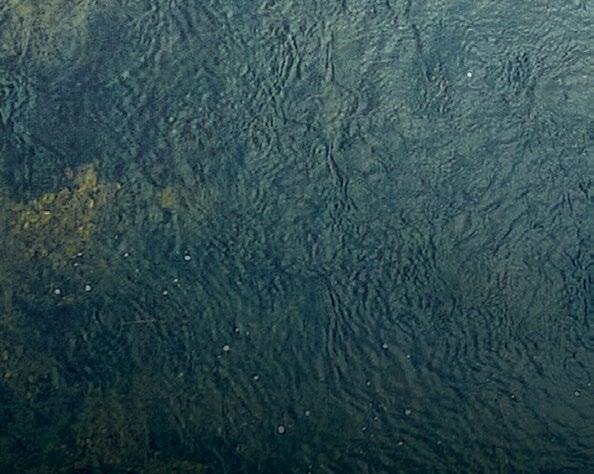










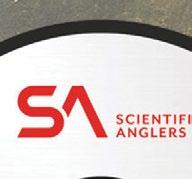





ABSOLUTE TIPPET
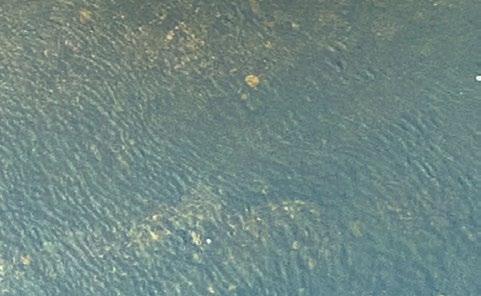

40% stronger UP TO WET-KNOT STRENGTH THAN PREMIUM COMPETITION



Barry Ord Clarke emphasizes the significance of ants in fly fishing, as they often end up on water, sparking feeding frenzies among fish. He recommends having accurate ant imitations due to fish selectivity and introduces a semi-realistic pattern that includes wings, body, legs, and head. Clarke suggests tying black, red, and mixed-color variants to match local ant species, noting that the pattern is effective whether floating or slightly submerged.
By BARRY ORD CLARKE
Generally speaking, ants are probably the most important terrestrial insect for the fly angler, no matter where you fish. They are extremely poor aviators, so they leave the nest in large numbers to increase their chances of establishing a new colony. When they eventually take to the wing, they are placed at the mercy of the wind and end up where it takes them.
If they are unlucky and land on water, especially in large numbers, the fish go into a feeding frenzy. In extreme situations I have experienced that the trout will take just about any fly that is presented to them. But other times they can be so selective that they will only take the perfect pattern with the right silhouette, colour and size. Therefore, its important to have a good imitation at hand.
The Flying Ant is what we call, a semi realistic pattern, that includes the wings, body, legs and head. You can get away with fishing much more simple patterns, but with this one, you also learn several good techniques that you can carry further with you for tying other patterns.
The naturals that you are most likely to encounter when fishing, will be black, but on occasions can also be red, so here are two other variants of this pattern that may be worth you tying, depending on how prevalent ants are for your own fishing!
Both are exactly the same pattern as this, but with a slight change in colour. The first, all in red, including the wings. The second is one that I have increasing success with, is with a red rear body and a black head, simply a mixture of both.
This pattern will float well, especially if treated with a fly floatant. But if your ant sinks a little when fishing, don’t take concern, because they swim as well as they fly.
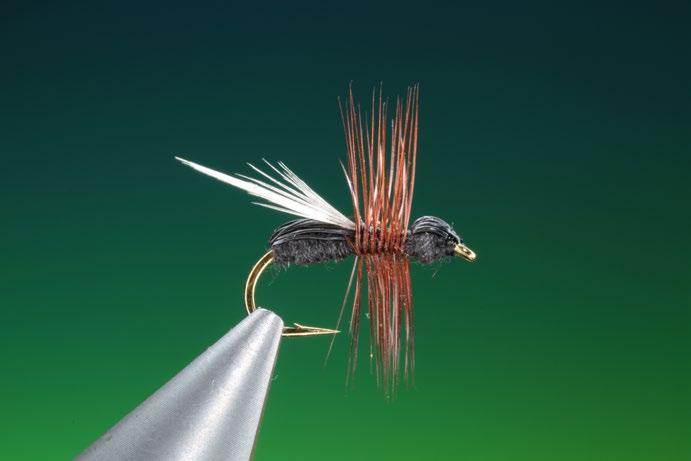
Material List//
Hook: Mustad dry fly hook size 12-16
Thread: Sheer 14/0 black
Body: Super Fine dubbing black, polypropylene or black deer hair

Step 1
Secure your dry fly hook in the vice, as shown, with the hook shank horizontal.

Step 4
Cut a short length of black deer hair (or Polypropylene yarn) and tie this in at the rear of the hook.
Wings: Dun cock hackle tips
Hackle: Brown saddle hackle
Head: Super Fine dubbing black, polypropylene or black deer hair

Step 2
Load your bobbin holder with a black tying thread.

Step 3
Attach your tying thread and run a foundation over the centre hook shank, until the thread hangs approximately vertically with the hook barb.

Step 5
You will now need a little black super fine dubbing.

Step 6
Spin a little black dubbing a little at a time onto your tying thread. Take your time and spin the dubbing nice and tight. Wrap the dubbing, starting a little down into the hook bend. Both the body and the head of the ant should be constructed of a very tight hard ball of dubbing.

Step 7
Once you are happy with the dubbed body, take hold of the deer hair (or Polypropylene yarn) and fold it over the body as shown and tie down. Take care that the fibres in the yarn are parallel and tight.

Step 10
Once the wings are correct, trim off the surplus hackle stems, so they don’t quite reach to the hook eye. Tie down the stems along the hooks shank, stopping with your tying thread a little behind the hook eye. Leaving enough room for the head.

Step 13
Attach a hackle plier to your hackle tip and wrap your hackle in neat touching turns forward to your tying thread. Secure the hackle with a couple of turns of tying thread and cut away and surplus hackle.

Step 8
Select two small dun hackles of the same size for the wings. Prepare them by stripping off the fibres at the base of the hackle stem.

Step 11
Tie in a brown hackle by the stem with an X tie, so the hackle stands approximately 90 degrees from the hook shank.

Step 14
Now fold the deer hair (or Polypropylene yarn) nice and flat over the head of the ant and secure with just a few wraps of tying thread. Once it is in position, nice and tight, trim away the surplus yarn and form a small neat head with tying thread. Make one or two whip finishes.

Step 9
Wrap your tying thread back tight into the rear body, and tie in the first wing with a couple of turns of tying thread. You can now adjust the wing so it lies correctly, by pulling on the hackle stem. Repeat the last step for the second wing. Take care that they are balanced and the correct length, one each side of the rear body.

Step 12
Fold back the deer hair (or Polypropylene yarn) and spin a tiny amount of black dubbing on your tying thread. Wrap the dubbing, again nice and tight to form the head of the ant. Take care not to crowd the hook eye, you should finish a couple of mm behind the eye.

Remove your tying thread and give the whippings a little drop of varnish, taking care not to get any on the dubbed head. Step 15

Step 16

Step 17
If you would like your fly to have a little lower profile, so it fishes deeper in the surface film of the water, you can carefully trim away the hackle fibres on the underside of the hook as here. This can on occasions give a better and more acceptable presentation for the trout.

Step 18
The finished flying ant. A birds eye view of the finished flying ant.

Session rods are high-performance hand-crafted fly rods that blend some of our most acclaimed design approaches with our latest materials and technologies.
Scott Fly Rod Company | Handcrafted in Montrose, Colorado



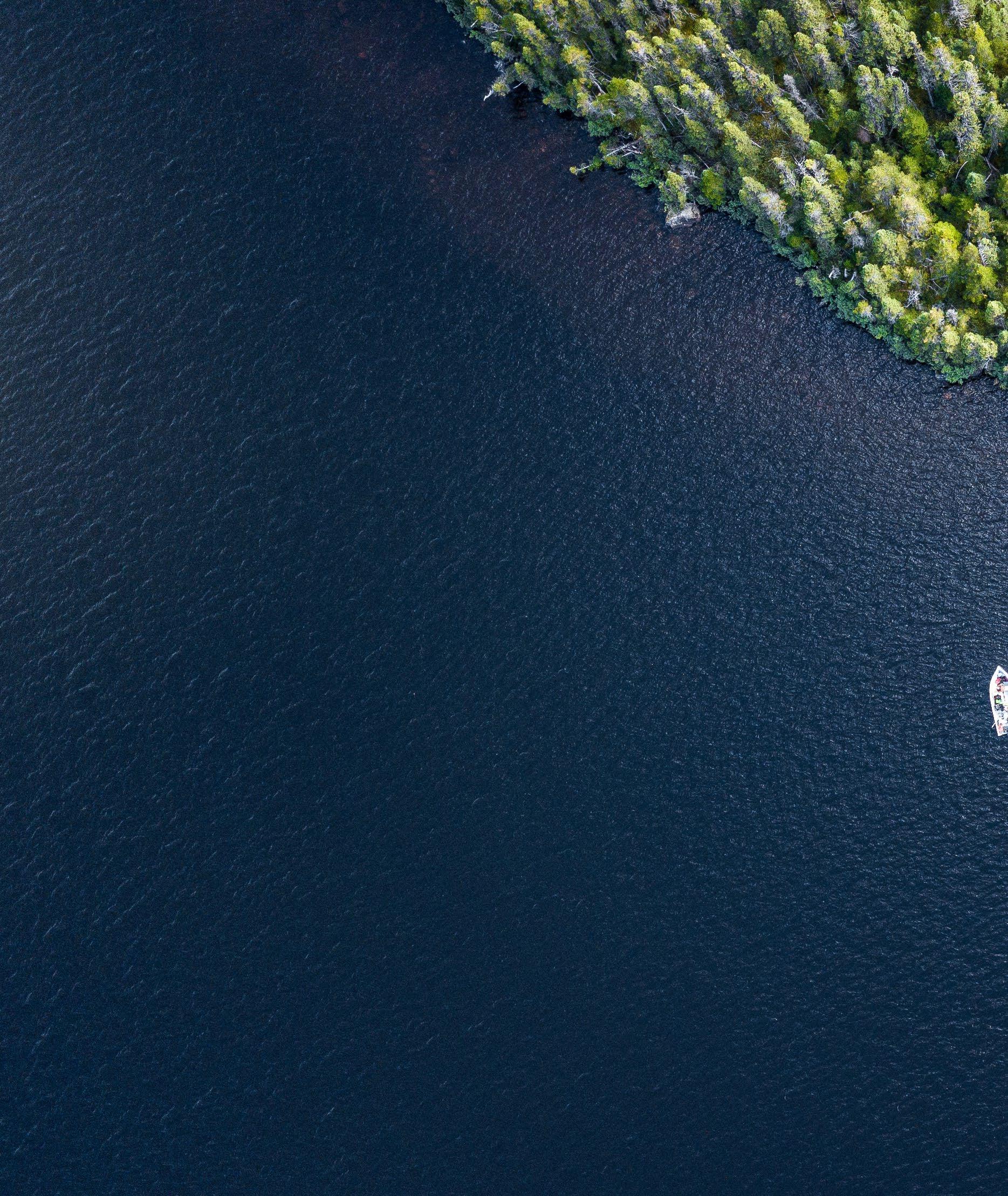






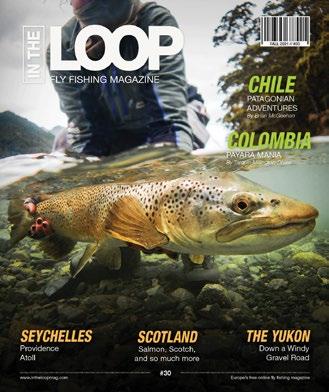




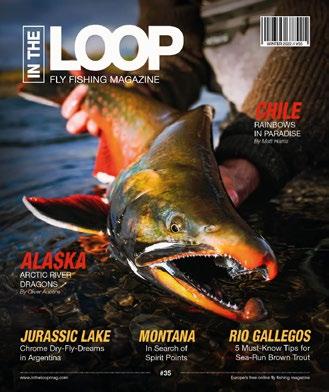


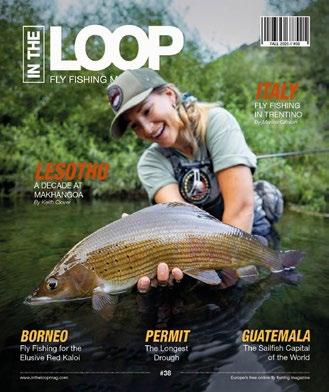

 #25 #26
#13
#28
#29 #30 #31 #13
#33
#34
#35
#36
#37
#38
#39 #40
#25 #26
#13
#28
#29 #30 #31 #13
#33
#34
#35
#36
#37
#38
#39 #40
Join the fight to protect our oceans, lakes, and rivers, the pristine aquatic ecosystems across the globe and thei precious fish stocks. It’s an acutely important battle - and one that we simply cannot afford to lose!
Join the fight to protect our oceans, lakes, and rivers, the pristine aquatic ecosystems across the globe and thei precious fish stocks. It’s an acutely important battle - and one that we simply cannot afford to lose!




















